
Home » Travel Guides » Lithuania » 15 Best Places to Visit in Lithuania

15 Best Places to Visit in Lithuania
The first stop on the Baltic trio has a whole load of must-sees and must-do sites up its sleeve.
Forged by long alliances with Poland to the west, conflicts with Russia and Sweden and the Teutonic Knights, and shaped by Slavic builders and Orthodox faiths to name just some of the influences, it’s hardly surprising that Lithuania has so many interesting places for the budding traveler.
Let’s explore the best places to visit in Lithuania :

The historic capital of the Grand Duchy is a veritable treasure trove of medieval wonders and gorgeous Gothic come Russo-flavoured Baroque architecture.
In the Old Town, cobbled roadways weave under the buttresses of the beautiful St Anne’s Church, over café-spattered plazas and under the soaring Gediminas Keep and Upper Castle citadel dating from the 13th century.
Meanwhile, the new town’s blocks pulse with beer bars and sleepless rock clubs, and Europe’s boho district extraordinaire – the self-proclaimed Republic of Uzupis – beckons on the edge of town, a place of shabby-chic, graffiti-strewn streets and more drinking joints than you can shake a cepelinai potato dumpling at!

Jutting out over the confluences of the Nemunas and Neris rivers right in the heartlands of central Lithuania, the second-city of Kaunas proudly stakes its claim as the country’s alternative hub and partying capital.
Thousands of students drive the nightlife, which bubbles up on the tree-shaded boulevard of Laisves Aleja and between the countless craft bars and underground drinkeries of the historic centre, while daytime means seeking out the crumbling bulwarks of the red-brick Kaunas Castle and wandering the enchanting cobblestone alleys of the Old Town – Kaunas’ prettiest district and the home of charming medieval merchant guilds and one gorgeous city hall.
Then there’s the exhibitions dedicated to M. K. Ciurlionis (arguably Lithuania’s best-known artist), which simply shouldn’t be missed!

UNESCO-attested Kernave is steeped in a history and heritage that goes back further than many of the other towns in Lithuania.
It’s hailed as one of the first ever medieval capitals of the Grand Duchy, and it’s thought that the golden age boom happened here in the 13th and 14th centuries, before the onslaught of the Teutonic Order came and razed the fortifications and keeps.
Today, travelers who make their way to the archaeological reserves lining the meanders of the Neris River can spy out mounds (literally!) of relics, now clad in earth but concealing layer upon layer of bulwarks and burial sites, throne rooms and more, and tracing back to the late Palaeolithic Period no less!
4. Klaipeda

Erstwhile Memel was once one of the strongholds of Teutonic rule in the Baltic, later becoming a thriving port and trading town of the Duchy of Prussia, and then the northernmost city in the German Empire of the late 19th century.
Today, Klaipeda bursts with relics of this 800-year-long history, all the while combining them with the more modern edge and nightlife scene expected of the touristic gateway to the Curonian Spit (Lithuania’s most famous coastal stretch). That means travelers can weave between curious sculptures and cobbled squares in the Old Town, hit Lithuanian taverns to sip the locally-brewed beer and case out the bulwarks of Klaipeda Castle all in the same day, and that’s not even mentioning the medieval docksides, the cannong-dotted Prussian bastions and the German-styled beer halls of the main square!

A patchwork of verdant pine forests and flat grasslands, undulating dunes and sandy beaches that curves its way along the Baltic Coast where Lithuania arches towards its long-time Polish compadre in European history and the curious Russian exclave of Kaliningrad, Neringa is one of the most coveted destinations in the country for sure.
Encompassing the whole Lithuanian length of the Curonian Spit, the area offers prime biking and hiking, windsurfing and fishing on the waters of the Curonian Lagoon, the sun-kissed resort strips of Nida and the earthy cottages that makeup age-old towns like Pervalka.
Then there’s Thomas Mann’s charming cottage to see, and the various artist workshops and galleries that sprouted here with the German exodus out of Konigsberg in the 1800s.

Palanga has become a byword for summertime hedonism amongst Lithuanians right across the country, and today this one’s high-season electro and chart parties rage from June to August on the Jonas Basanavicius boulevard and amidst the countless bars and al fresco cocktail joints that line its fringes.
The beach is another magnet during the dog days, offering perhaps Lithuania’s most accessible and sunbather-friendly stretch of golden Baltic sand.
But it’s not all late nights and lazy afternoons in Palanga either.
There’s the picturesque neo-Renaissances charm of the Tiskeviciai Palace to see too, along with the interesting Amber Museum, and the nature reserves of the Curonian Spit nearby!
7. Dzukija National Park

Lithuania’s largest national park covers a whopping 550 square kilometers of land, and makes its home on the edge of the Belarusian border in the extreme south-east of the country.
It’s adorned with great swathes of pine forests and riparian wetlands, all of which come cut through by the meandering channels of the Nemunas River.
Inland dunes are an interesting feature too, rising and dropping to sandy peaks and troughs and playing host to a kaleidoscope of different grasses and rock strata.
Boardwalk treks delve deep into the woods for those donning the hiking boots, while mushrooms bloom in the undergrowth and traditional waxwork crafting abounds in the rural villages.

Trakai is a fantastical fragmentation of islets and grassy hills, shimmering waters and rolling meadows.
It makes its home just a little to the west of the capital at Vilnius and draws crowds of travelers and locals right throughout the year.
Many come to wonder at the Lord of the Rings-style castle that forms the heart of the Trakai Historical National Park; a sprouting of red-brick keeps and turrets that mirrors perfectly against the lake waters all around.
Others come for the summertime recreation that clusters around the banks of the trio of large lakes: Akmena, Galve, Skaistis.
Then there’s the curious multicultural remainders of the Karaim community – a unique Turkic tribe that still uses the pretty timber Trakai Kenesa synagogue that’s seen on-site.
9. Anyksciai

Sat midway between Kaunas and the Latvian border in the east, the indelibly green town of Anyksciai offers a natural getaway balanced with some truly handsome religious architecture.
Check out the soaring Gothic spires of the red-brick Basilica of Apostle Evangelist St Matthew that dominate the banks of the meandering Sventoji here.
With a history going back more than 500 years, this striking construction now touts the tallest church towers in all of Lithuania and some bright stained-glass works by the revered artist Anorte Mackelaite.
After that, be sure to dust off the walking boots (if summer) or wax down the skis (if winter), because Anyksciai has also got the humble ski resort of Kalitos Kalnas and endless arrays of hiking trails on its peripheries.
10. Druskininkai

Moneyed, manicured Druskininkai is the prime spa town in all of Lithuania.
It was famed as far back as the 1600s, under the Grand Duke Stanislaw August Poniatowski, and then rose to prominence in the 19th century with the patronage of one tsar Nicholas I of Russia no less.
The city continues to go from strength to strength, and today its gilded mansions and spa facilities ooze with the chatter of well-to-do Muscovites and city livers.
But mineral-packed waters and healing powers aside, the spot also hails in as the onetime home of Mikalojus Konstantinas Ciurlionis (and there’s a fine museum chronicling the artist’s life), and the spot of the all-new Forest Museum – an immersive exhibition that takes visitors on a haunting journey through Lithuanian folklore and witchery.
11. Panevezys

Lithuania’s fifth-largest cityscape can be found sprawled out on the rolling floodplains of the Nevezis River, in the very heartlands of the country’s northern reaches.
Once a royal charter town in the boom days of the Grand Duchy, the city was rumbled and rocked and razed with the Industrial Revolution and tumultuous European conflicts of the 20th century.
That said, some remnants of the pre-war elegance do remain, whether in the ochre-hued facades and Russian Imperialist styles of the city cathedral, or the lines of aged cottages that occasionally pop up amidst the utilitarian blocks courtesy of Stalin et al.
12. Siauliai

Most people who flock to the post-industrial, onetime Soviet powerhouse city of Siauliai come in search of the legendary Hill of Crosses, which rises in a haunting array of crucifixes and effigies of Christ to the north of the town proper.
However, linger just a little in this off-the-beaten-track center and you’ll discover an array of pretty tree-lined streets, a buzzing café culture, and a gorgeous local cathedral with eye-catching whitewashed faces and a spiked tower.
Be sure to stroll the cobbles of Povilas Visinskis Square, too and flit in and out of the curious and quirky exhibitions on offer at the town’s Bicycle Museum and Radio and TV tech institutes.
13. Aukstaitija National Park

The first ever national park in Lithuania continues to turn heads with its beautiful backcountry patchwork of old growth pine forests and nigh on 30 individual lakes and river ways.
Yes sir, Aukstaitija is a veritable outdoorsy gem of the country’s north-east, offering adventurous types a glimpse of the famed riparian wilds that roll all over this section of the Baltic.
Deer stalk the woodland paths here, while rushes sway on the banks of colossal Lake Tauragnas.
Meanwhile, ancient artifacts and rustic villages draw the attention of anthropologists (it’s thought this area has been inhabited for more than 11,000 years!), and there are haunting burial sites and timber churches to rival even the Viking mounds and staves of Scandinavia.
14. Plateliai

Standing right in the midst of another of Lithuania’s great natural jewels, Plateliai is the much-loved gateway to the Zemaitija National Park, which crowns the grassy Zemaiciu Highland region just a short way from the salt-washed coast of the Baltic Sea.
The verdant and lush surroundings here make for great walking, and even host attractions like the Plokstine missile base left over by the Soviets – now home to the fascinating Cold War Museum.
In the town of Plateliai itself, visitors can spy out one gorgeous timber church from the 1700s, or opt to leave the city streets for a jaunt along the banks of the eponymous lake, where grassy meadows and laid-back hotels but right up to the water’s edge.
15. Rumsiskes

Creaking windmills and faded wooden cottages clad in moss and sod mark out Rumsiskes from the ever encroaching districts of Kaunas that neighbour it.
Unfortunately, the creation of a reservoir in the middle of the 20th century submerged great portions of the old town here, while efforts to preserve the centuries of history associated with the site gave rise to the largest open-air ethnography museum in the entire Baltic region: The Open-Air Museum of Lithuania.
Travelers who make their way here today can expect re-enactment tours and traditional architecture aplenty, along with collections of historic furnishings, clothing, religious iconography and more.
15 Best Places to Visit in Lithuania:
- Dzukija National Park
- Druskininkai
- Aukstaitija National Park

27 Top Things to Do in Lithuania (+Insider Tips & Map of Best Places)
By Author Jurga
Posted on Last updated: April 24, 2024
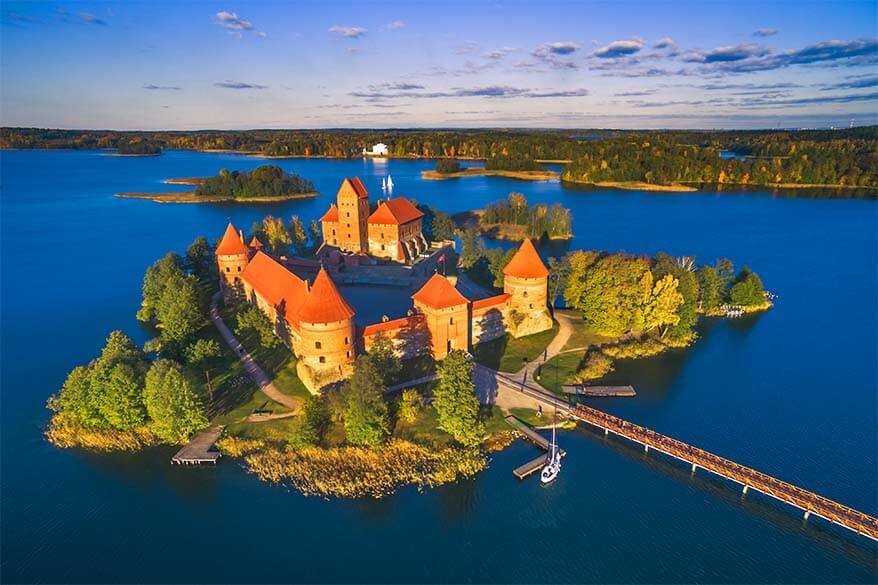
Are you considering a trip to the most beautiful country in the Baltics and wondering what there is to see and do in Lithuania ? In this article, you will find my selection of some of the best places to see and the best things to do in Lithuania . This is an insider’s guide, filled with local tips and advice, and I hope that it will inspire you to visit my home country and explore it deeper.
I have been running the Full Suitcase travel blog for several years now, writing about the most diverse destinations from all over the world… Yet, I always struggled to write about my home country, Lithuania, because it’s somehow hard to see it through the eyes of a tourist…
However, when I Googled ‘best things to do in Lithuania’, I found that all the best-ranking articles don’t do Lithuania justice… Sadly, most of them are written by hired writers who have never even been to Lithuania and have no idea what it’s truly like, not to mention all the inaccuracies and highlighting the strangest places just for the sake of filling the article…
And so I decided that it’s time to share my favorite places and best things to do in Lithuania, giving you a unique local insight and useful practical tips.
I want to show you how diverse and beautiful my home country is and that there is so much more to see and do in Lithuania than it looks at first sight. Find out!

This guide contains the very best things to do in Lithuania and the most unique destinations that you really should see . Every place featured here is one that we, Lithuanians, are proud of. At the same time, I only chose places that I think are truly worth your time as a tourist.
So if you are visiting the country for the first time and want to see the very best that Lithuania has to offer, this guide is for you. Find out!
Good to know: Because the locations mentioned in this article are scattered all over Lithuania, I also created a map , indicating each point of interest. You can find it at the bottom of this article. That should help you get a better idea of where everything is located and plan your trip accordingly.
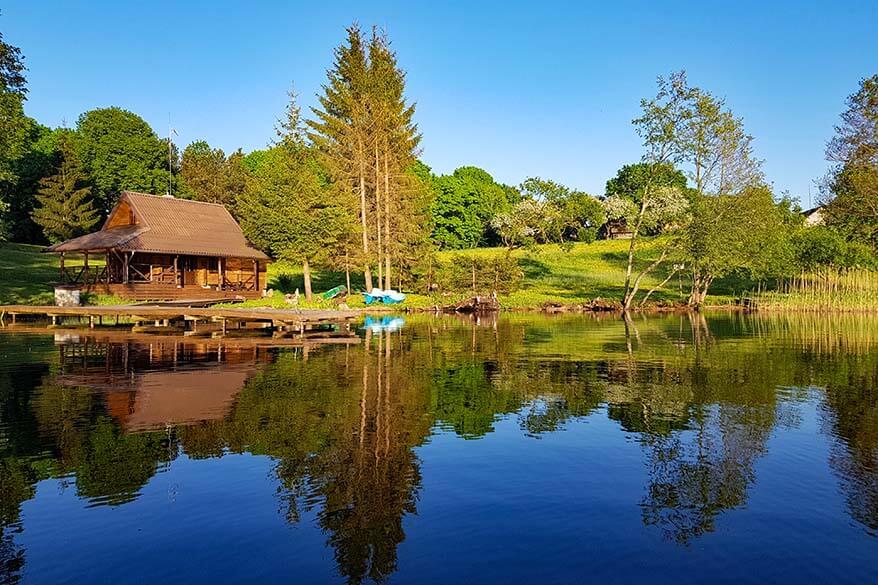
These are the best things to do in Lithuania:
1. Sand Dunes of the Curonian Spit
I want to start this list with my personal favorite place in Lithuania – sand dunes of the Curonian Spit . This is a place where I spent countless summers as a child, a place that I took my husband to when he first visited Lithuania, and a place that I recommend to every tourist traveling to Lithuania.
The Curonian Spit is one of the most unique places in Lithuania. This 98 km long, 0,4 – 4km wide sand-dune spit separates the Curonian Lagoon from the Baltic Sea. There are just a couple of villages, surrounded by endless forests and drifting sand dunes. Sometimes, it seems that time stood still here.
There is a lot to see in the Curonian Spit (and I’ll cover some of the best places below), but the main reason to come here is the sand dunes. Up to 60 meters high in places, these are the highest drifting dunes in Europe.
After intensive logging in the 17th and 18th centuries, the dunes began moving, burying several villages under the sand. Lots of effort and continuous dune stabilization work continues in order to preserve this ever-evolving landscape for future generations. Curonian Spit is now a UNESCO World Heritage Site.
TIP: The most impressive dunes that shouldn’t be missed are Parnidžio kopa ( Parnidis Dune ) in Nida and Pilkosios kopos or Mirusios kopos (Grey Dunes or Dead Dunes) also called Agilos kopa in Naglių Nature Reserve .
Good to know: If you walk too far to the southwest from Parnidis Dune, you risk entering the territory of Kaliningrad, part of the Russian Federation. Make sure that you follow any signs and don’t get into trouble for crossing the border.
LEARN MORE: Curonian Spit

2. Vilnius Historic Center
Vilnius Historic Center , or Vilnius Old Town, is another UNESCO World Heritage Site, and a must-see in Lituania. Despite countless wars and destructions, Vilnius managed to preserve its medieval layout and an impressive mix of Gothic, Baroque, Renaissance, and classical architecture.
There are many impressive buildings in the Old Town and the best way to see it all is to explore the historic center on foot.
Don’t miss the St. Anne’s Church and the adjacent St. Francis of Assisi (Bernardine) Church, the Gate of Dawn, Pilies Street, the Palace of the Grand Dukes of Lithuania, Vilnius University and the Church of St. Johns, the Presidential Palace, and of course Vilnius Cathedral with its Bell Tower, and our National pride – Gediminas Tower…
I am not going to mention all these places separately because this would require a whole separate article. But some of them deserve a separate mention and you’ll find some more info further below.
TIP: See if you can join one of the walking- or bike tours with local guides during your visit to Vilnius. It’s a great way to explore the old town, get some background information of the main sights, and hear interesting stories about the city and its fascinating history.
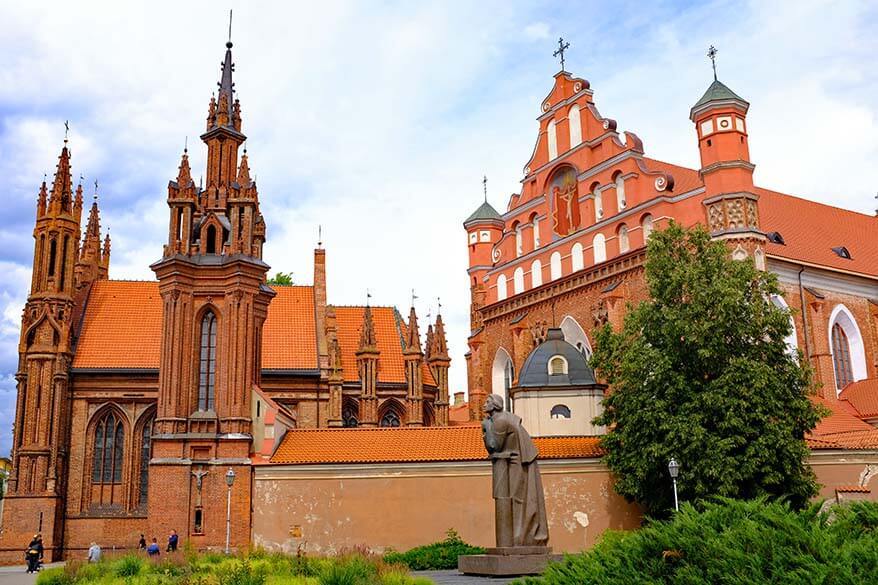
3. Trakai Island Castle
Trakai Castle , built in the 14-15th centuries and just recently restored, is considered a definite must-see place in Lithuania. Located in the most beautiful setting on a little island surrounded by Lake Galvė, the castle is truly impressive. The whole area around Trakai is dotted with lakes and if you can, take your time to explore it as well.
Because Trakai is just a short drive from the capital city, visiting Trakai Castle is the most popular day trip from Vilnius. It’s also one of the most visited tourist attractions in Lithuania, a favorite among tourists and locals alike.
Sometimes, it might feel like a tourist trap, but if you look beyond the crowds, the tour buses, and the souvenir shops, you’ll be able to appreciate the unique setting and impressive architecture dating back from the times when the Grand Duchy of Lithuania was one of the main powers in the region, stretching all the way to the Black Sea.
TIP: You can visit Trakai by taking a guided tour from Vilnius . Alternatively, take a car or a train and visit on your own. If you come in the warm season, I highly recommend renting a rowing boat or a kayak. It’s a great way to explore the beautiful area around the castle. The best way to appreciate the incredibly beautiful surroundings here is by taking a hot air balloon tour .
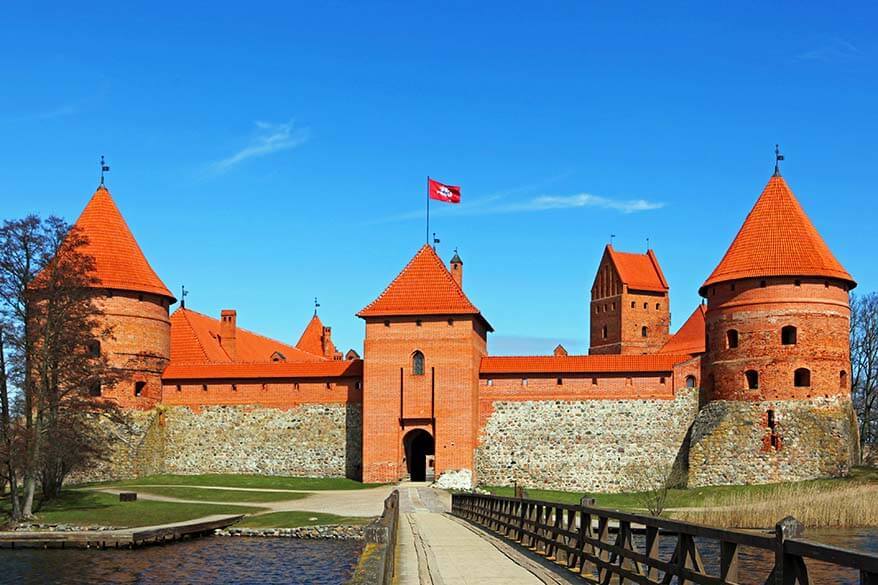
4. Gediminas Castle Tower
One of the absolute must-see places in Vilnius, Gedimino bokštas ( Gediminas Tower ) deserves a separate mention and a place on this ‘best of Lithuania’ list.
This tower is one of our National symbols and one of the very few historic places in the country that we were allowed to be proud of even in Soviet times.
Gediminas’ Tower is the most important feature remaining of the former Upper Castle in Vilnius. The first wooden fortifications at this place were built in the 14th century by Grand Duke Gediminas. This castle was the start of Vilnius city which would later become the capital of Lithuania.

According to a legend, Gediminas was hunting in the sacred forest near the two rivers that we now know as the Vilnia River and Neris River. Because he was too tired to head home, he set camp at this place for a night. That night, he dreamt of an iron wolf, standing on top of a hill and howling as loud as a hundred wolves. In the morning, he asked the head priest to interpret the dream. He told him that the iron wolf represents a castle and a city that will be established here and the glory and fame of which will be known throughout the entire world.
As it was common in those days, Gediminas saw this as a will of God and decided to build a city in this location, naming it Vilnius, after the Vilnia River.
Every Lithuanian grows up reading fairy tales and stories of this legend and it would be hard to find a Lithuanian who hasn’t visited the tower at least once in their lifetime… It will come as no surprise that Gediminas’ Tower Castle is considered as one of the most important places to see in Lithuania.
Practical info: Gediminas’ Tower Castle is open daily (except on Public Holidays). You can either take a funicular or walk up the hill. The views from the top of the tower are worth the effort and you can also visit the weapons and armory exhibitions inside.
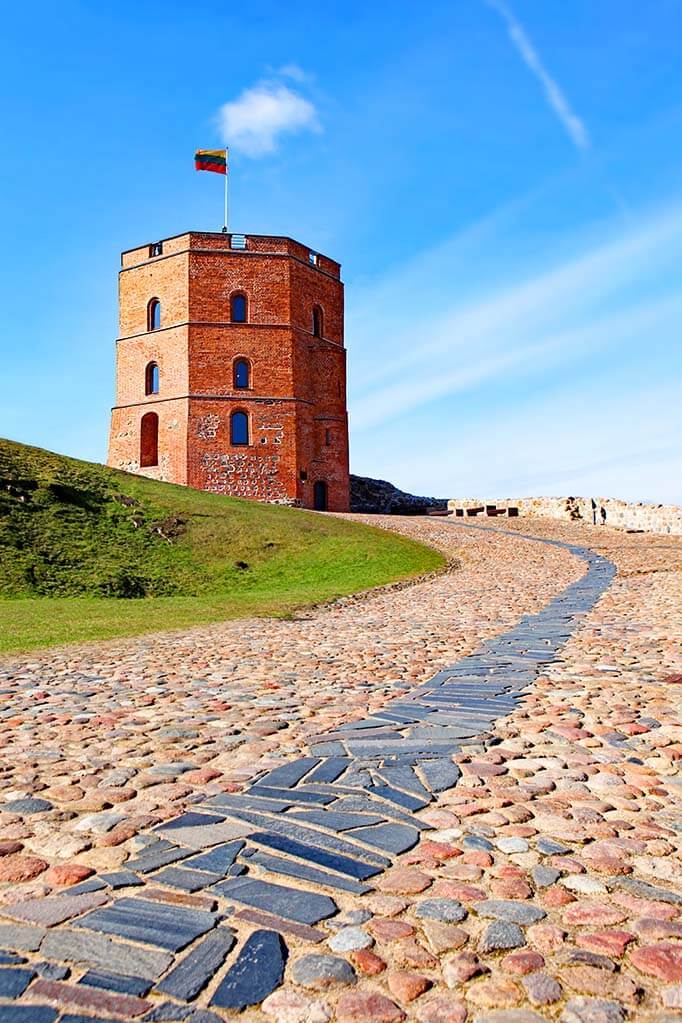
5. Hill of Crosses
Kryžių kalnas , Hill of Crosses , is not just one of the best places to visit in Lithuania, it definitely deserves a place on any list of the most unique places in the world. Hundreds of thousands of crosses in all shapes and sizes, covering this tiny hill in the middle of nowhere is a very impressive sight!
Hill of Crosses dates back to the beginning of the 19th century when people were placing crosses to commemorate their loved ones who died in the uprising against the Russian Tsar. Needless to say, the authorities were not amused. It was forbidden to place crosses and they were being torn down by the government. That didn’t stop the people, however; they just looked for more remote locations. That’s how the Hill of Crosses on the Domantai Hill Fortress was born.
Despite the political oppression, the Hill of Crosses continued to grow and became a symbol of hope and strength for the Lithuanian people. It has become a very popular place for all kinds of religious celebrations in the interwar period.
Afterwards, as Lithuania was occupied by the Soviets, it was strictly forbidden to place crosses or to come to pray here. The Soviets have tried everything in order to destroy the Hill of Crosses – they took away all the crosses, closed the roads leading to it, and even tried to flood the area… But the harder they tried, the stronger was the will of the people to preserve it.
People would come here in the middle of the night, bringing new crosses all over again. The Hill of Crosses has become the symbol of heroic resistance to the suppression of religious freedom.
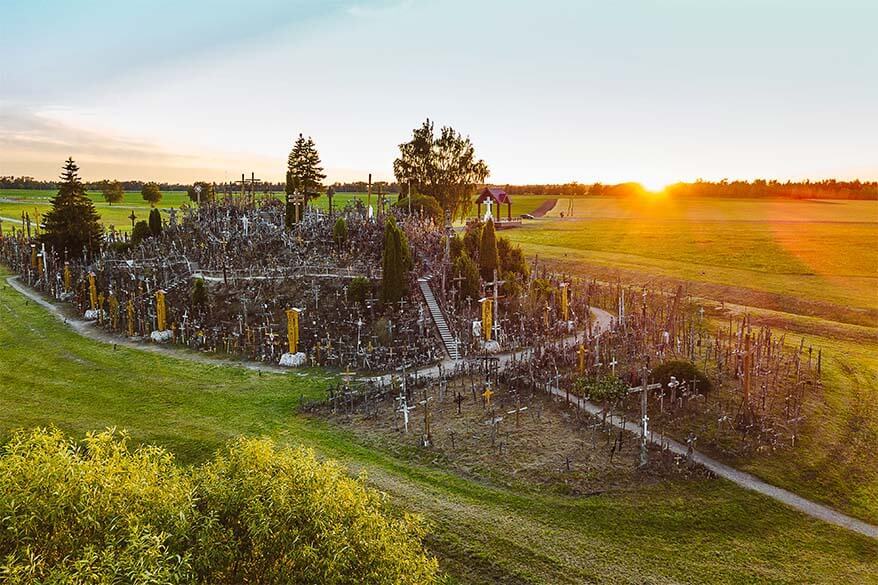
Ever since Lithuania’s independence, the Hill of Crosses has gained more and more significance. Its importance was crowned by the visit of the Pope in 1993. Nowadays, it’s a popular pilgrimage site and one of the most special places to see in Lithuania.
Practical Information: Hill of Crosses is located near Šiauliai, in northern Lithuania. It’s about 2.5 hrs drive from Vilnius and 2hrs drive from Kaunas or Klaipėda. It’s a good stop if driving to Riga in Latvia, that’s also about 2 hours away from here. It’s always open and there is no fee to visit and you can come here at any time.
While it requires some effort to get here, most people consider it more than worth it. It’s one of the most unique places you’ll ever visit.
TIP: You can visit the Hill of Crosses with this popular tour as a day trip from Vilnius . Alternatively, there is a private tour that combines the Hill of Crosses with a visit to Anykščiai (see #14 further below).
LEARN MORE: How to Visit the Hill of Crosses

6. Palace of the Grand Dukes of Lithuania
Valdovų rūmai , the Palace of the Grand Dukes of Lithuania is an excellent museum located inside the restored 15th-century palace at the Cathedral Square in Vilnius. I would dare say that, at the moment, this is the best museum in Lithuania.
The museum has several parts, with the most impressive one being the ruins of the original palace underground and the beautiful rooms displaying authentic furniture, tapestries, and paintings on the upper floors.
But probably the most impressive is the incredible historic virtual reality 3D experience . We have seen many virtual reality experiences in various contexts and this one is one of the very best ever. It’s great for both, kids as well as adults.
In a matter of a couple of minutes, you’re taken back in time and witness the creation and growth of Vilnius city. It’s so well done that it will take your breath away. I think that this 3D experience is the best thing you can do in Vilnius. It will help you appreciate everything you see in the city even more. Don’t miss this!
Practical info: The museum is open daily in summer, and every day except Mondays the rest of the year. Closed on certain Public holidays. More info here .
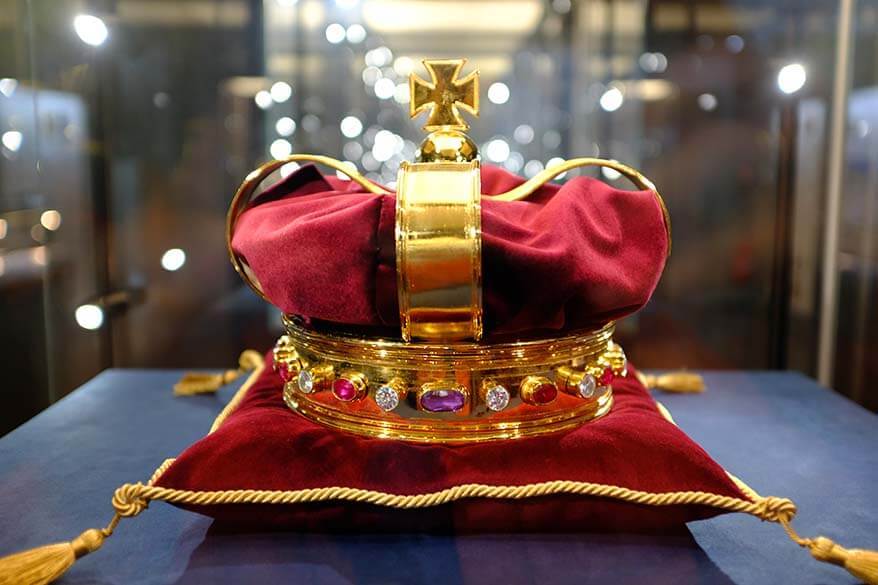
No list of the best places in Lithuania would be complete without mentioning its second-largest city and my hometown, Kaunas . Dating back to the 14th century and set in the place where the two biggest rivers in Lithuania – Nemunas and Neris – come together, Kaunas has always held a very significant place in Lithuania’s history.
In the interwar period, when Vilnius was occupied by the Polish, Kaunas was the temporary capital city of Lithuania. The city has known good times, but it has also suffered a lot, and for a while, it looked like it was struggling with its image.
Recently, Kaunas has been selected as the European Capital of Culture of 2022 and the city is rapidly changing beyond recognition. I am glad to say that it is doing its best to restore and reinvent itself and is again becoming a city that we can all be proud of.
Not to be missed is Kaunas Old Town, Kaunas Castle, the Town Hall Square ( Rotušės aikštė ), the Cathedral, Vytautas Church, House of Perkūnas, Confluence of Nemunas and Neris rivers, the main pedestrian street Liberty Boulevard ( Laisvės alėja ), St. Michael the Archangel’s Church, and its countless museums including M.K. Čiurlionis Museum of Art and Žmuidzinavičius Museum, known as the Devils’ Museum (more info further below).

8. Klaipėda
Surprisingly, hardly ever mentioned as one of the best places to visit in Lithuania, Klaipėda is, in my opinion, another must-see in Lithuania.
Lithuania’s third-largest town and its biggest main port city, Klaipėda is located at the Curonian Lagoon and the Baltic Sea. If you are taking a cruise through the Baltic States, you’ll likely stop here for a day.
Formerly known as Memel, Klaipėda was part of the Prussian Kingdom until 1923. That’s the reason why architecture here is very different than in the rest of Lithuania. I just love the wood-framed 18th-century German-style buildings in Klaipėda!
Don’t miss the Theater Square, the beautiful riverside of Danės River, and countless narrow streets and historic buildings of the Old Town. Another favorite is the Lithuanian Sea Museum (more information further below).

9. Lithuanian Folk Museum in Rumšiškės
There is no better place to get to know what life in Lithuania was like in the past than the Lithuanian Folk Museum in Rumšiškės, aka Open-Air Museum of Lithuania. It’s one of the largest ethnographic open-air museums in Europe, set in a beautiful area close to Kaunas Lagoon.
The museum is a great introduction to the ethnographic regions of Lithuania – Dzūkija (Dainava), Aukštaitija (Highlands), Suvalkija (Sudovia), Žemaitija (Samogitia)… All the houses here represent their respective regions and it’s interesting to see the architecture (and even the traditional clothing) differ from place to place. Inside, you’ll find typical household appliances and machinery, most dating from the 18th – 19th centuries.
Inside the museum, you’ll also find a ‘town’ with traditional buildings from all around Lithuania. There is also a church, a market square, and various houses of craftsmen with demonstrations in pottery, weaving, amber and wood crafting.
TIP: While the nicest time to visit the open-air museum is summer, it’s worth a trip the whole year round. Various events are held here in all seasons. Probably the best-known and the most popular one is Užgavėnės (a sort of Mardi Gras or a carnival, but then in the old-fashioned Lithuanian style). If you are visiting Lithuania during the carnival period (the week of Shrove Tuesday and Ash Wednesday), Rumšiškės is not to be missed!
Practical information: The museum is located just off the highway between Vilnius and Kaunas, about 80km from Vilnius and 30 from Kaunas town center. For opening times and other info, please consult the official website of the museum .
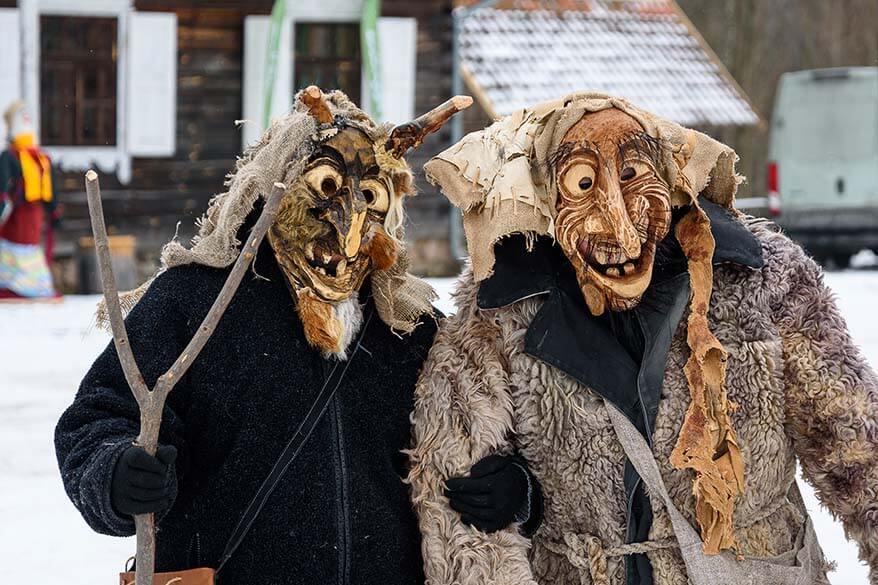
10. Pažaislis Monastery
Pažaislio Vienuolynas ( Pažaislis Monastery ) and the Church of the Visitation are a part of the largest monastery complex in Lithuania. Located on the shores of the Kaunas Reservoir (huge artificial lake), this 17th-century monastery is one of the best places to see in Lithuania. Yet, you won’t find many tourists here. It might get busy during certain events, but most likely, you’ll have this gem all to yourselves.
The magnificent buildings are probably the most beautiful example of Italian Baroque architecture in Lithuania and are definitely worth seeing. While it’s an actual working monastery, it’s possible to visit the beautiful church.
If you have some extra time, go for a walk in the surrounding area. It’s so beautiful and peaceful here.
Practical information: The monastery is located about 10km from the Kaunas town center and can be best reached by car. Public transport is also available. It’s open for visits daily, except Mondays. For more information and opening hours, please check their website .
TIP: You can visit Kaunas, Rumšiškės Folk Museum, and Pažaislis Monastery as a day trip with this guided tour from Vilnius .
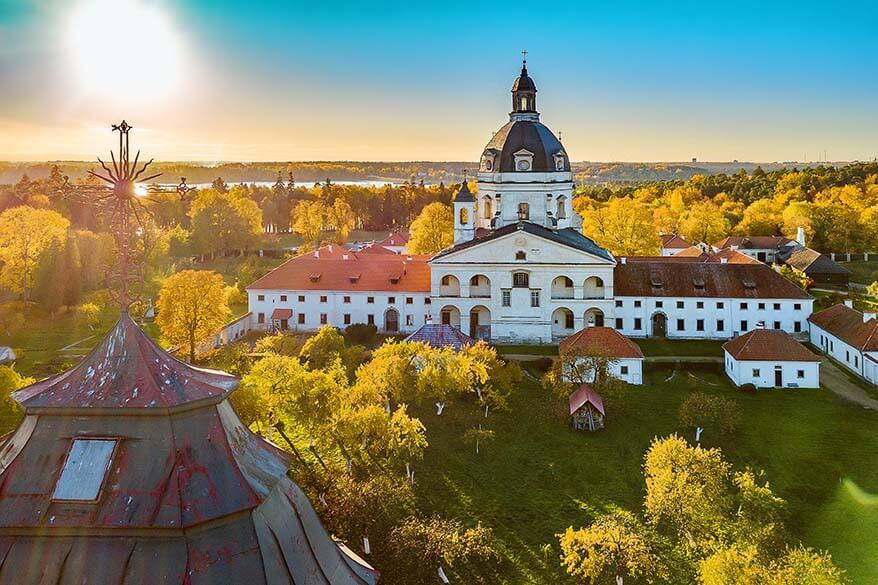
Nida is one of the biggest towns of the earlier mentioned Curonian Spit. In addition to the impressive sand dunes of the area, this picturesque town itself is also worth mentioning among the best things to do in Lithuania. It’s a true hidden gem!
Nida is a small fishermen’s town that has preserved its unique character and architecture not found anywhere else in Lithuania. It’s my favorite vacation place in Lithuania, but because it’s more isolated and not laying directly on the beach, it’s much quieter than the earlier mentioned Palanga.
Not to be missed are the earlier mentioned sand dunes, the colorful wooden fishermen’s houses, Thomas Mann Museum, and the lighthouse. You can also take a boat trip and see the impressive sand dunes from the water or visit the nearby Ventės Ragas (Ventė Cape). But my favorite thing to do is rent a bike and explore the 52 km of bike paths of the Curonian Spit. You’ll never want to leave!
LEARN MORE: Ultimate Guide to Nida

12. Grūtas Park
Grūto parkas ( Grūtas Park ) is a privately owned Soviet sculpture garden located in the forests of Grūtas village, near Druskininkai in the South of Lithuania. It contains a big exposition of the Soviet-era statues, Soviet memorabilia, and lots of other Soviet relics from the times when Lithuania was part of the USSR.
As Lithuania gained independence and all the towns and villages started getting rid of the statues of Lenin, Stalin, and other Soviet-era heroes, a businessman from Grūtas decided to collect them. In 2001, he opened this unique museum that quickly became the talk of the town. It has recently been expanded and now you can also find a small zoo, a kids’ playground (from the Soviet times), and a café here.
Grūtas Park has always been a bit of a controversial place, but it shows a big part of our recent history, and I think it’s certainly worth a visit. It is now considered as one of the most interesting places to see in Lithuania, so if you have a chance, give it a go.
Practical information: The park is open daily, the whole year round. For practical information and how to get there, please check their website .
TIP: You can visit Grutas Park, together with some other landmarks in the region by taking this highly-rated private day tour from Vilnius .
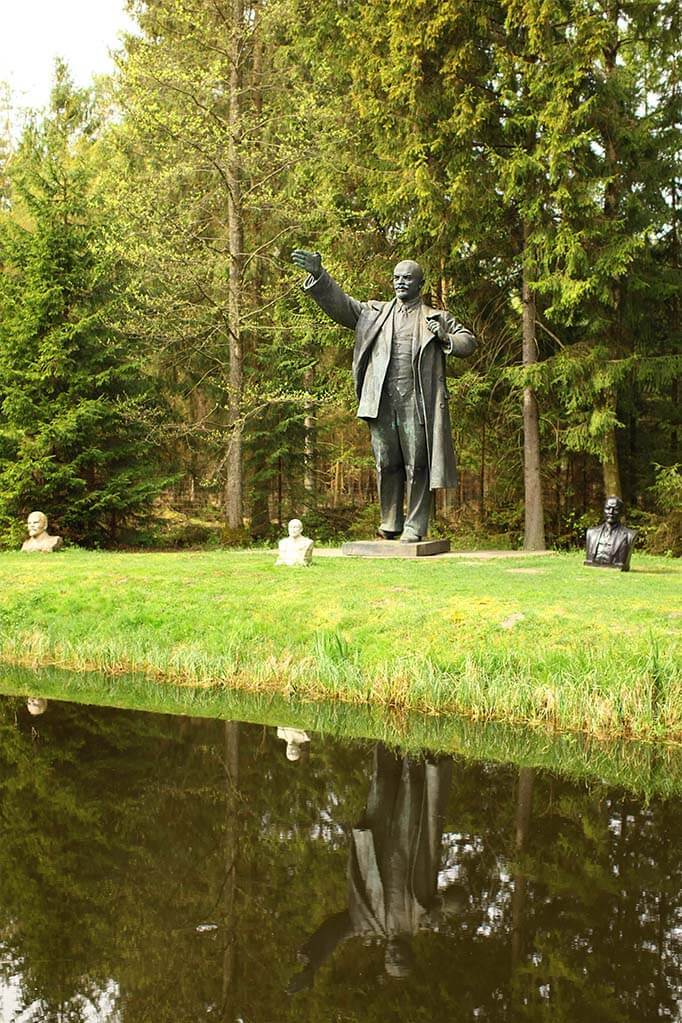
13. Druskininkai
One of the nicest small towns in Lithuania, Druskininkai , is little known to Western visitors. I didn’t see anyone mention it among the best towns to visit in Lithuania, but it’s really worth a visit. I might be biased as my godparents live here and I absolutely love Druskininkai, but I’m not the only one. This resort town is one of the most popular domestic destinations among Lithuanians and an absolute favorite among vacationers from neighboring countries.
Best known for its SPA treatments, Druskininkai is a very green town, with parks, forests, and lakes in and around the town. There are countless walking and biking paths, and the town has quite a lot to offer to tourists. Take a stroll on the pedestrian Vilnius Blvd, rent a rowing boat on the beautiful little lake with a fountain in the middle, rent a bike and discover one of the many parks, or visit a museum…
There is also a fantastic indoor water park, an adventure park, an indoor skiing arena, a gondola with fantastic views over the Neris River, and so much more… In the evenings, don’t miss the Musical Fountain – it’s always fun and you can order a song of your choice if you like to. If you want to explore further, you can also take a boat trip to the nearby historic Liškiava village.
Having mentioned all this, it might sound like Druskininkai is a busy town overrun by tourists. But it never feels like that! It has an amazing atmosphere and it’s a great place to visit in Lithuania in any season.
TIP: Druskininkai is like a destination in itself, so I recommend spending at least one night here (there are lots of really nice hotel s in town). Combine the visit with the earlier mentioned Grūtas Park which is located just nearby.

14. Anykščiai: Treetop Walking Path, Horse Museum & Puntukas Stone
Anykščiai is a sort of resort town, about 100km North of Vilnius. Known as one of the SPA towns and mostly visited by locals, I think it’s also worth a trip for tourists looking to get a bit off the beaten path in Lithuania.
The town itself is very nice and green, and its main landmark is the St. Matthias Church with the tallest spires in Lithuania. But most Lithuanians come here for another reason. A stone.
Anykščiai has always been known as the place where you could see Lithuania’s largest stone, Puntukas . We would travel all the way from the other side of the country just to see the stone…
I recently found out that it’s actually the second-biggest stone in the country, after the Barstyčiai stone, but nobody in Lithuania has ever heard of the latter. So Puntukas is our national stone and a place that every Lithuanian will proudly mention as one of the things to see in Lithuania.
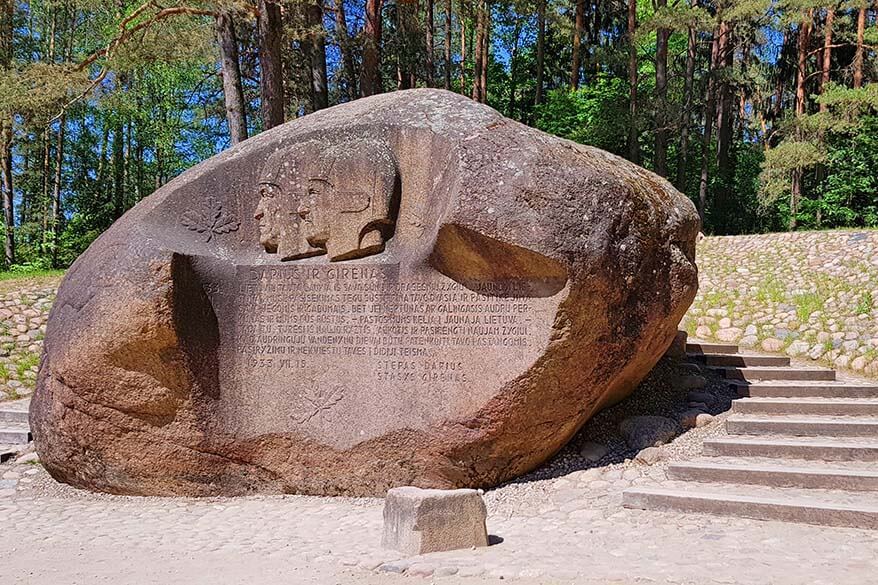
A few years ago, a new attraction has been opened just nearby – Anykščiai Treetop Walking Path , and that is, in my view, worth the visit to the area more than any stone. This Anykščiai Canopy Walk is located inside the national park, surrounded by lush forests. It’s a peaceful (although short) walk at the level of treetops, ending on top of an observation tower with an amazing view of the surroundings.
Another highlight in the Anykščiai area is Arklio Muziejus ( Horse Museum ). It’s a great place to visit, and especially if you are fond of horses or are traveling in Lithuania with kids. With lots of hands-on activities and horse riding available, it’s considered one of the best open-air museums in Lithuania.
While none of these places is an absolute must-see in Lithuania in itself, all of them together make for a really nice excursion. In addition, you can also combine all these places together with the nearby barefoot path or Labirynth park and turn it into a great family-friendly day out.
Practical information: Puntukas stone can be seen for free at any time, while the treetop walk can only be accessed during the day. It’s open daily, but hours vary by season. The Horse Museum is also open every day; for more information, please consult the official website .
TIP: If you don’t have a car, there are several tours that can bring you to this area as a day trip from Vilnius.
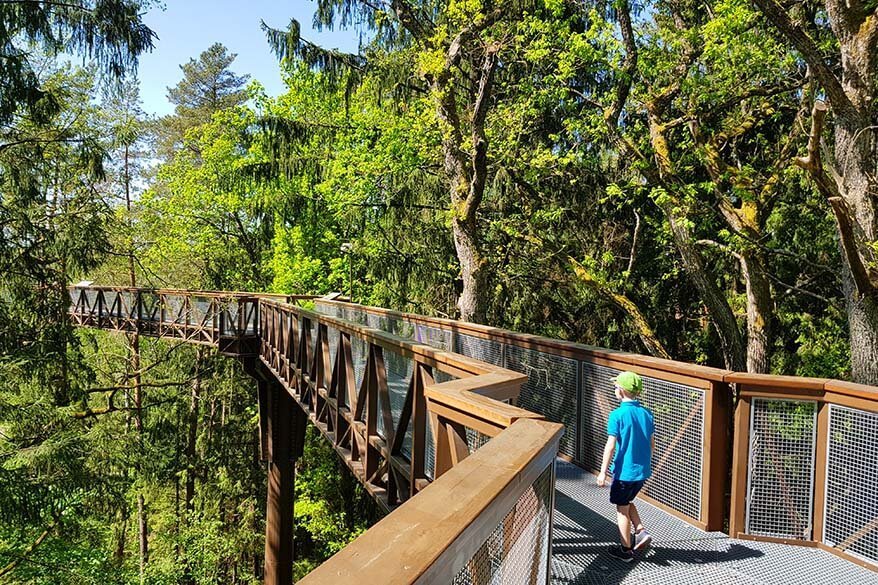
15. Palanga Amber Museum & Pier of Palanga
Palanga is the most popular Lithuanian seaside town. Thousands of Lithuanians spend their summer holidays at Palanga beach.
The town is a mix of beautiful nature, forests, and stunning white-sand beaches, but also the crazy busy and loud pedestrian Basanavičiaus Street that reminds you of a huge country fair… But if you can ignore this noisy crowded street, you will find that Palanga is actually a very pleasant little town that is worth visiting.
The reason why I decided to include it on this list of places to visit in Lithuania is because of the Palanga Amber Museum and the Pier of Palanga .
Palangos gintaro muziejus ( Palanga Amber Museum ) is located inside the restored 19th-century Tiškevičiai Palace and surrounded by the beautiful Palanga Botanical Garden. The museum features a really nice collection of Lithuanian gold – amber.
Amber is something that you’ll see everywhere in Lithuania – every souvenir shop and every market sells all kinds of amber jewelry and other products. But if you want to see some really nice exquisite pieces of amber, then there is no better place to do that than in this museum. My favorites are amber pieces with the fossilized remains of insects. Talking about stopping time…

Another reason to visit Palanga is the Pier of Palanga or Palangos tiltas ( Palanga Bridge ) as locals call it. There is no better place to see a sunset in Lithuania than from this wooden pier that stretches far into the sea.
On summer evenings, and especially on the weekends, it might feel like half of Lithuania has gathered to watch a sunset here. But if you come here in the lower season, you might have it all to yourself, and it’s simply magical…
TIP: If you decide to visit Palanga in summer, try to avoid weekends. If you are visiting in the colder season, after the storm, you might find some small pieces of amber on the beach.
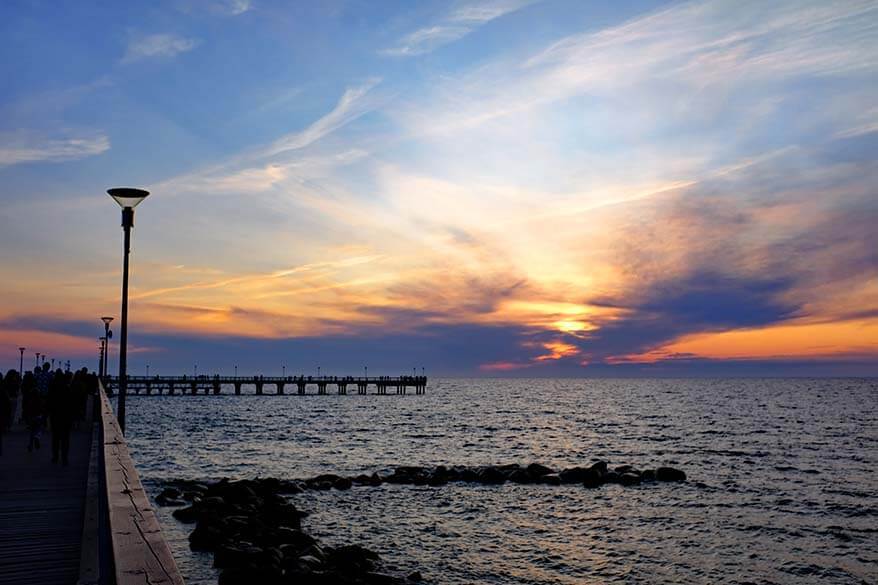
16. Užupis
Located in the center of Vilnius, Užupis is actually just a quirky part of Vilnius Old town. Literally, Užupis means ‘beyond the river’ and it’s indeed separated from the rest of the city by the Vilnia River.
After the fall of the USSR and the disappearance of the former Soviet statues, several local artists erected a statue of the US rock musician Frank Zappa, as a symbol of freedom and democracy. A few years later, they went a step further, and on the 1st of April 1997, declared the independent state of Užupis.
While it calls itself one of the smallest republics in the world and boasts its own constitution, government, president, and even a navy consisting of a couple of small boats, Užupis is not in any way a political statement, but rather an art project if you like. It’s an exciting area loved by artists and they pride themselves on treating everyone equally.
Don’t miss the Constitution of the Republic of Užupis which can be found on the wall of a building on Paupio Street, 3A. It has been translated into 26 different languages, so no excuses or saying you didn’t know the laws of this self-proclaimed republic…
Some of the laws of Užupis state that ‘ Everyone has the right to be unique ‘, ‘ Everyone has the right to hot water, heating in winter and a tiled roo f’, or ‘ A dog has the right to be a dog ‘ and ‘ A cat is not obliged to love its owner, but must help in time of need ‘… You get the idea…
It’s a fun place to see in Vilnius and has become one of the most quirky and popular tourist attractions in Lithuania.
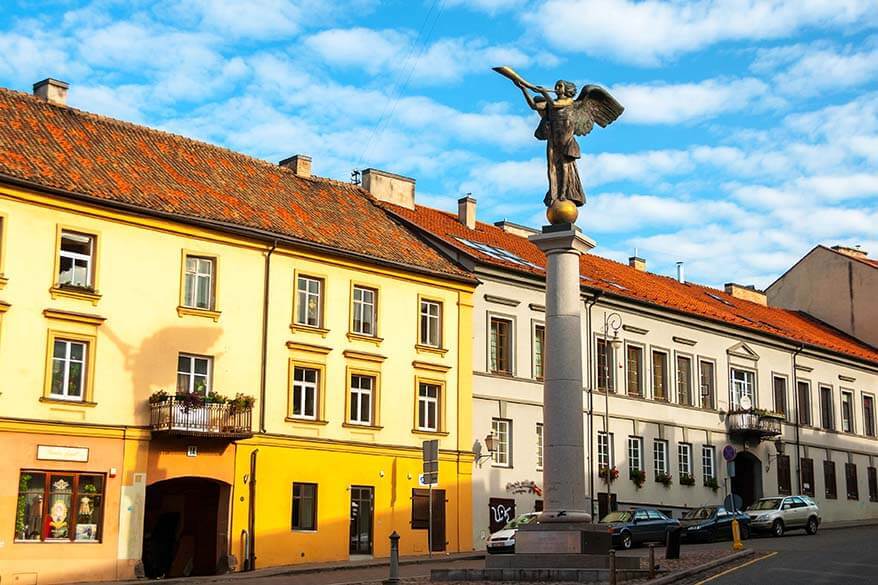
17. Museum of Occupations and Freedom Fights
The Museum of Genocide Victims aka Museum of Occupations and Freedom Fights is one of the most interesting museums in Vilnius, Lithuania.
Situated inside the former KGB building, this is by no means a light-hearted attraction. Some of the things you’ll see here are harsh and thought-provoking. But it’s a big part of our history and so if you want to know what Lithuania has been through in the recent past, this museum is a must!
Inside, you can visit the former KGB prison and see the premises where death sentences were executed for 50 (!) years. Here, you can learn about Lithuania’s occupation and repressions by the Soviets, and the persistent fight for independence.
Practical information: The museum is open Wednesday to Sunday, from 10 AM to 5-6 PM. See the official website for more info.

18. The Geographical Center of Europe & Europa Park
Back in 1989, the French National Geographic Institute determined that the geographic center of Europe is located in Lithuania, near the village of Purnuškės. Several countries claim to be at the heart of Europe and I’m not going into those discussions, but Lithuania gladly accepted this French calculation and proudly calls itself the Center of Europe.
If you like visiting quirky symbolic places like this, then you’ll enjoy a quick photo stop at the Geographical Center of Europe . It’s not much more than a monument, and you can get a special certificate confirming that you visited the center of Europe.
Another interesting place to see nearby is Europos Parkas ( Europa Park ), a sort of open-air museum that was designed to give artistic significance to the fact that Lithuania is the Center or Europe. This is a privately-owned museum, set in the forest with a variety of large modern artworks scattered in the area. In my view, it’s not really a must, but if you are visiting the area anyway, it’s a nice place to stretch your legs and see something different.
Practical information: The Center of Europe is located in Purnuškės, about 30km North of Vilnius and can be visited at any time. Europa Park is located in the same area, about halfway between Vilnius and Purnuškės. It can be visited the whole year round and is open daily. For opening hours and practical info, please check the official website .
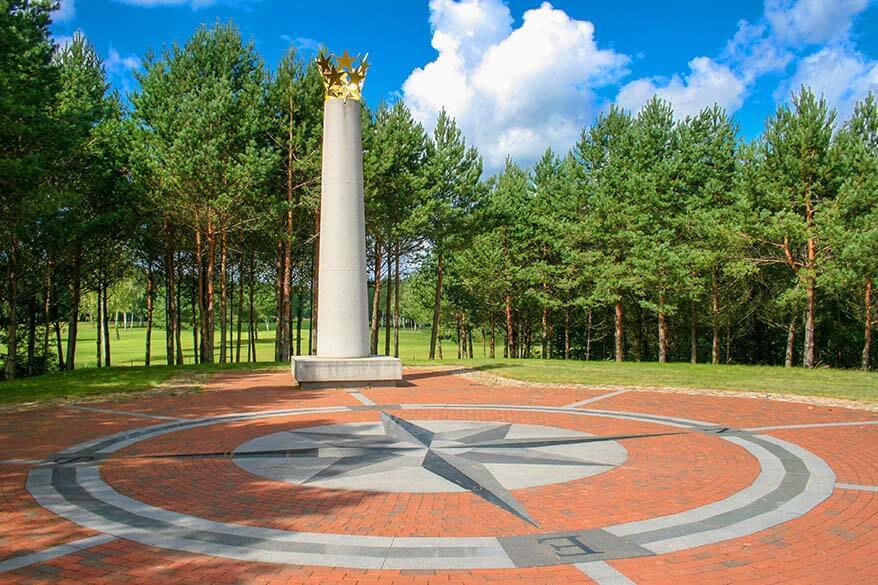
19. M.K. Čiurlionis Museum of Art
Mikalojus Konstantinas Čiurlionis was a Lithuanian composer, painter, and writer who lived at the end of the 19th – the beginning of the 20th century. He’s one of Lithuania’s most famous artists and one of Europe’s pioneers of abstract art.
In his short life of just 36 years, he created hundreds of pieces of music, paintings, poems, and literary works. M.K. Čiurlionis Museum of Art in Kaunas houses the biggest collection of those works and is one of the best art museums in Lithuania. Not only can you find a big collection of his paintings, but also listen to his music. The two are interrelated and many of Čiurlionis’ paintings have musical names.
In addition to the works of Čiurlionis, this large museum houses ancient Egyptian and Greek art, as well as a big variety of European art from the 16th to 20th centuries.
TIP: One of the top attractions here now is an amazing VR film ‘Trail of Angels’ based on Čiurlionis’ works. Don’t miss it! And if you don’t have time to go to Kaunas, this experience is now also available in Vilnius. You can find more info here (be sure to reserve this in advance!).
Practical information: This museum is located in the center of Kaunas and is open daily, except on Mondays. There is an audio guide available and the dedicated staff is always ready to give you more details. More info here .

20. Devils’ Museum
Žmuidzinavičius Museum , known as the Devils’ Museum in Kaunas is one of the most special, quirkiest museums in Lithuania. It’s also the only museum in its kind in the world, and so it definitely deserves a mention among the main points of interest in Lithuania. If you are in Kaunas, don’t miss it!
Antanas Žmuidzinavičius was an artist who collected an impressive number of sculptures and carvings of devils from all over the world. After his death, his collection has been turned into a museum. In addition to the impressive collection of devils, you can also see paintings by the artist himself.
At the moment, the museum houses over 3000 devils from over 70 different countries. You can also learn a lot about Lithuanian folklore and stories and myths about the devils and evil creatures displayed here. If you bring a unique devil from your own country, the museum will accept it as a present and most likely add it to their collection.
Practical information: This museum is located in Kaunas, just next to the previously mentioned Čiurlionis Museum of Art. It’s open daily, except on Mondays.
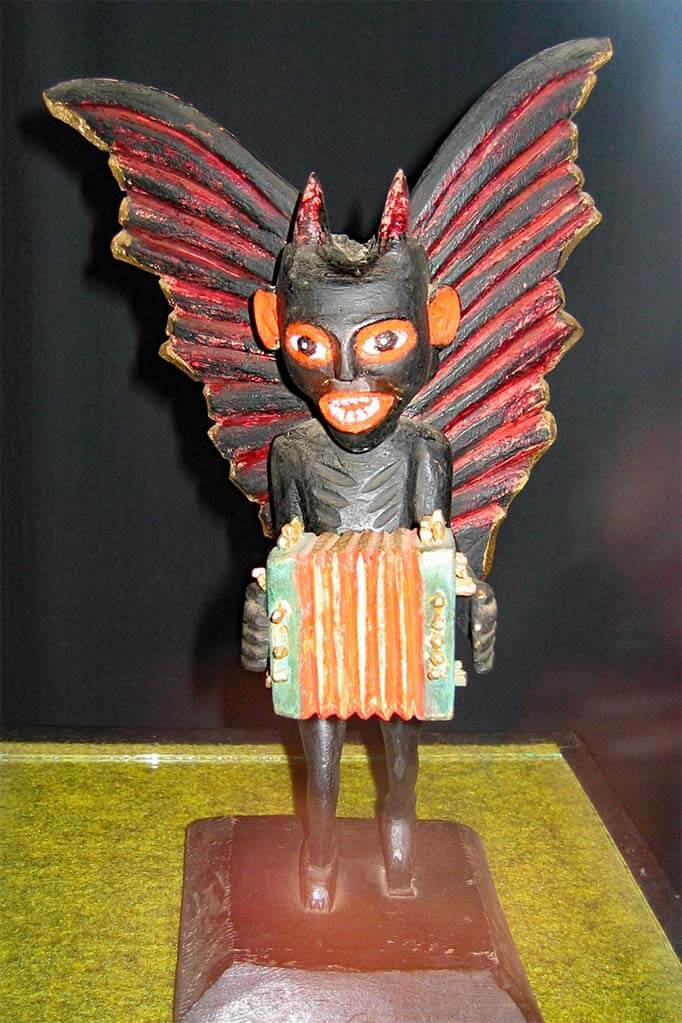
21. The Hill of Witches
The Hill of Witches is an outdoor sculpture gallery in Juodkrantė, on the earlier mentioned Curonian Spit. All the sculptures here are made of wood and most portray Lithuanian fairytale characters, such as witches and devils.
Set in a beautiful forest, this feels like a magical place that will especially appeal to families with children. The Hill of Witches might not be a huge landmark, but it’s so unique and so typically Lithuanian that I think it deserves a visit. If you are visiting the Curonian Spit and have half an hour to spare, it’s a must-do!
Practical information: Since the sculptures are set in the forest, it’s always open and it’s free of charge.
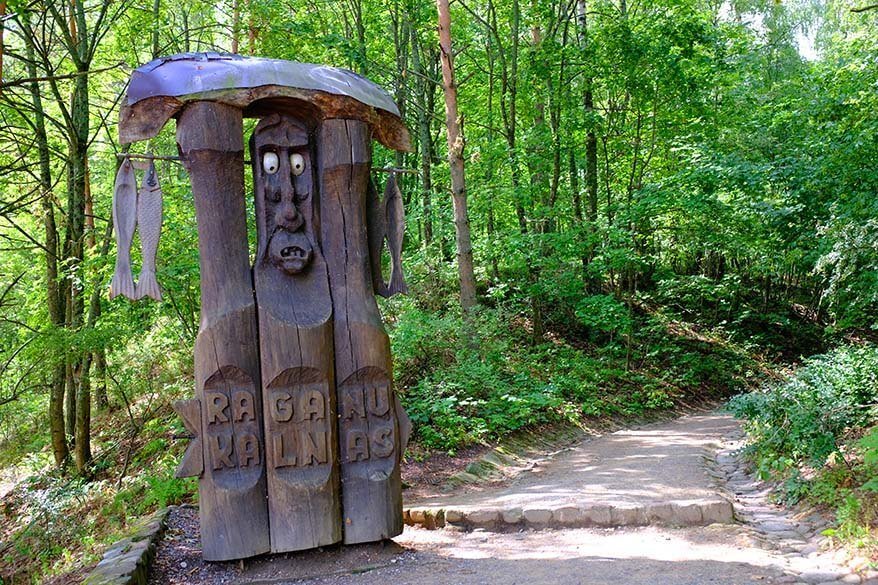
22. Lithuanian Sea Museum
Lietuvos jūrų muziejus ( Lithuanian Sea Museum ) is a maritime museum with big aquariums, an aquarium tunnel, great sea lion and dolphin shows, and also historical exhibits. Located in an old fort on the northern tip of the Curonian Spit, it’s just a very short ferry ride away from Klaipėda town center.
It’s a fun place to visit in Lithuania with kids. Not only can you see a big variety of fish and animals including penguins, sea lions, and dolphins, it’s also a great place to learn more about the Baltic Sea. In addition, you will find some big old ships and also a replica of an old fisherman’s house.
Practical information: Old Smiltynė Passenger Ferry is the best way to get to the museum from Klaipėda. Alternatively, if you are visiting the Curonian Spit anyway, you can come here by car. Just get here early in the morning or parking space will be really hard to find.
It’s open the whole year round. In summer, the museum is open daily except on Mondays, the rest of the year – opening hours differ per season. More information on their website . Count at least half a day for a visit.
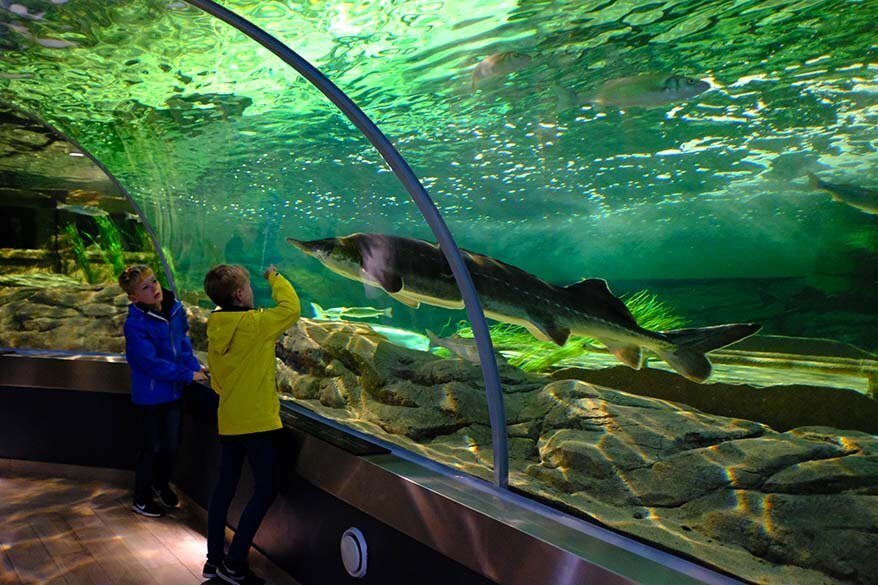
23. Dutchman’s Cap
Olando kepurė ( The Dutchman’s Cap ) is a 24-meter high sand hill with a steep cliff crashing into the Baltic Sea. It’s probably one of the most untouched, rough coastal landscapes in Lithuania.
The Dutchman’s Cap gets its name due to its shape that – looking from sea to land – looks like a traditional bi-corn admiral’s hat. This area has been mentioned as a navigational guide for sailors and fishermen in the early 19th century.
While not an absolute must in Lithuania, it’s a very nice tranquil place with nice scenery. It’s worth a short stop if you find yourself on the Lithuanian coast, but I wouldn’t drive all the way to the coast just for this. The best time to visit is at sunset.
Practical information: The Dutchman’s Cap is located between Klaipėda and Palanga (see the exact location on the map further below). There are many walking paths in this area. You’ll have to leave your car at one of the designated parking areas and walk 10-15 minutes to get to a small viewing platform. It’s also possible to walk down to the coast. You can spend half an hour here or a few hours (searching for amber :)) – it’s up to you.
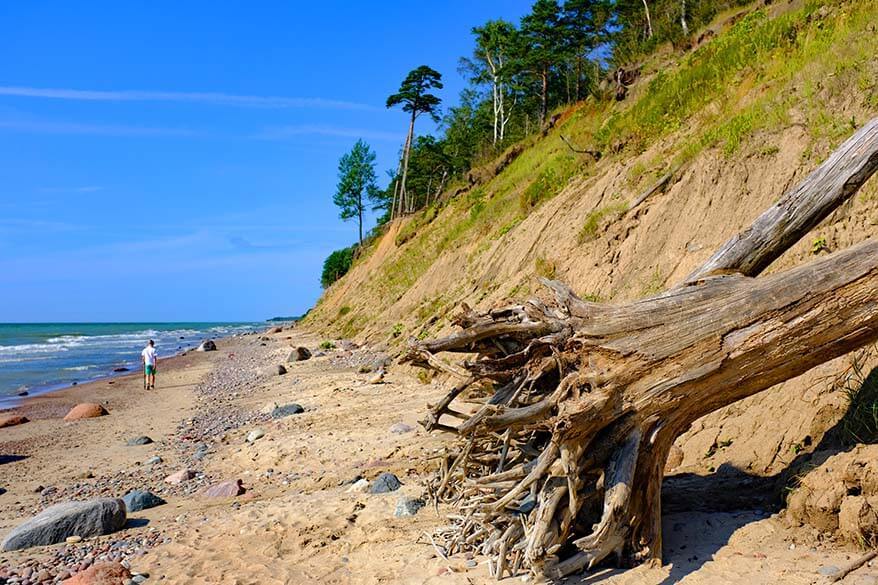
24. Vilnius TV Tower
I was debating whether to include Vilnius TV Tower in this list of the best places to visit in Lithuania. But, since it has historical significance and offers some of the best views in Vilnius, I decided that it’s worth a mention.
On the 13 of January 1991, Vilnius TV Tower was at the center of a bloody independence fight against the Soviets. This was one of the last struggles that finally tore the USSR apart. Sadly, 14 Lithuanian people were killed here by the Soviet tanks that day. This is one of the darkest chapters of our recent history and I still remember the events of that day as if it was yesterday.
With over 326m in height, Vilnius TV Tower is the tallest building in Lithuania and the 8th tallest in Europe. You can visit an underground gallery, the Fight for Freedom Museum, and also take an elevator to the 165m height from where you get an amazing panorama of Vilnius and its wide surroundings.
TIP: Have lunch or dinner at the rotating Paukščių takas (Milky Way) restaurant and enjoy the 360° views with the whole city of Vilnius at your feet.
PRO TIP: If you are visiting Lithuania in the summer season and are looking for something unique to do in Vilnius, check out the new Edge Walk experience !
Practical information: The TV Tower is open for visits daily. More information on their website .
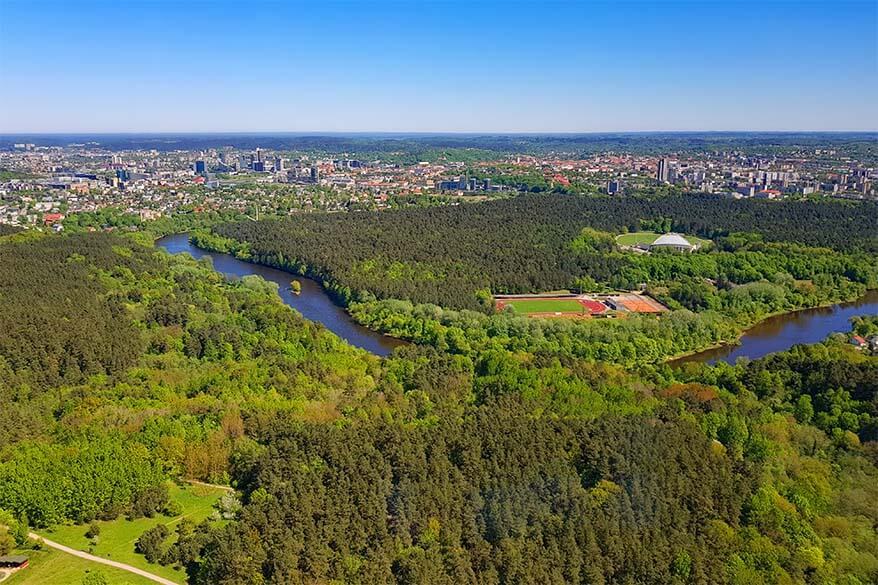
25. Lakes, Rivers, and Forests
With over 6000 lakes, more than 800 rivers, and over 33% of the territory covered by forests, Lithuania is a paradise for those who love simple, untouched nature .
It will come as no surprise that Lithuanians massively leave cities and head to nature every weekend. Kayaking, swimming, fishing, berry- and mushroom picking are just some of the favorite pastimes for Lithuanian people. In winter, people go walking, cross-country skiing, skiing, and also ice-fishing. No matter the season, Lithuanians love the outdoors.
If you are looking to explore Lithuania deeper, do as the locals do, and head to one of the many forests and lakes.
TIP: If you don’t know where to start, here you can find a selection of organized kayak tours all over Lithuania . If you are visiting Lithuania in summer, there is no better way to experience our nature than by going kayaking!
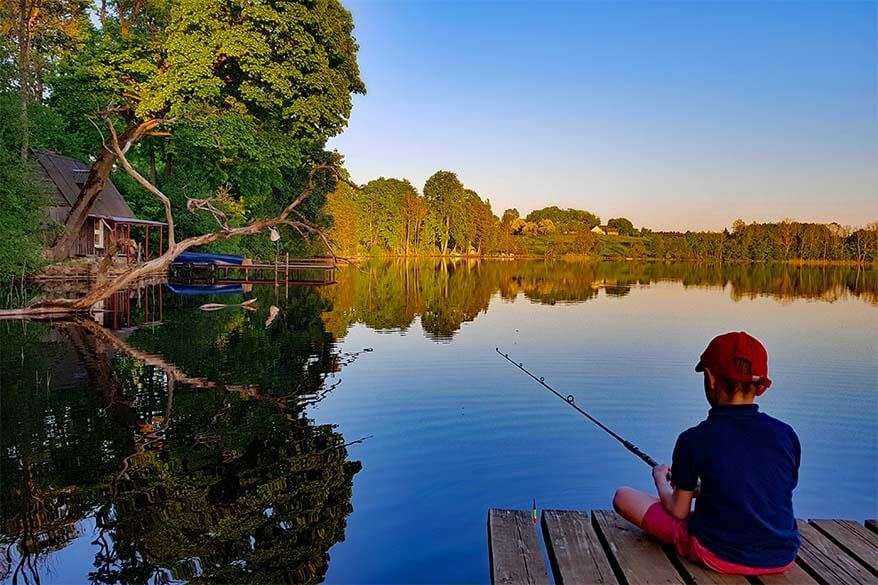
26. Christmas Trees
Lithuanian Christmas trees deserve a special mention. They are so nice and so special that it’s really worth it to (re-) visit Lithuania in winter, just to see the Christmas trees.
The most unique and spectacular Christmas trees can be found in Cathedral Square and the Town Hall Square in Vilnius and also at the Town Hall Square in Kaunas.
But also smaller towns often have the most beautiful Christmas decorations.
LEARN MORE: Vilnius Christmas Trees and Christmas Markets

27. Lithuanian Food
No list of the best things to do in Lithuania would be complete without mentioning traditional Lithuanian food . If you are traveling to Lithuania, make sure to taste at least some of our local specialties.
Lithuania has many traditional dishes that you won’t find anywhere else in the world. The most famous and typically Lithuanian are our potato dishes, such as cepelinai , kugelis , bulviniai blynai , and vėdarai .
Other favorites include koldūnai (sort of dumplings), lietiniai blynai (filled pancakes), šaltibarščiai (cold beetroot soup), kepta duona su česnaku (fried bread with garlic), baravykų sriuba (boletus mushroom soup), and also non-alcoholic drinks such as kisielius or gira .
TIP: If you try just one typical Lithuanian dish, make it cepelinai . They are a sort of potato dumplings, somewhat comparable to the Italian gnocchi in taste and structure. However, cepelinai are much bigger and they are stuffed with either meat or curd filling. They are usually served with a very heavy and fat spirgučiai sauce, but if you are not a fan of fat food, I recommend asking for sour cream instead.
LEARN MORE: Lithuanian Food: Best Traditional Dishes to Try in Lithuania
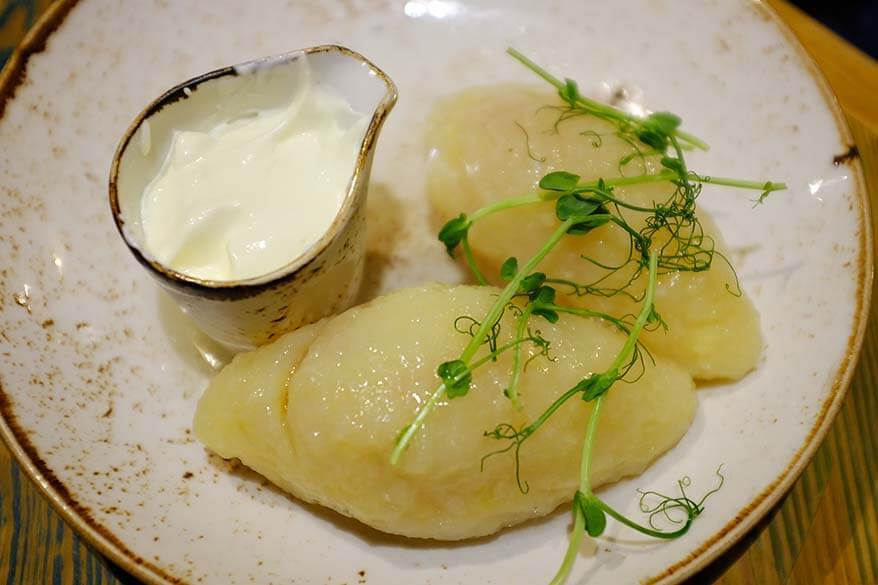
Even More Interesting Places to See in Lithuania
As already said, in this list, I only included the best places to visit in Lithuania that I think are worth your time the most. If you have more time, you might want to consider the following Lithuania destinations as well:
- Kernavė – the former medieval capital of Lithuania and an archeological site close to Vilnius.
- Kėdainiai – one of the oldest towns in Lithuania.
- Birštonas – resort and SPA town surrounded by beautiful nature.
- Labanoras regional park tower – 2nd highest observation tower in Lithuania with amazing views of the area.
- Panemunė Castle – one of the most authentic castles in Lithuania (17th century).
- 9th Fort of the Kaunas Fortress – a museum and memorial for the Holocaust victims.
- Užutrakis Manor – restored 19th-century manor.
- Paneriai Memorial Museum – Holocaust memorial in a forest where tens of thousands of Jews lost their lives.
- Ventė Cape – headland of Nemunas Delta and a bird-watchers paradise.
- Stelmužė Oak – with over 1,000 years, the oldest tree in Lithuania and one of the oldest in Europe.
Needless to say, there is so much more to see and do in Lithuania. But most tourists never visit even half of these places… So if you cover even just a small part of the above, you’ll have a much better idea of what Lithuania is truly like.
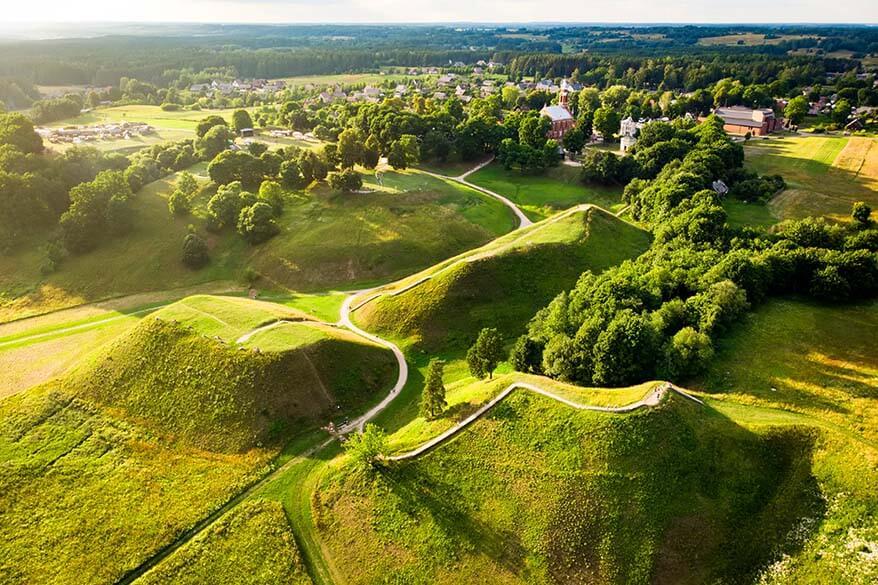
Map of the Best Things to Do in Lithuania
In order to help you get a better idea of where all these points of interest and attractions are located, I created this map of the best places to see in Lithuania .
The purple color indicates the main landmarks and places mentioned in this article. The orange color is for the other nice points of interest that are mentioned separately here above. In order to keep a more clear overview of the main landmarks in Lithuania, I didn’t indicate all the smaller places that are worth visiting in each of the mentioned towns.
How to use this map: Use your computer mouse (or fingers) to zoom in or out. Click on the icons to get more information about each place. Click the arrow on the top left corner for the index. Click the star next to the map’s title to add it to your Google Maps account. To view the saved map on your smartphone or PC, open Google Maps, click the menu and go to ‘Your Places’/’Maps’. If you want to print the map or see it in a bigger window, click on ‘View larger map’ in the top right corner.
So, this is our list of the very best places to see and things to do in Lithuania. I sincerely hope that you found some new ideas in this article and that it has inspired you to explore Lithuania beyond the most popular places like Vilnius and Trakai.
If you have any questions about the places mentioned above, don’t hesitate to leave a reply below and I’ll try to help. Have you been to Lithuania and want to share your experience? Feel free to do so as well!
READ ALSO: Baltics Itinerary: how to see the best of Lithuania, Latvia, and Estonia in 2 weeks
If you found this post useful, don’t forget to bookmark it and share it with your friends. Are you on Pinterest? Pin these images!
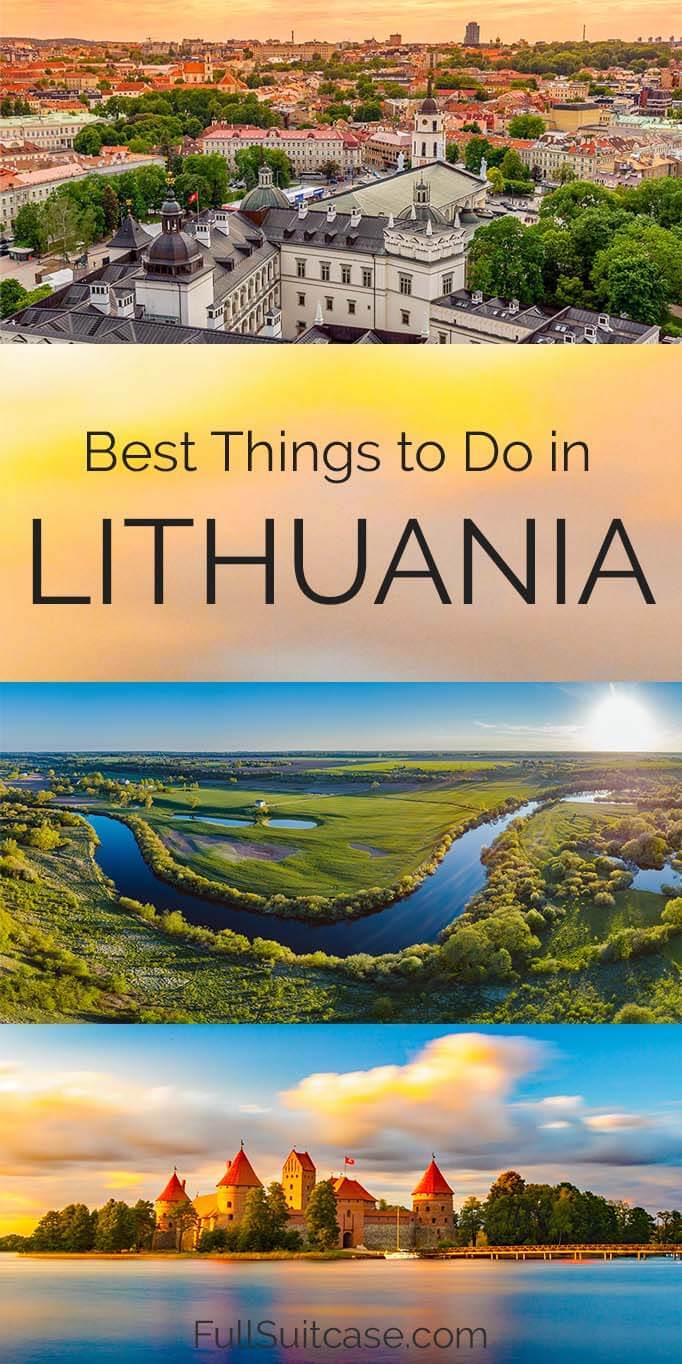
Featured image by Wide Wings/Shutterstock.com. All the other images by Jurga/FullSuitcase.com
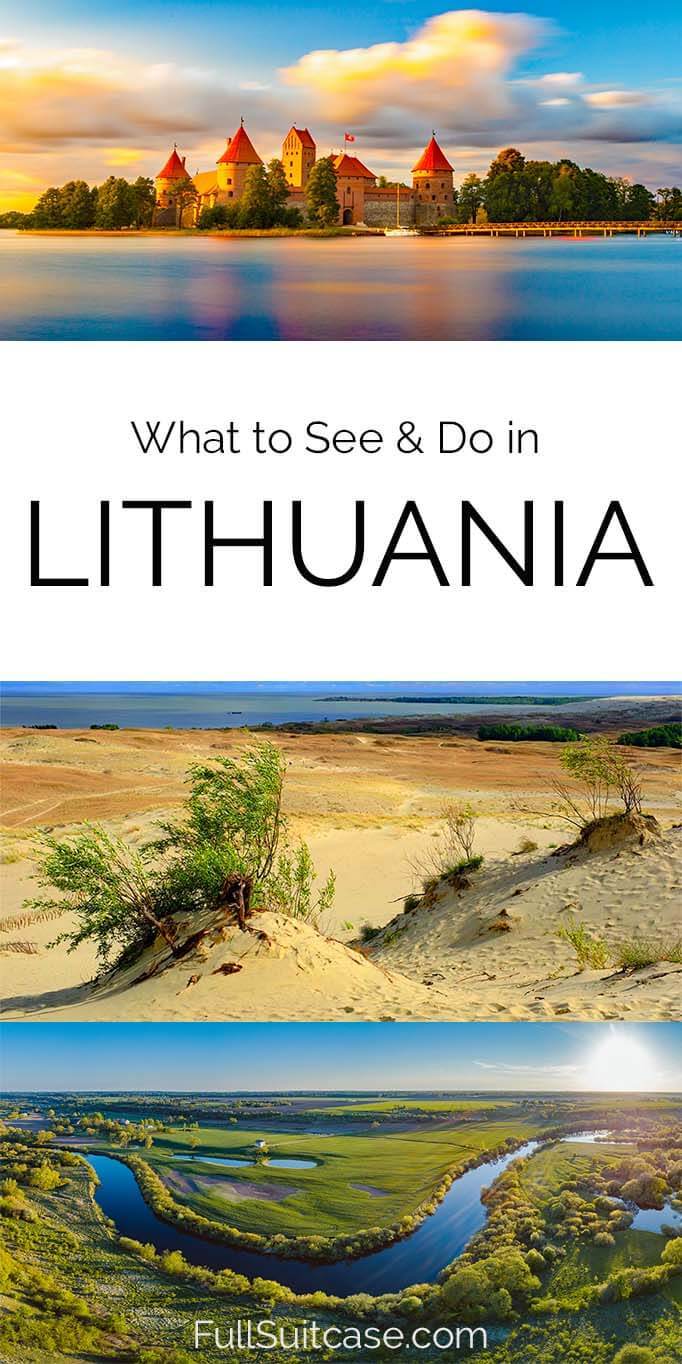
This site uses Akismet to reduce spam. Learn how your comment data is processed .
Monday 25th of March 2024
Really nice blog! We are coming by car in next July from Finland to Latvija. We stay a week in Trakai. We have been there 2019. Last time we came by plane. Now we want see more...I think we also drive daytrip to Druskininkai, We come from Riga to Trakai. From Trakai we drive to Daugavpils.
Sounds like a good plan; Lithuania is wonderful in the summer! Just beware that Trakai (especially the area around the castle) is very busy during the day. Have a great trip!
Gary Kasten
Thursday 14th of March 2024
This is such a wonder presentation. My wife and I are coming to visit. This all started many years ago when we met a gal by the name of Asta who was working in a german night club in Wisconsin Dells Wisconsin in the USA. We still maintain friendship so we are coming to your country. Asta is taking the week off to tour us around your country. She has suguested many thing she would like us to see. Now I haveto read more of your article to let Asta know of other things we might want to do, so thank you for all the information.
Friday 15th of March 2024
Glad to help, Gary, and have a great time in Lithuania!
Saturday 9th of March 2024
What a wonderful article! My husband and I are planning to ride a big loop via motorcycle from England encompassing the Baltics and Scandinavia in June and I have added many of these places to our "hopefully" list! Especially the bee keeping village and Druskininkai. I just love those beautiful little villages, we have nothing like them in Australia. Thank you for sharing these wonderful ideas!
Sunday 10th of March 2024
Sounds like a nice adventure, Georgie. Have a great trip!
Sunday 10th of July 2022
I am so excited to come across your blog and will be using it as a guide when I visit Lithuania in August. Do you recommend having a car to travel to these places - specially from the capital to the sand dunes? Also, do you recommend any healthy favorite restaurants that serve tradition food (not looking for fancy and more for authentic food)? We will be in Lithuania for 4.5 days.
Thursday 14th of July 2022
@Jurga, thank you so much for taking the time reply. Will definitely take your advice. Looking forward to the trip!
Wednesday 13th of July 2022
Hi Kanch, if you just have 4-5 days in Lithuania and want to travel all the way to the Curonian Spit from Vilnius, then yes, I definitely recommend hiring a car. We personally always use this website for car rentals. Just be sure not to speed - Lithuanian police is usually very active, especially in the areas you'd least expect it. For restaurants, there are so many restaurants serving traditional Lithuanian food all over the country (even next to the main highways). Most of them are rather simple, low-key restaurants, just like Lithuanian dishes. The best way to find them is to simply ask for recommendations at your accommodation. They usually know all the best places nearby. I also always read the reviews on Google Maps - it helps to avoid disappointments. Have a great trip!
Larry Reibstein
Wednesday 21st of April 2021
Hi -- Just discovered this marvelous blog and this article is wonderfully timely as we're planning a trip to Lithuania in 2022, Covid willing. I have a specific question and hope I'm not imposing on you. We recently discovered, through my daughter's hard work, that our family goes back to Kaunas (Kovno), your home town, with relatives found dating to 1774. I'm looking for resources either there, whom we could meet, or elsewhere that offers information on local Lithuanian ancestry and might have records we can dig into and further research. A scholar, a university office, a foundation of some sort or a government office, perhaps? Alternatively, are there travel agencies that focus on ancestry travel there? Thank you for any guidance and again sincerely hope I'm not imposing on your busy days!
Friday 23rd of April 2021
Hi Larry, I was just reading some articles in Lithuania and there are apparently some companies that specialize in this kind of research, but I have no idea how they work and what it costs, or if you can find any free info. To start with, you could try the official archives and otherwise, I think you'll just have to search online for companies/people that might be able to help you. I don't have any personal experience with this and I don't know anyone who does that. I found a websites that seems to be offering this kind of service - see True Lithuania. Also this website seems to have quite some useful info. Hope this helps, Larry, and I hope you can make that trip happen next year!

Top Things to Do in Lithuania – 25 Tourist Attractions Not To Miss
By Author Christian L.
Posted on September 17, 2021
Categories Destinations , Europe , Lithuania
It might not be the first European country you think of, but Lithuania offers a unique holiday experience for any avid adventurer. From exploring the beautiful countryside to tasting some of the locally crafted brews, this Balkan state has plenty of fun and exciting things to do.
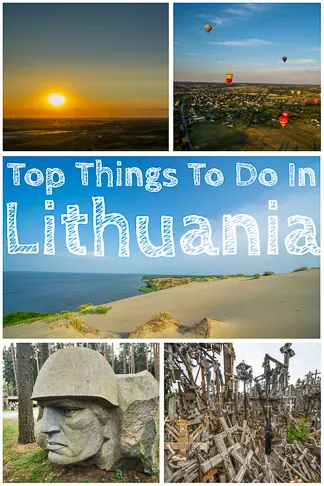
Most holidays start in Vilnius, Lithuania’s capital , but with so many great destinations on your doorstep, you would be wise to plan a broader travel itinerary. To make it easier for you, I have highlighted 25 of the best things to do in Lithuania – accompanied by Lithuanian pictures from my adventures here.
Top Things To Do In Lithuania
1. fly in a hot air balloon ride over vilnius.
This is one of the best ways to view as much of Lithuania as possible. Once you’ve settled down and are familiar with your surroundings, this is the perfect choice for adventure seekers.
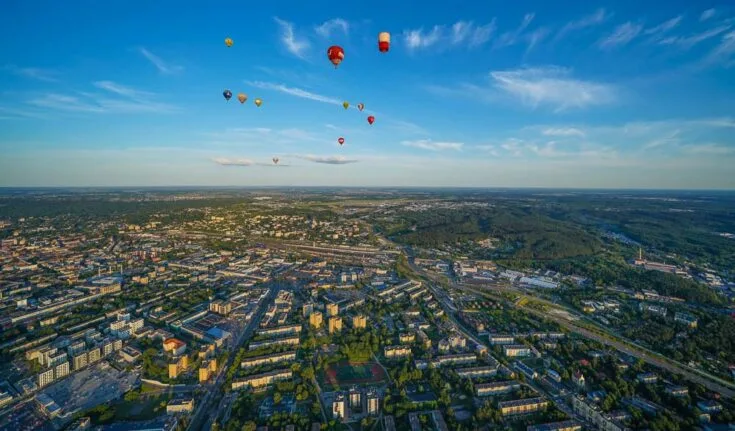
By taking a hot air balloon tour , you will be able to see all of Vilnius and the surrounding countryside without needing to walk a step. As long as you go up on a clear day, you will have exceptional views many kilometers into the distance.
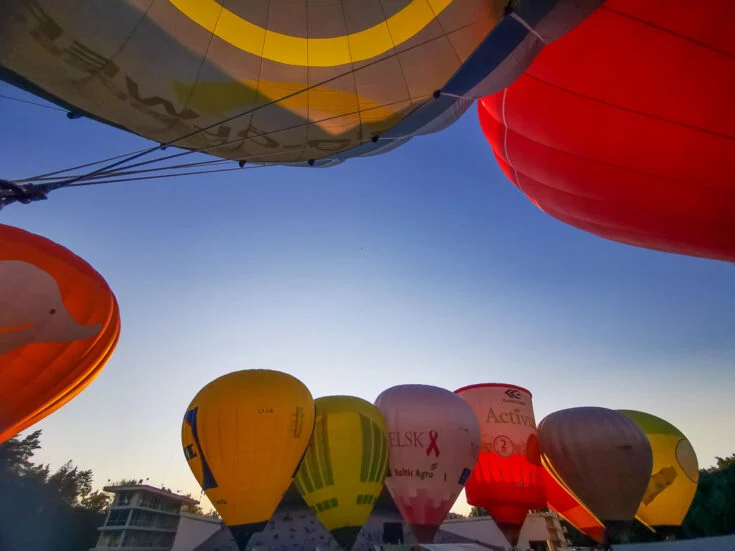
The trips can take anywhere from 1 to 3 hours, depending on which tour option you choose. The more time you spend up there, the more you will be able to see. If you’re not afraid of heights, then you’ll have a great time getting a glimpse of Vilnius from a rare and unique standpoint.
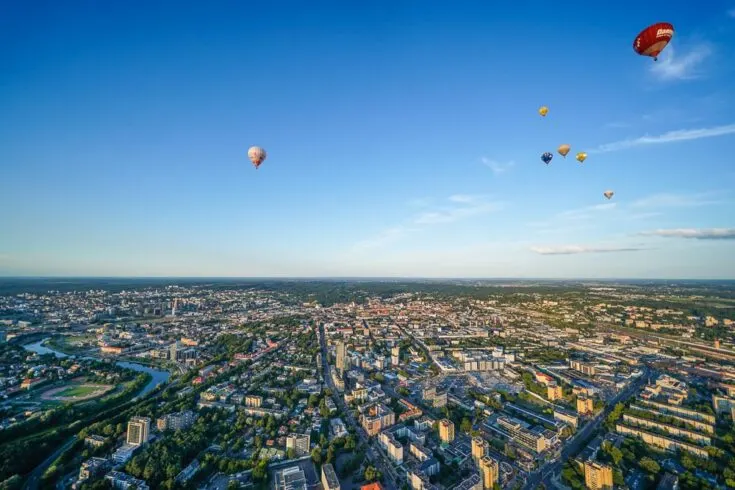
2. Plan a Pilgrimage to the Hill of Crosses
The Hill of Crosses is one of the major Lithuanian points of interest. This unique destination is covered in over 200,000 crosses and is a cultural center for both locals and tourists alike.
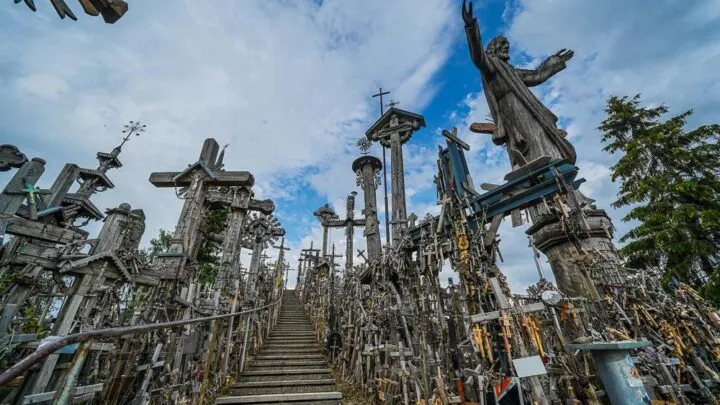
The first crosses were recorded here in 1831. Locals started erecting them as a way to commemorate loved ones who had died during the November Insurrection . This war-filled time made it difficult to locate the bodies of people who had died, so people started using the Hill of Crosses as an impromptu graveyard.
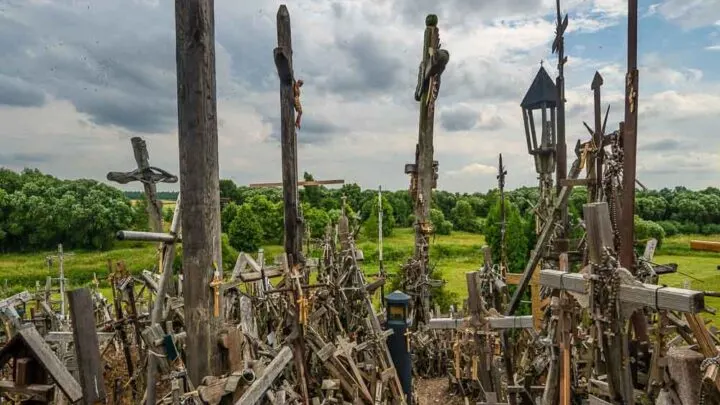
Since then, it grew into a significant part of Lithuanian culture and was used as a symbol for resistance, peace, and hope. Although the hill had been partially demolished over the years, people kept coming back to rebuild it. In modern times, locals and foreigners alike continue to place crosses and other symbols of Christianity throughout the site.
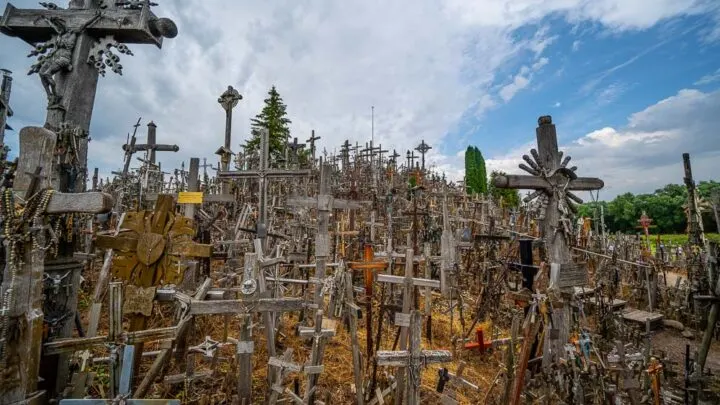
Whether you want to stay in one of the nearby cities or take a day trip from Vilnius , the Hill of Crosses is a must-see destination when visiting Lithuania.
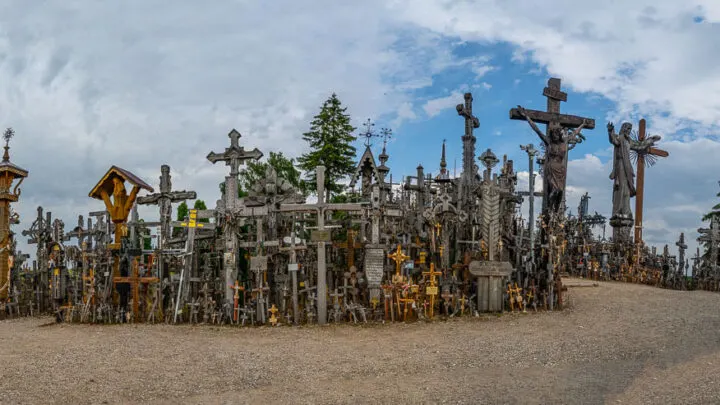
3. Canoe in the Vilnele River
Another activity for the adventurous is a guided canoe trip on the Vilnele River (also known as the Vilnia). It is one of the two main rivers that flow through the city of Vilnius and a great opportunity to explore the city and get a bit wet on a warmer day.
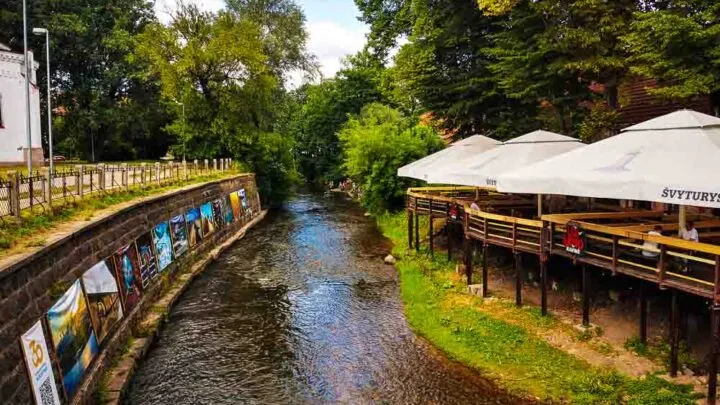
This activity is best enjoyed during the summer or early fall months when the weather is still pleasant. You’ll be taken out by your local expert, who will guide you on this 2-hour experience.
There are easy parts with flat water and then some white water sections offering more excitement. It is considered the most challenging route in Lithuania, but don’t let that scare you off – this is not a country that is known for difficult river canoeing.
4. Visit the Curonian Spit Beaches
When you think of Lithuania, golden sandy beaches might not spring to mind – but they should. The Curonian Spit is the most unique geographical attraction in the country. It is an almost 100 km stretch of dunes that cuts through the Baltic Sea from Lithuania to Kaliningrad, Russia.
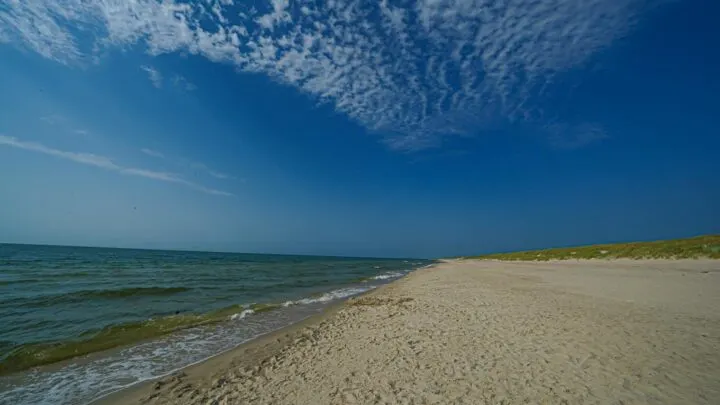
Here you will find many exciting natural activities, as well as plenty of tourists during the summer months. Even though this is a popular destination, you will not have to worry about finding a nice quiet beach to relax on. If one of the spots is too full, you can just walk a little bit further to the next one.
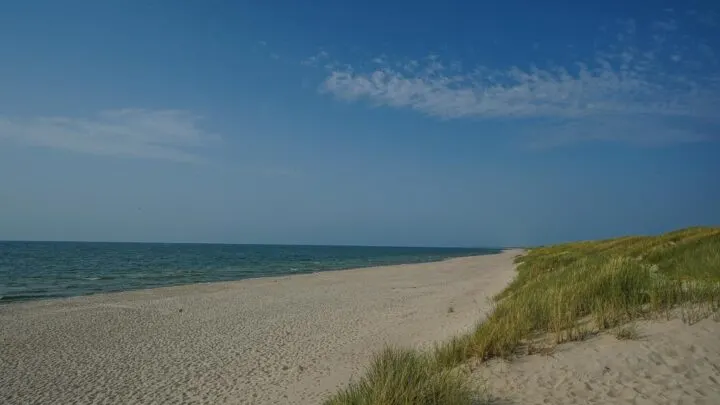
If you want to head out onto the water, you’ll have plenty of opportunities to swim, take boat rides, or walk around looking for amber gemstones that may have washed up. While lounging on the beaches all day is good enough for most people, you can find some other fun Lithuania things to do on our list in the same area.
Tip: If you don’t feel like exploring the spit on your own, you can always choose a full-day guided tour .
5. Hike Up Parnidis Dune
While visiting the Curonian Spit, the Pardanis Dune should definitely be on your list of top things to see in Lithuania. This is the most popular destination in the spit, so a must-see site on its own.
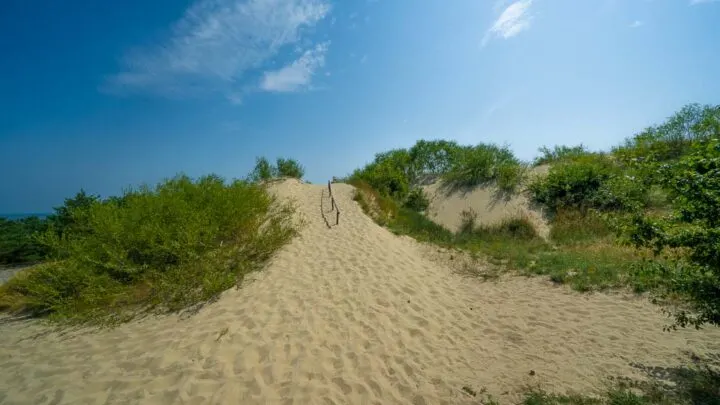
This isn’t your average dune, standing at a height of 52 meters. There is a path that will take you all the way to the top, and once you are here, you will be spoiled with some of the best views in the area. You will also find a massive sundial structure that has been built on a stone pillar. The sundial is almost 14 meters tall and weighs over 36 tonnes.
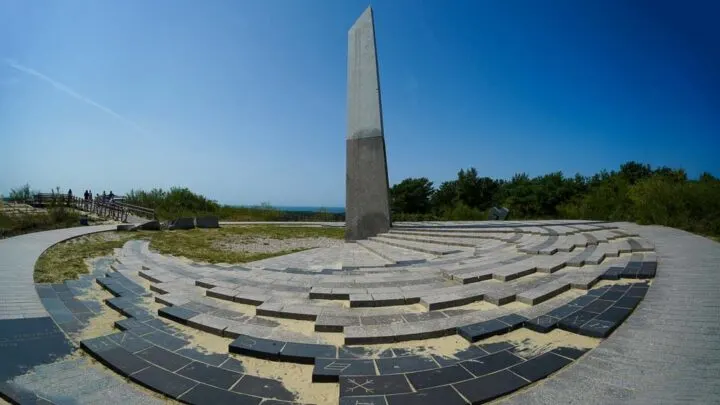
The Pardanis Dune is a wandering dune which means that it moves a few centimetres each year. Although that might not seem like much, this dune has passed through the nearby town of Nida a few times over the centuries.
6. Taste Lithuanian Craft Beer
While exploring Lithuania, you should definitely sample some of the local craft beer. When most people think of beer, they think of European countries like Germany, Belgium, and England. However, Lithuania is not one to be forgotten.
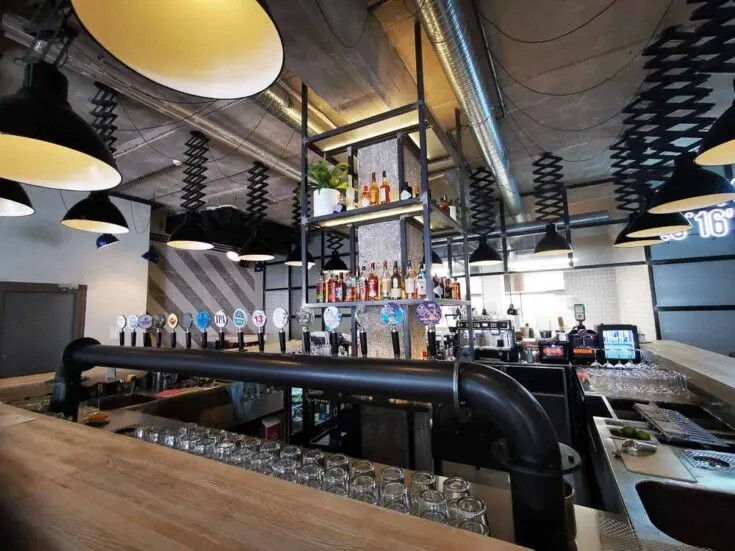
There is an ancient culture of beer making that stems back to the 11th century. Originally taught by German beer experts, Lithuanians then took on a style of their own.
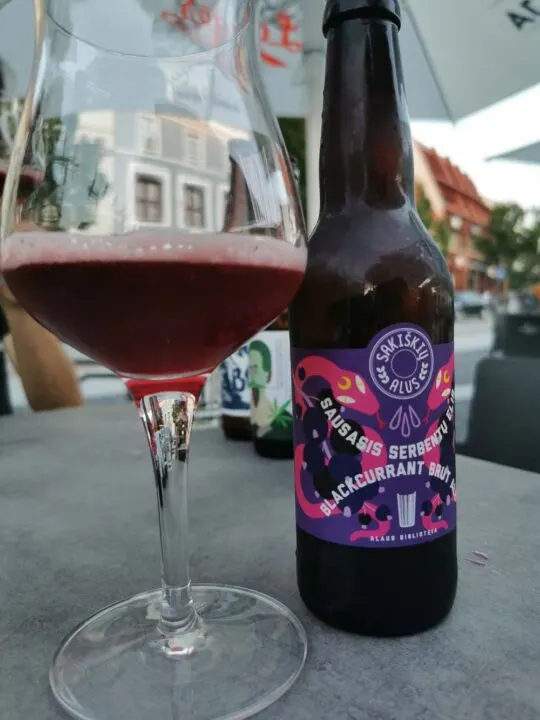
The result is some of the most unique craft beers you’ll ever taste. Beer types like kaimiskas (traditional farm-style ale), landbier, and Kvass are only some of the styles you will be able to try.
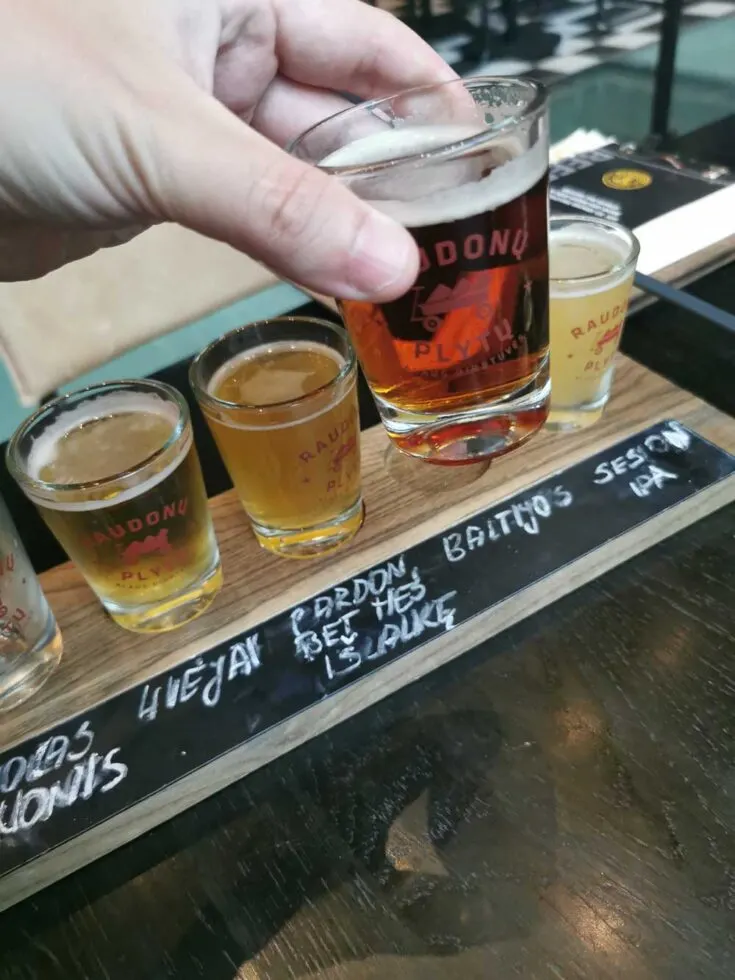
The best place to sample a wide collection of Lithuanian craft beer is in Vilnius, at one of the many beer houses. However, if you are particularly keen to explore Lithuanian beer culture, you can head to the northern regions. Here you will find many large breweries as well as traditional farmhouse brews.
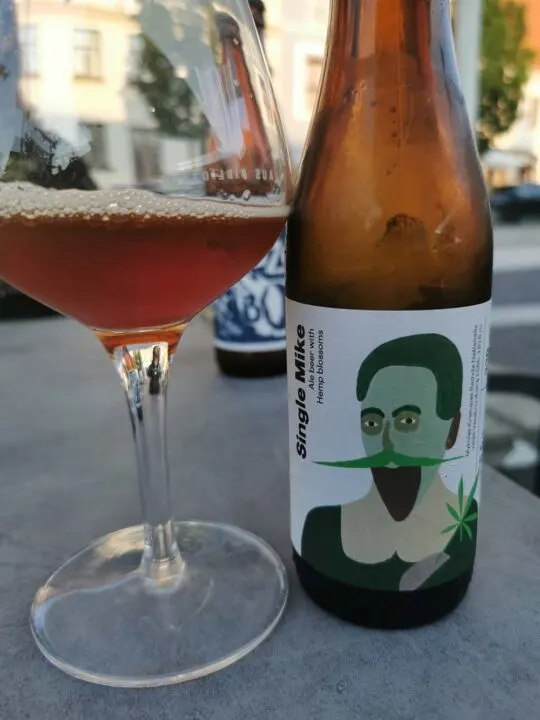
7. Stroll Through Grutas Park
Grutas Park is one of the most unique Lithuanian destinations to learn about Soviet control over Lithuania. It is a park/museum that was founded by a wealthy businessman in 2001. Almost all Soviet Artifacts that were located in Lithuania during the Soviet area is now located in Grutas Park. It’s a great place to explore by yourself or on a guided tour .
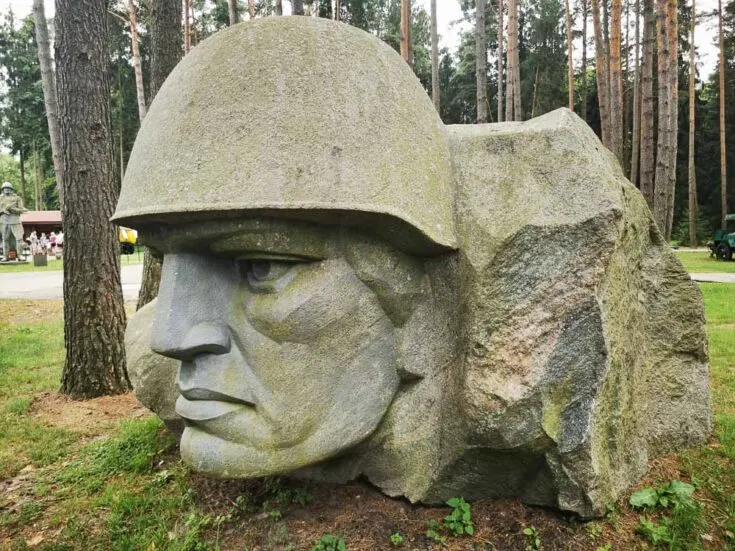
As a part of Soviet rule, many statues commemorating Soviet leaders were erected throughout the country. However, Lithuania largely resisted Russian influence, and as soon as their independence was gained (in 1991), the statues were removed from public places.
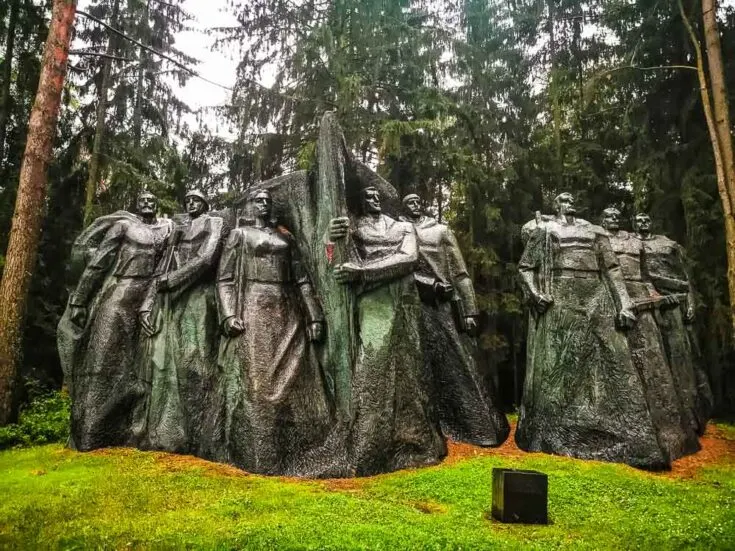
At first, the statues were scattered, but they were then collected and placed in this privately-funded museum. Today you can stroll through the gardens and take in over 80 statues from 46 different sculptors which once was located all over Lithuania during the Soviet area.
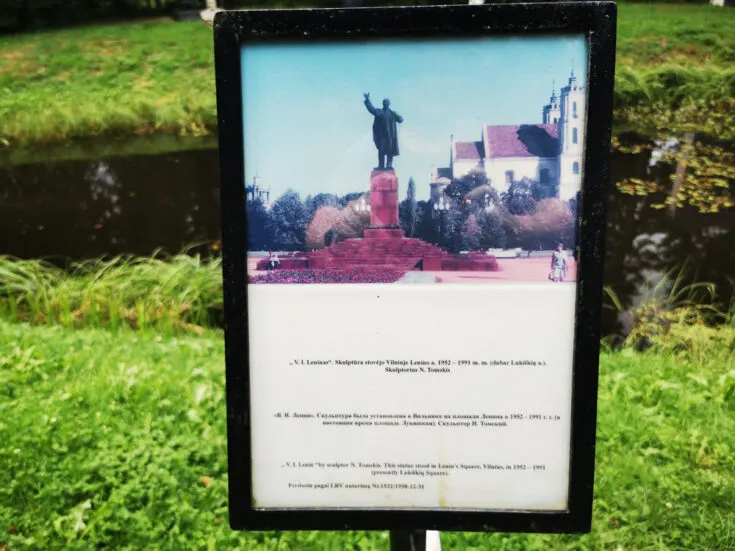
Apart from the statues, you can enjoy traditional Lithuanian pine forests, playgrounds, mini-zoos, and cafes – all of which contain Soviet-era relics. If you’re someone who has a passion for both nature and history, then this unique tourist attraction is worth a visit.
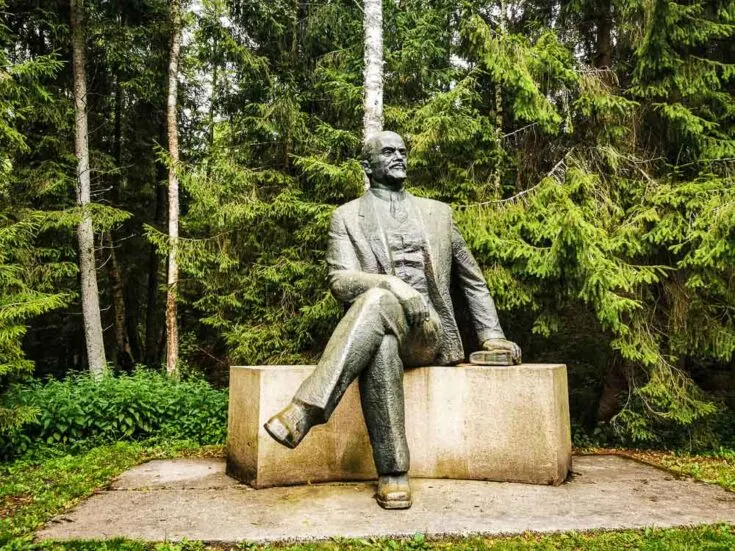
8. Explore Trakai Castle
When you’re staying in Vilnius or one of the surrounding towns, Trakai Castle is a great option to explore. This ancient site has been at the forefront of local history for hundreds of years. Originally the residence of the Grand Duke of Lithuania, the castle served as the main point of defense for Vilnius until it fell into disarray in the 17th century.
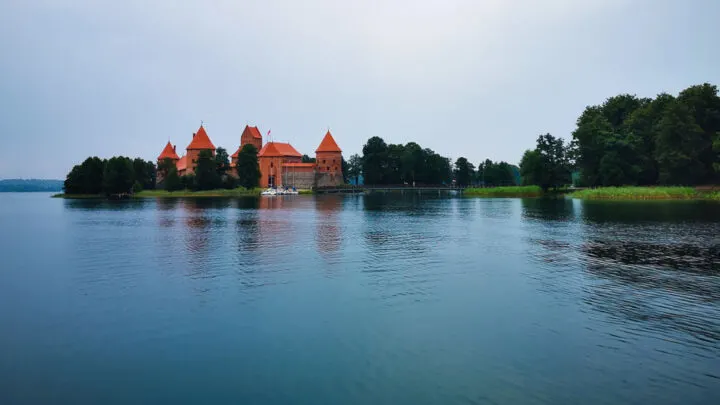
Today it stands as a museum and a place to explore what life was like during these medieval times. The castle grounds are filled with decorations dating back to the Grand Duke’s occupation, archaeological findings, and artworks. You can either explore the grounds by yourself or using one of the many guided tours that are available.
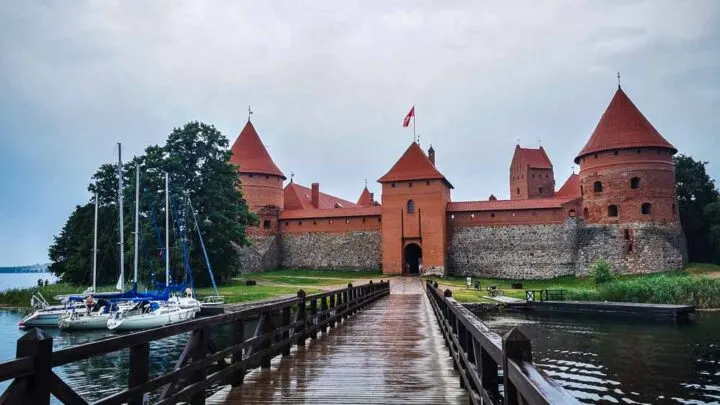
The museum isn’t the only way to experience the castle. In summer, the large grounds burst into life with both music festivals and converts hosted here.
9. Visit the Palace of the Grand Duke of Lithuania
Another piece of ancient architecture that should be on your list of what to see in Lithuania is the Palace of the Grand Duke of Lithuania. The palace is part of the Vilnius Castle Grounds, along with the remains of Vilnius Castle and Gediminas’ Tower. Together they form a magnificent attraction for any history lovers visiting the city.
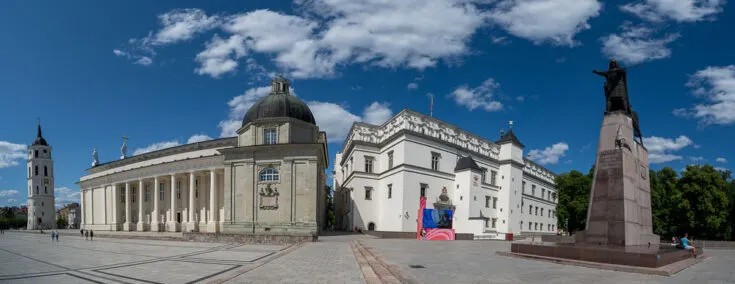
The current palace is a reconstruction, with the original building having been demolished in 1801. It was completed in a renaissance style to match the last remodeling that took place in the 16th century (as well as the nearby Vilnius Cathedral).
Archaeological evidence suggests the site had been used for a long time before the palace was erected. The buildings were remodeled and improved throughout the height of the Grand Duchy of Lithuania and reached their height during the reign of Sigismund II.
Walkthrough the grounds and the palace itself while you take in the magnificent architecture and glimpse back into the opulent lives of the Lithuanian royalty.
10. Step Back in Time at Dino Park
Families and dinosaur lovers alike should make sure to head to the city of Radailiai to visit the famous Dino Park. While most of the activities on this list might be better suited to adults, this is great for the whole family.
The amusement park is filled with over 50 different animated moving and roaring dinosaurs – but don’t worry, they won’t bite. These lifelike prehistoric giants will give you the perfect opportunity to get up close and personal.
Apart from the dinosaurs, you can also try some of their other forms of entertainment – like a 5D cinema, electric cars, and a mirror labyrinth. There are places to eat and snack while exploring the grounds, so you can take your happy time.
11. Take Photos in the Radailiai Upside Down House
Located just 13 km outside of Klaipeda, inside the Radailiai Dino Park, you will find the Upside Down House. This is a popular day trip for tourists and locals who are staying in the area and is a great place to visit with kids while exploring Dino Park.
The Radailiai Upside Down House is exactly as the name suggests – an upside-down house. This type of attraction has become very popular worldwide and is a unique experience where you will get plenty of selfie-worthy moments.
Stroll around a house where all the household appliances will be hanging from the rooftop – don’t worry, they won’t fall on you. It’s a truly bizarre place that acts as a life-size art exhibit. If weird and wonderful things interest you, then get your tickets and start snapping photos.
12. Experience Magic at the Vilnius Museum of Illusions
Few places offer the same level of mystery and satisfaction as the Vilnius Museum of Illusions. Most of the museums that you find in Vilnius or throughout Lithuania are focused on local history or culture – but not this one. Here you will be able to entertain your inner child and be mindblown by various optical illusions and unique exhibitions.
It’s a great place to bring the family, and any children under 7 years old can accompany an adult for free (max 3 kids per adult). The price is reasonable at $13 per adult and $10 for students/seniors.
If you need some help navigating through the museum or understanding some of the exhibits, you can just ask one of the helpful staff for help. The Vilnius Museum of Illusions is the perfect spot for a more unconventional Lithuanian experience.
13. Stop at Klaipeda Old Town
Klaipeda, Lithuania , is a unique town with German-influenced architecture found en route to the Curonian Spit. If you are planning a trip to the famous Baltic beaches, this is a great stop on the way with plenty of comfortable accommodation options available (like the Amberton Hotel ).
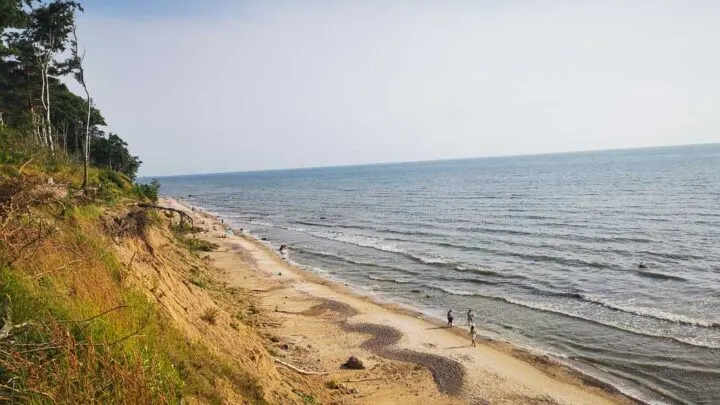
The town itself is small but rarely gets overcrowded. Take your time walking through the cobblestone streets as you observe a type of architecture not found anywhere else in Lithuania. This is due to Germany’s control of the area during WWII.
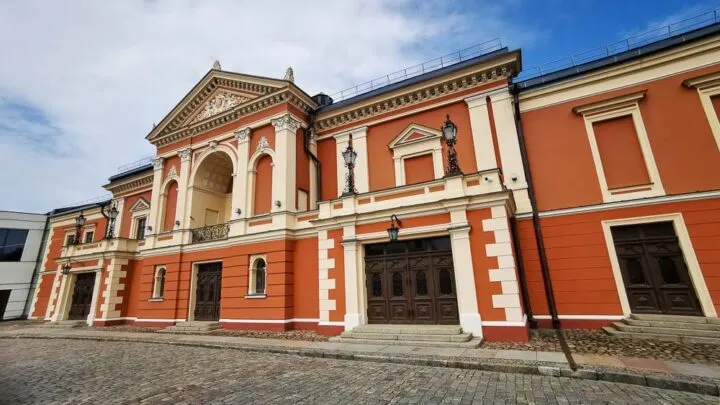
While exploring the town, make sure to check out two of the most popular spots – Turgaus Gatve and Theatre Square. The latter is where Hitler is said to have announced the town’s annexation.
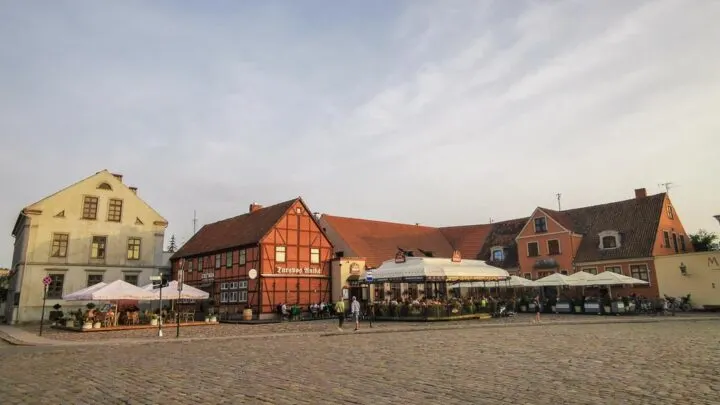
Friedricho Pasazas is another great place to visit during summer. Here you can spend the afternoons in an open-air courtyard listening to live music performances while eating local cuisine amongst both locals and tourists alike.
14. Kaunas, Lithuania
Kaunas is the second-largest city in Lithuania and was the first city in eastern Europe to be declared a UNESCO City of Design . This is thanks to the European Art Deco style of architecture that was adopted after World War I.
When the city went through this period of modernization, the culture surrounding it also adapted. There is a cafe culture in the city, where you will find plenty of coffee shops with tables spewing out into the surrounding streets. It’s a lovely place to walk around and just take in the local atmosphere.
When you’re not getting lost in exploration, you can also check out some of the many popular Lithuanian attractions found throughout the city. Some of the most noteworthy include the Ninth Fort, Pazaislis Monastery, Kaunas Castle, and the Devil’s Museum.
15. Pažaislis Monastery
The Pažaislis Monastery is one of the most magnificent churches in the country. Situated on a peninsula extending into the Kaunas reservoir, this destination is a prime example of Baroque architecture.
The grounds are massive, and walking up to the large charge is an experience on its own. Once you walk inside, you will be greeted with marble decorations and ceilings painted with frescos dating back to the 17th century.
One of the things that are so impressive about this church is that its artwork and marble decorations have survived countless wars, changes in ownership, and theft. This is now a popular tourist destination, managed by a convent.
If you visit between the summer months of June and September, you also be able to attend the Pažaislis Music Festival. Three months of concerts are held on the grounds – but not inside the actual church. It has been a tradition since the 1960s and still remains a popular event that attracts thousands of visitors.
16. Visit the Devil’s Museum
Don’t let the name scare you. The Devil’s Museum is one of the stranger things to do in Lithuania and perfect for those who love eerie artwork. The museum itself is not at all creepy; it’s just the type of artwork that is on display that might make you squirm.
You can find interesting pieces depicting devils, wizards, witches, and plenty of other mythological monsters. Although the content might not be of interest to you, the artwork itself is very well done and worth a look.
The museum was opened after the founder of the collection’s death in 1966. At the start, there were 260 pieces on display. However, after the public caught wind of this creative collection, more and more people started donating their own pieces.
By the mid-80s, a three-story extension had to be built to house all of the pieces. And, by 2009, there were over 3,000 items on display. There are more than enough artworks for you to spend a few hours wandering around the house.
17. Church of St. Anne, Vilnius
As far as churches go, Vilnius is definitely the number 1 destination in Lithuania. With a total of 28 churches (1 church per 700 inhabitants), you’ll need to spend more than one day exploring the city to see them all.
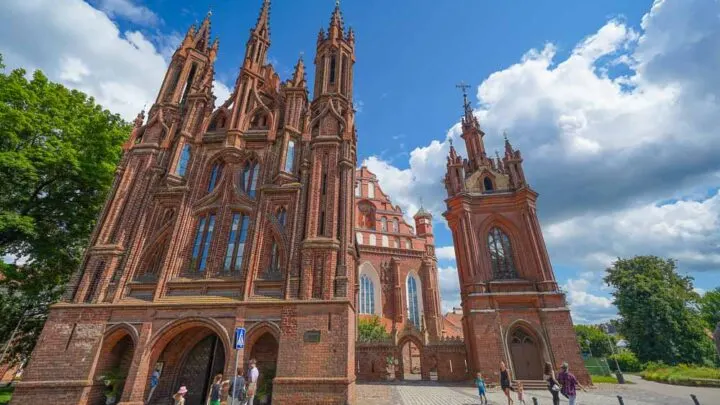
If you are limited on time, the Church of St. Anne is one of the main ones worth visiting. It is only a 10-minute walk from Vilnius Cathedral and offers a gorgeous Gothic design with characteristic red walls, two towers, and a nave.
The original church was built from wood in the 15th century, but it was only during its rebuild in the 16th century when it became a prominent feature of the city. 33 different types of clay brick were used in its construction, which were then painted red. Inside you will find beautiful Baroque-style decorations along with an impressive altar.
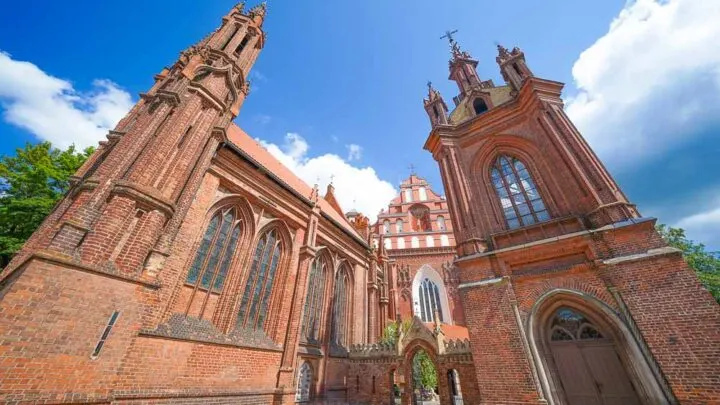
Although it is not the main Roman Catholic Church (those honors go to Vilnius Cathedral) since 2018, it has been used to celebrate Mass according to the traditional Roman rite. Once you’re finished exploring the church, you can climb up the neo-Gothic bell tower next door, which was constructed much later in the 1870s.
18. Go Underground at Plokstine Missile Base
Have you ever wondered what an underground missile silo looks like? Well, then Lithuania has the perfect museum for you. For a small fee, you can head straight into the first Soviet Union nuclear missile base.
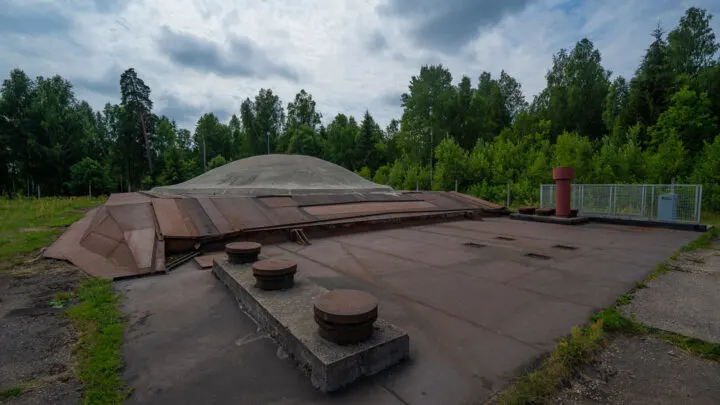
Although most of you might never have heard of the Plokstine Missile Base, it is where the Cuban missile crisis nuclear warheads came from. They were transported from here to Sevastopol, where they were then loaded on a ship headed to Havana , Cuba .
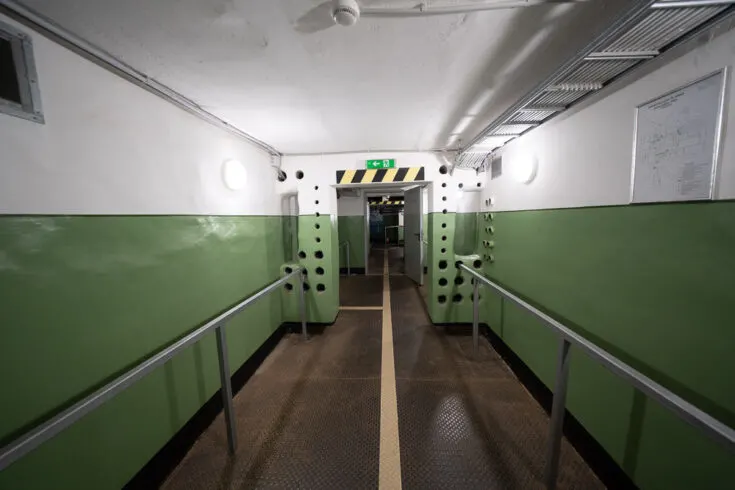
The silo is located in the Plokstine forest in northwest Lithuania. The site was chosen because of its remoteness, which does make it slightly more effort to visit – but still an important historical destination.
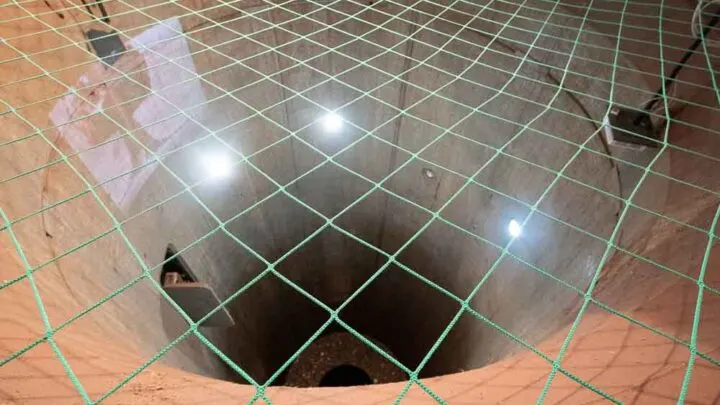
Plokstine Missile Base was decommissioned in 1978 and remained abandoned for many years, where it suffered from metal theft. Luckily, in 2012 the cold war museum was opened here, allowing the history of that era to be preserved.
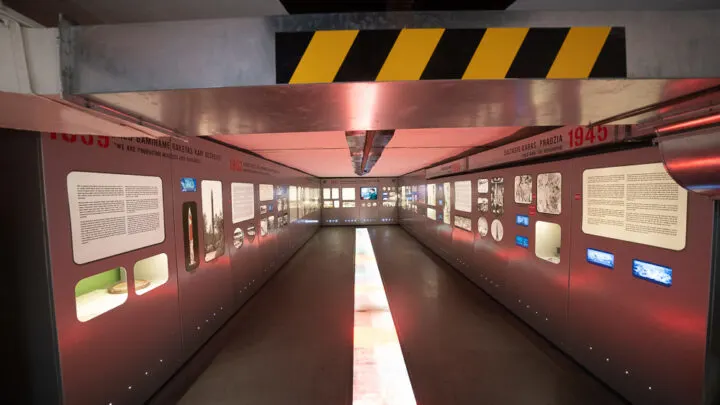
19. Visit the Self-Proclaimed Republic of Uzupis
Did you know there is a self-declared republic inside Vilnius? The Uzupis Republic declared its independence on the 1st of April 1997 and is an art-focused town that is definitely worth the visit.
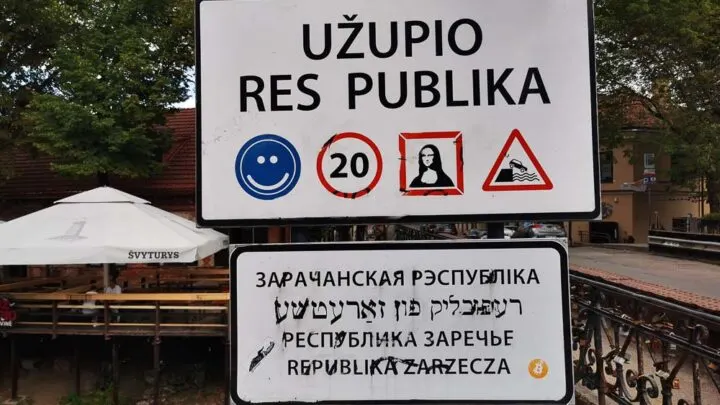
Artists have favored this part of Vilnius for a long time, and as a result, the neighborhood has transformed into an art-focused bohemian destination. Although it’s small (only 0.6 square km), you can easily fill up a day exploring all of the local hotspots.
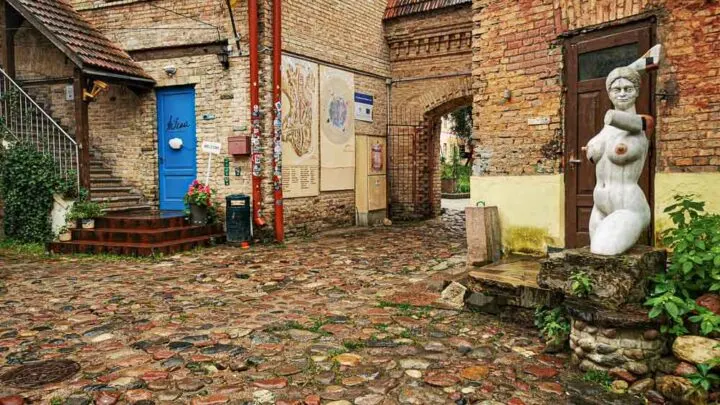
Whether you’re walking along the Vilnele River, spotting the legendary local mermaid or visiting the art incubator to see all the amazing creations, Uzupis is a great holiday destination. Of all the sculptures you’ll see in the republic, make sure to spot the bronze archangel Gabriel in the town square.
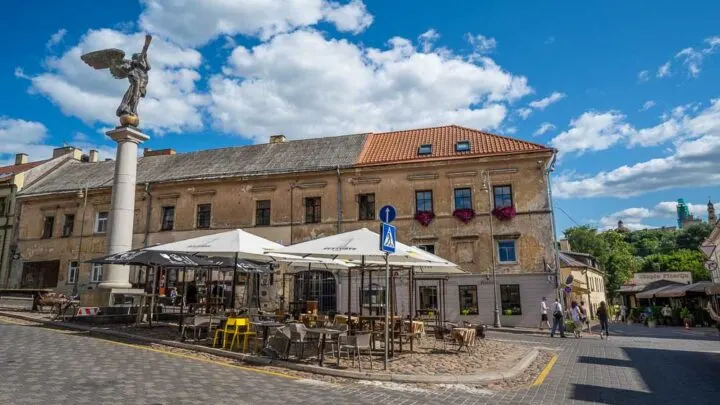
20. Pay Respects at Vilnius Cathedral
When you’re exploring the old town of Vilnius, the main cathedral is a worthwhile stop. Although it isn’t the only church in the city, it’s by far the biggest and most beautiful. It’s also very close to the Vilnius Castle Grounds, which makes it great to include on a day tour.
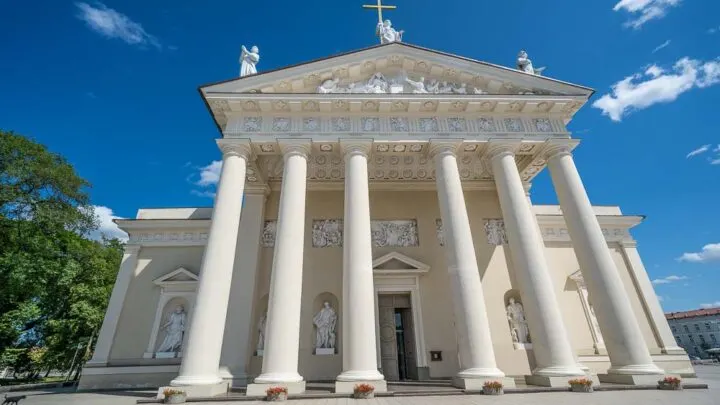
The magnificent white walls and detailed interior are the main attractions, but you can also walk up the Vilnius Bell Tower to get some incredible panoramic views of the surrounding areas. The entrance to the tower is just outside the main entrance.
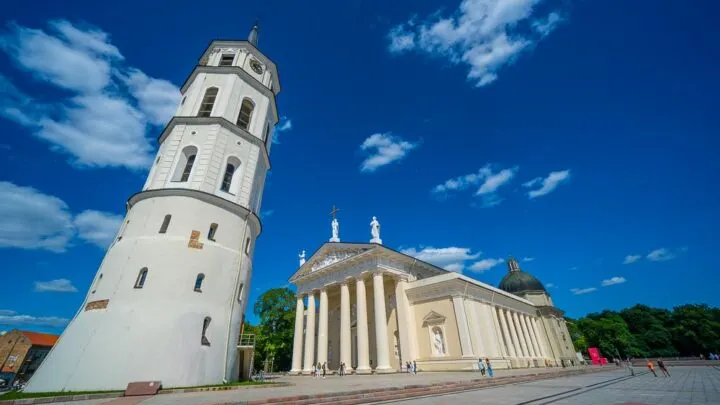
Vilnius Cathedral has had a long history since its inception in the 13th century. Originally a Gothic-style church, it was rebuilt towards the end of the 1700s in its current Neoclassical style. It’s a great destination to appreciate the struggles Vilnius has faced and overcome over the centuries.
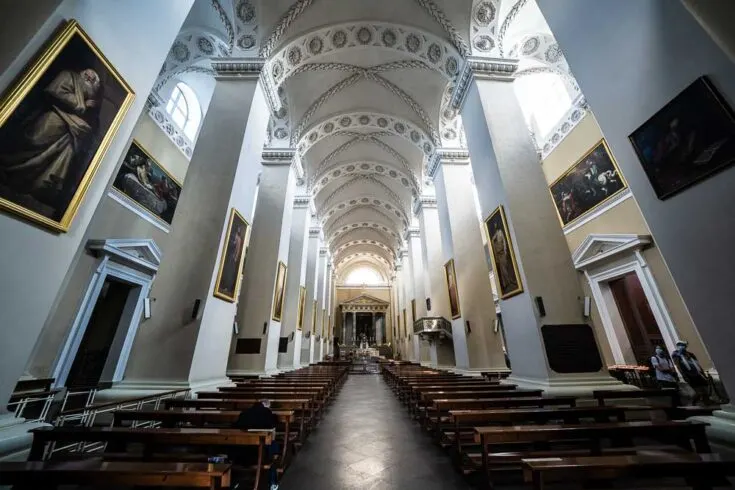
21. Go Skiing in Lithuania
This northern European country might not be as famous for skiing as France or Switzerland, but it still offers many wonderful opportunities. Not only can you ski here in winter, but there is also a state-of-the-art indoor venue available all year round.
The Snow Arena is a popular destination in the south of Lithuania, just outside Druskininkai. It’s a 2-hour drive from the capital and is a very relaxing area known for its spas and tranquility.
Although most tourists prefer to visit Lithuania during summer, if you are here during the colder months, you will have access to many more skiing locations. When in Vilnius, you can travel just outside the city to the Liepkalnis entertainment area. Here you will find snowboarding and skiing in the winter or mountain biking, climbing, tubing, or tobogganing in summer.
22. Relax in Druskininkai
What is a holiday without a bit of relaxation? If you need a break from the hustle and bustle of the major cities, head over to Druskininkai in the southern part of Lithuania. It is located just over a 2-hours drive away from Vilnius and has been a popular spa destination since the 19th century.
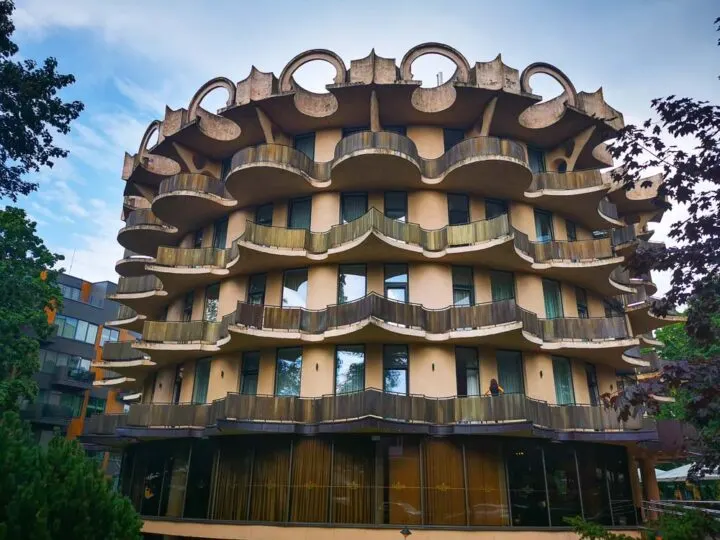
Like much of Lithuania, the history of Druskininkai has been fraught with warfare and enemy occupation. Despite all the hardships, the town maintained its focus on relaxation and spa life. It started growing into the popular spa town that it is today after WWI and has continued to be a major destination for people from Lithuania as well as neighboring Poland, Belarus, and Russia.
There are plenty of exciting events and attractions to visit in the town. If you aren’t relaxing in a spa, you can visit the first water park opened in Lithuania, the Grutas Park Soviet Memorial, or go skiing at the indoor Snow Arena. The annual Druskininkai Poetic Fall and International Art Festival are also great ways to experience the local culture.
23. Visit the Lithuanian National Opera & Ballet Theatre
Lithuania’s history of ballet and opera is not as longstanding as some other European countries, but the culture has developed thanks to the Lithuanian National Opera & Ballet Theatre (LNOBT). It was opened in 1974 and is the largest theatre of its kind in the country.
The modernly designed building in Vilnius is a place to learn more about ballet and opera in Lithuania, but you can also attend shows here. It is still a fully functioning theatre with events hosted throughout the year. You can book tickets online, with prices ranging from $20 to $70 depending on the event and your preferred seating.
In Summer, the LNOBT moved some of their events to an open-air theatre erected in Trakai Castle. This is a popular attraction that has been going on since its inception in 2001. It’s a great opportunity to get outside on a warm Lithuanian day and experience local culture and art.
24. Take the Train up Gediminas’ Tower
Gedimimas’ Tower is considered the birthplace of Vilnius. The hill where the tower is located is where Grand Duke Gediminas had his vision for the settlement. Although not much of the original structures remain, the tower is still a beacon of history and an important landmark of Vilnius.
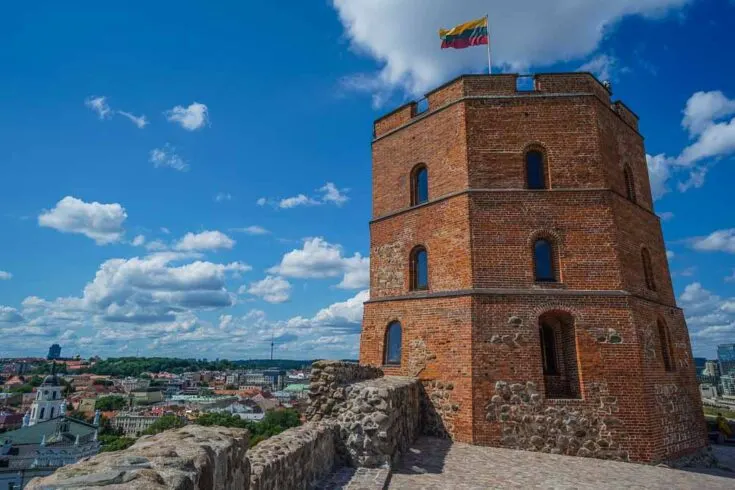
It is located on the same grounds as the Palace of the Grand Duke, so it can easily be viewed on the same day. Once you reach the top, you will be able to enjoy some of the best views of the city. If you aren’t a fan of walking up hills, don’t worry, there is a functioning train that can take you up/down.
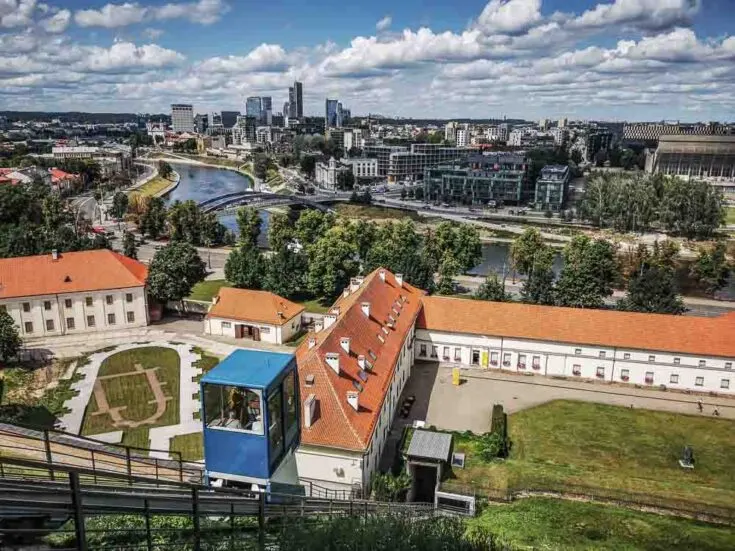
Inside the tower, you will find a small museum showcasing the history of the surrounding area. Archaeological findings are displayed as well as the different designs of Vilnius castles that were prevalent throughout the 14th to 17th centuries. Few places to visit in Lithuania offer such an in-depth glimpse into the country’s past.
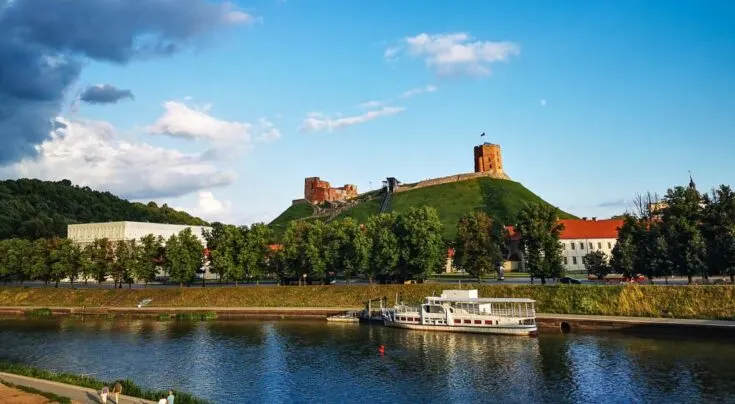
25. Hangout at the notorious Lukiškės Prison
Once one of the most notorious prisons under the Soviets, now the new cultural hub in Vilnius with art gallery, concerts, and a bar.
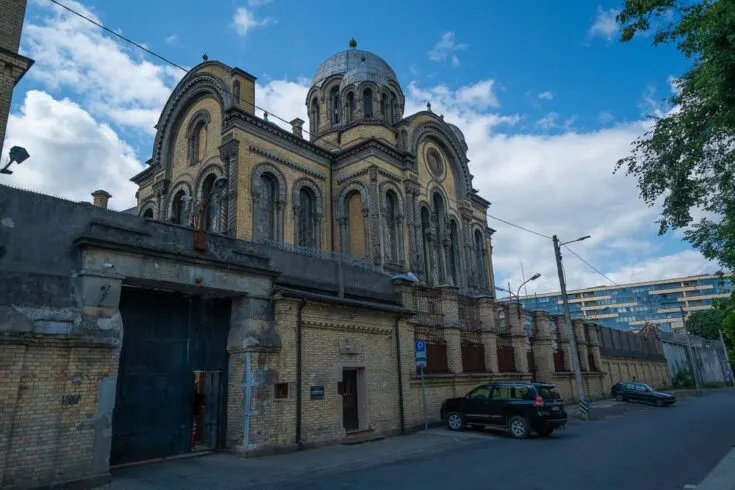
Once the most notorious prison in Lithuania until the prison was officially closed on 2 July 2019.
The prison opened up in 1904 when Lithuania was part of the Russian Empire. It was also used by the Germani Nazi s occupation of Lithuania during WW2 when it was used by the Gestapo as a holding cell for thousands of Jews.
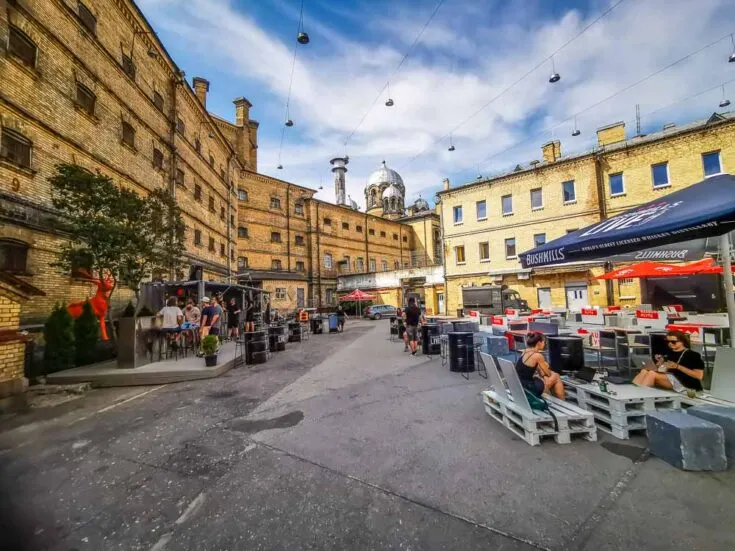
Now the prison has reopened under the name Lukiškės Prison 2.0, which these days offers everything from art studios which is used by around 250 famous local artists. You can also tour the old prison with some of the old prison guards working as guides in prison now, (you will hear some crazy stories from their own experience working in the prison during the time it was a notorious prison,
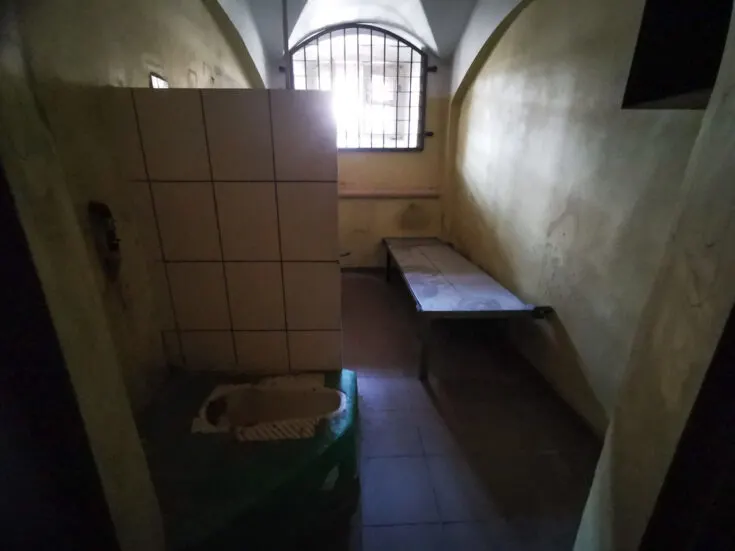
Visit Lithuania Tourist Attractions
Lithuania is truly an unconventional European holiday destination. The curious combination of Balkan culture and modern European architecture is one of its major selling points.
Learn about the Soviet occupation of the country, sample some of the local’s sensational craft beer, or just spend your day relaxing on white sandy beaches. There are so many fun things to see in Lithuania that you will want to visit again and again.
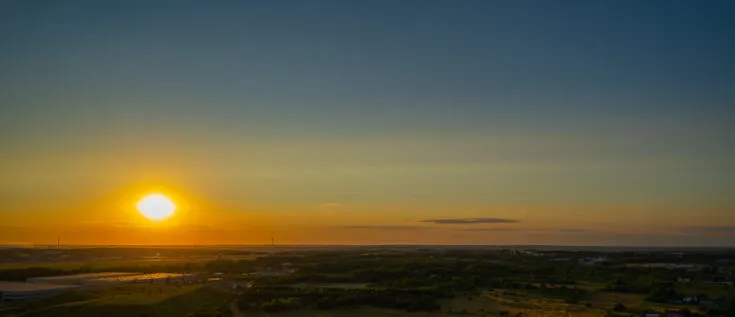
Now that you know exactly what to do in Lithuania, I hope you enjoy your time here as much as I did. If you find any other great things to do in Lithuania that I haven’t mentioned, please let me know in the comments section below.
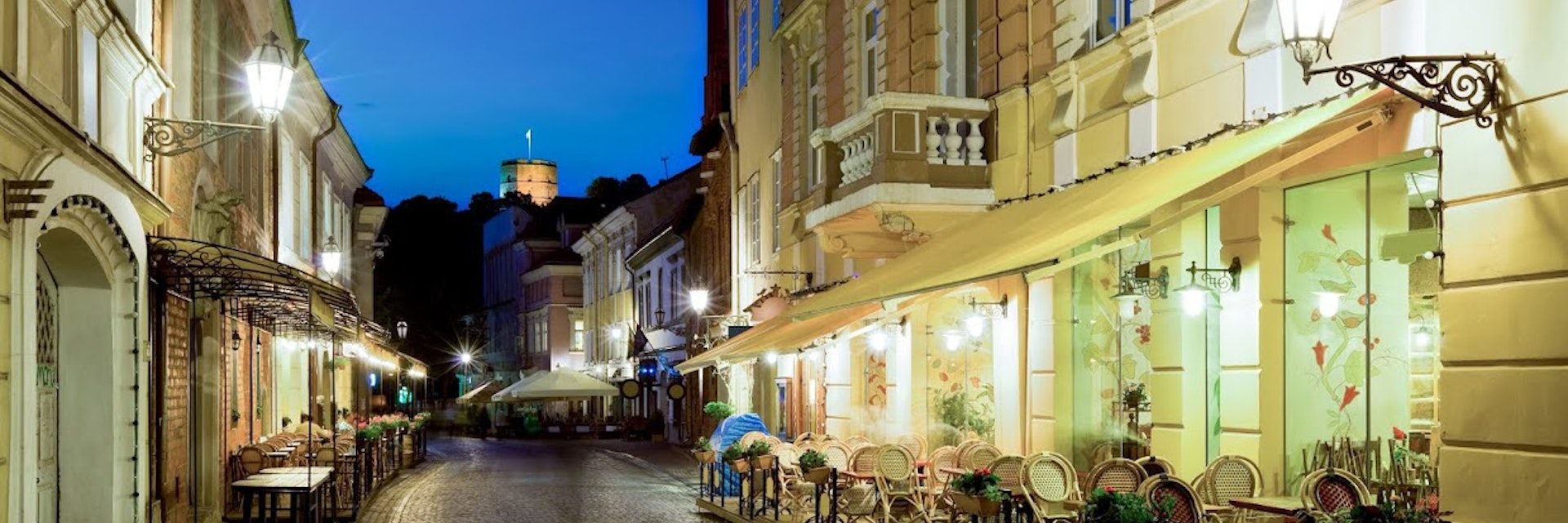
Blame it on the Baltic sea breeze or the almost-endless midsummer days: Lithuania has an otherworldly quality. In the southernmost of the Baltic states, beaches are spangled with amber and woodlands are alive with demonic statues. Medieval-style mead and traditional wood-carving never went out of style.
Leave the planning to a local expert
Experience the real Lithuania. Let a local expert handle the planning for you.
Attractions
Must-see attractions.

Hill of Crosses
Lithuania's fabled Hill of Crosses is a symbol of defiance as much as a pilgrimage site. More than 100,000 crosses have been planted on this low hill,…
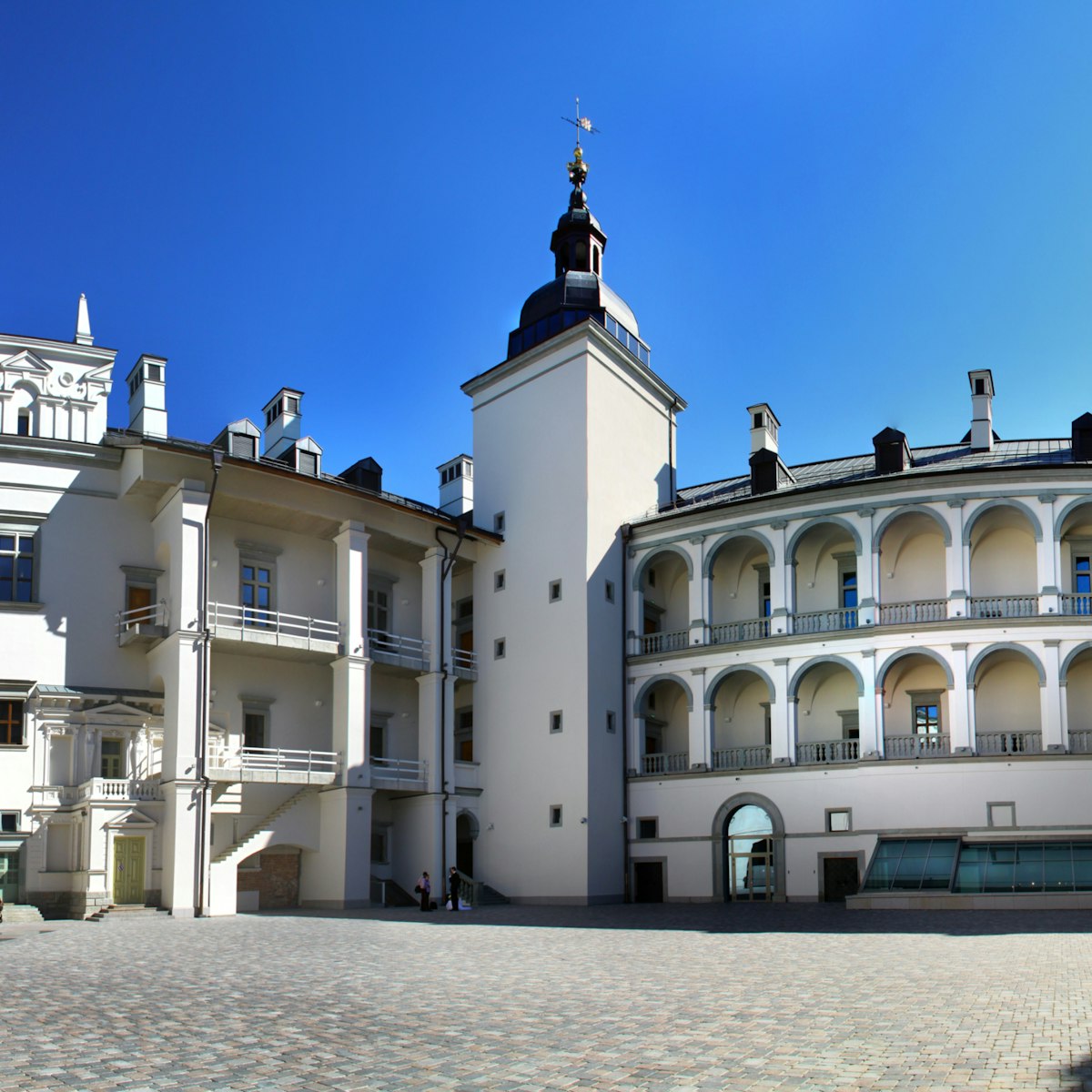
Palace of the Grand Dukes of Lithuania
If you only see one museum in Vilnius, make it this one. On a site that has been settled since the 4th century AD stands the latest in a procession of…
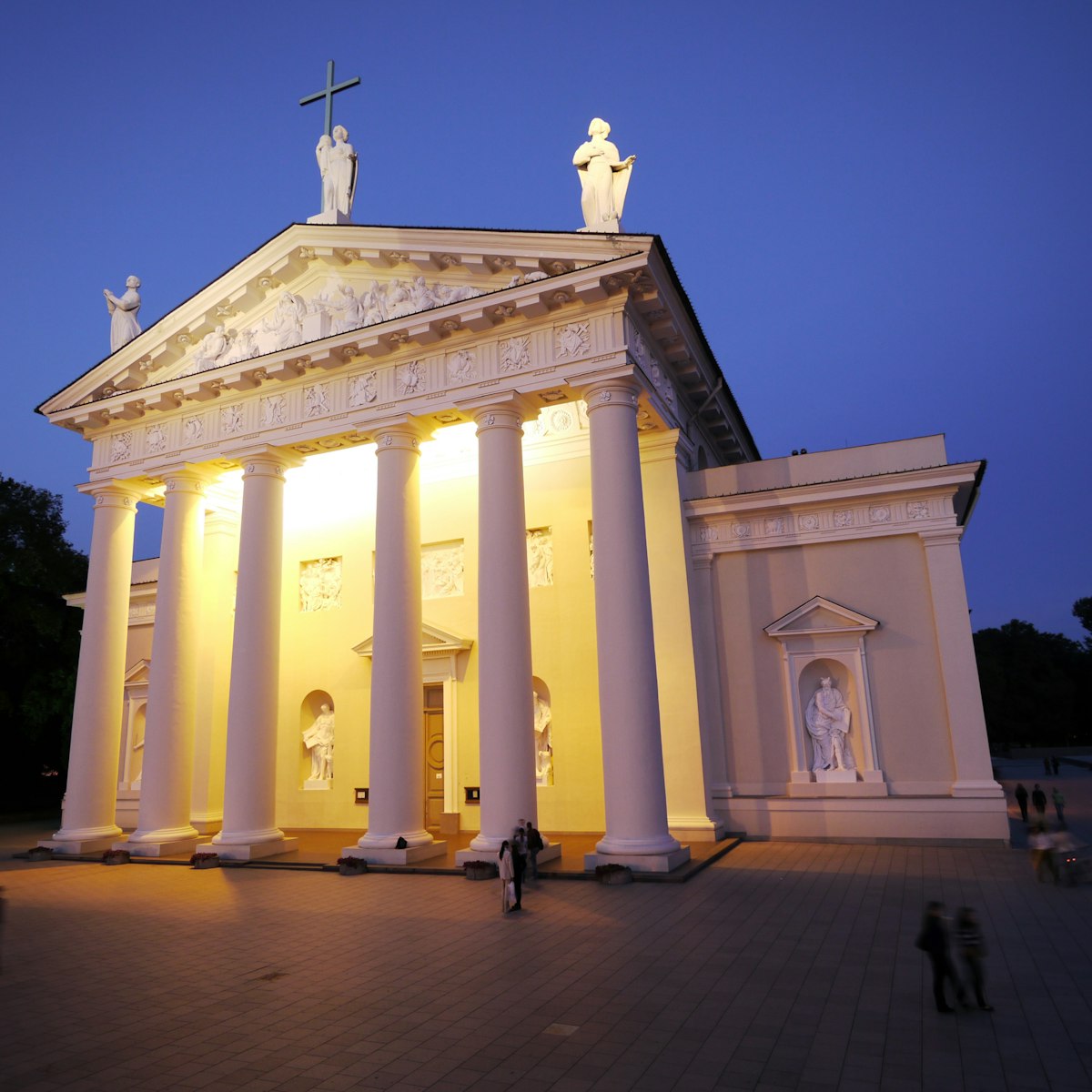
Vilnius Cathedral
Stately Vilnius Cathedral, divorced from its freestanding belfry, is a national symbol and the city's most instantly recognisable building. Known in full…
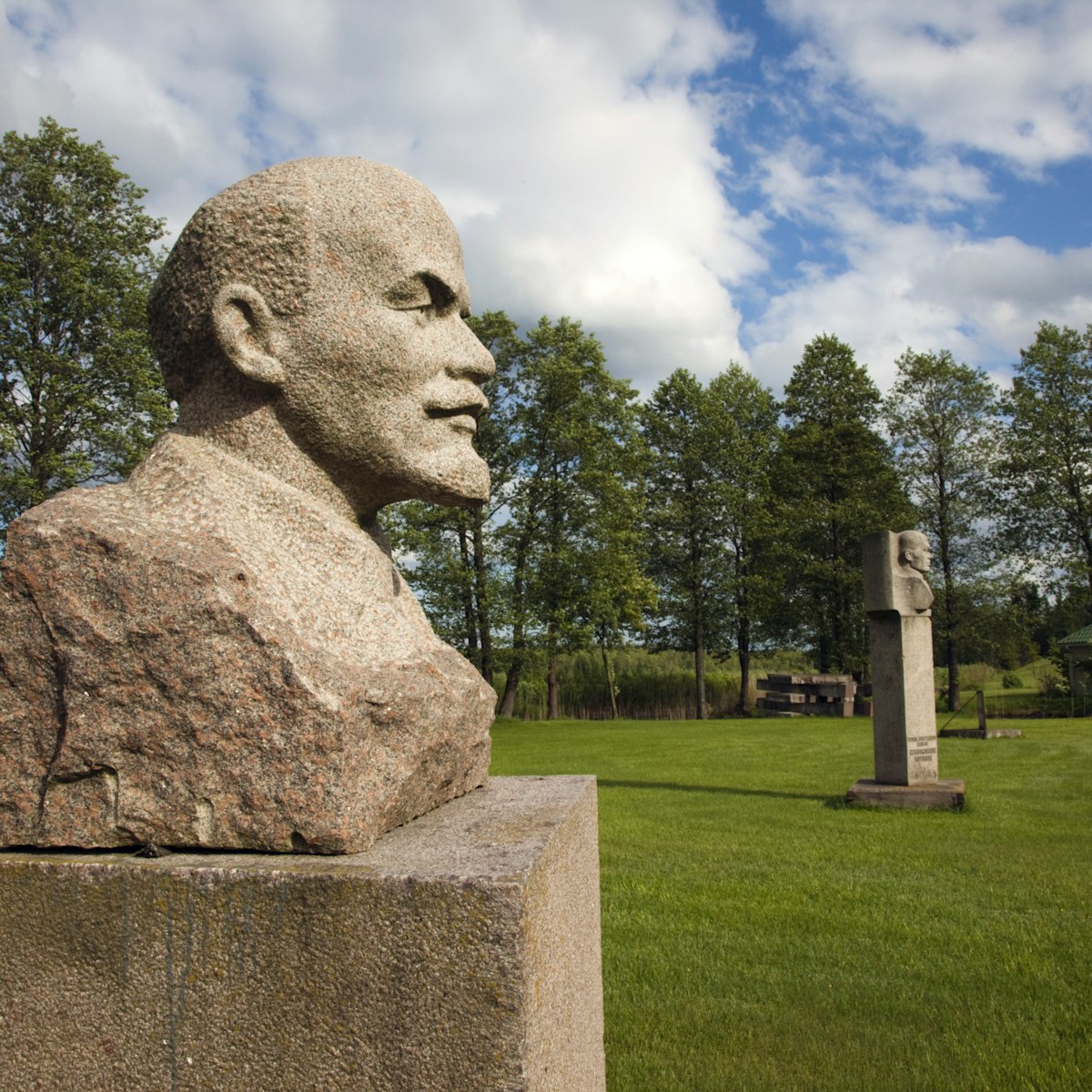
Grūtas Park
With Soviet-era statues of Lenin, Stalin and prominent Lithuanian members of the Communist Party that once dominated Lithuanian towns lining the forest…
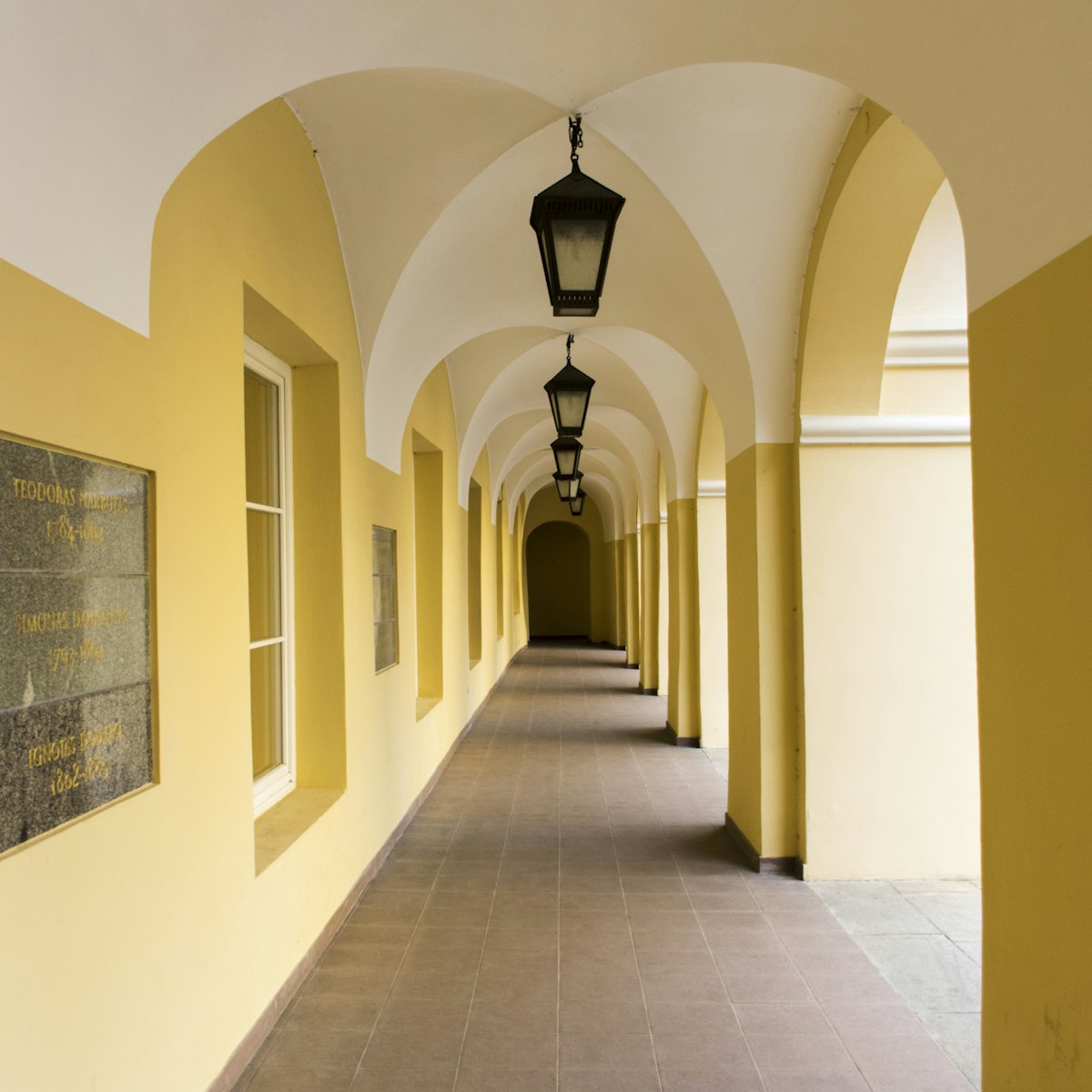
Vilnius University
Founded in 1579 during the Catholic Counter Reformation, Vilnius University was run by Jesuits for two centuries. During the 19th century it became one of…
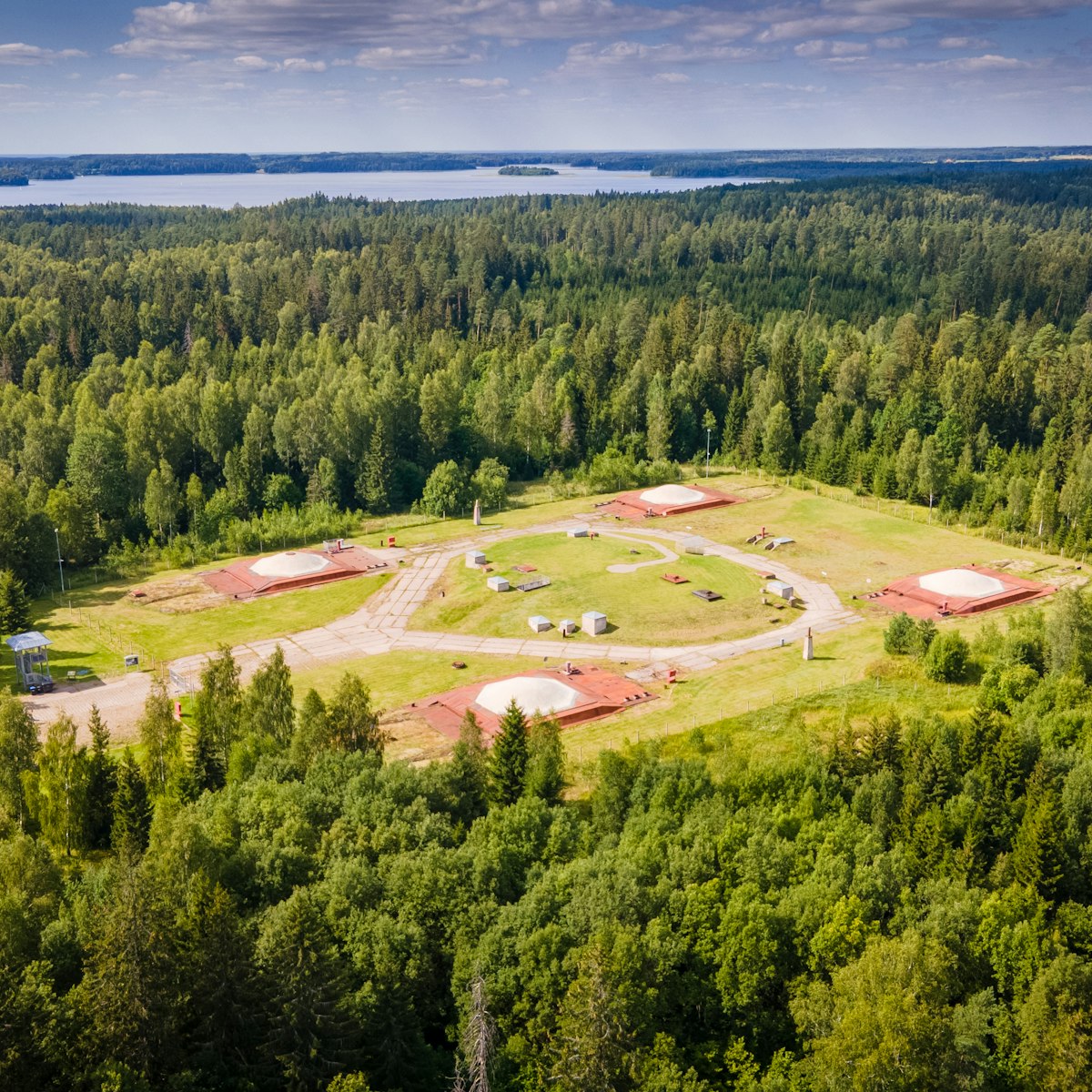
Cold War Museum
This museum on the site of a former Soviet nuclear missile base is situated deep in the heart of the Žemaitija National Park. The highlight is the chance…
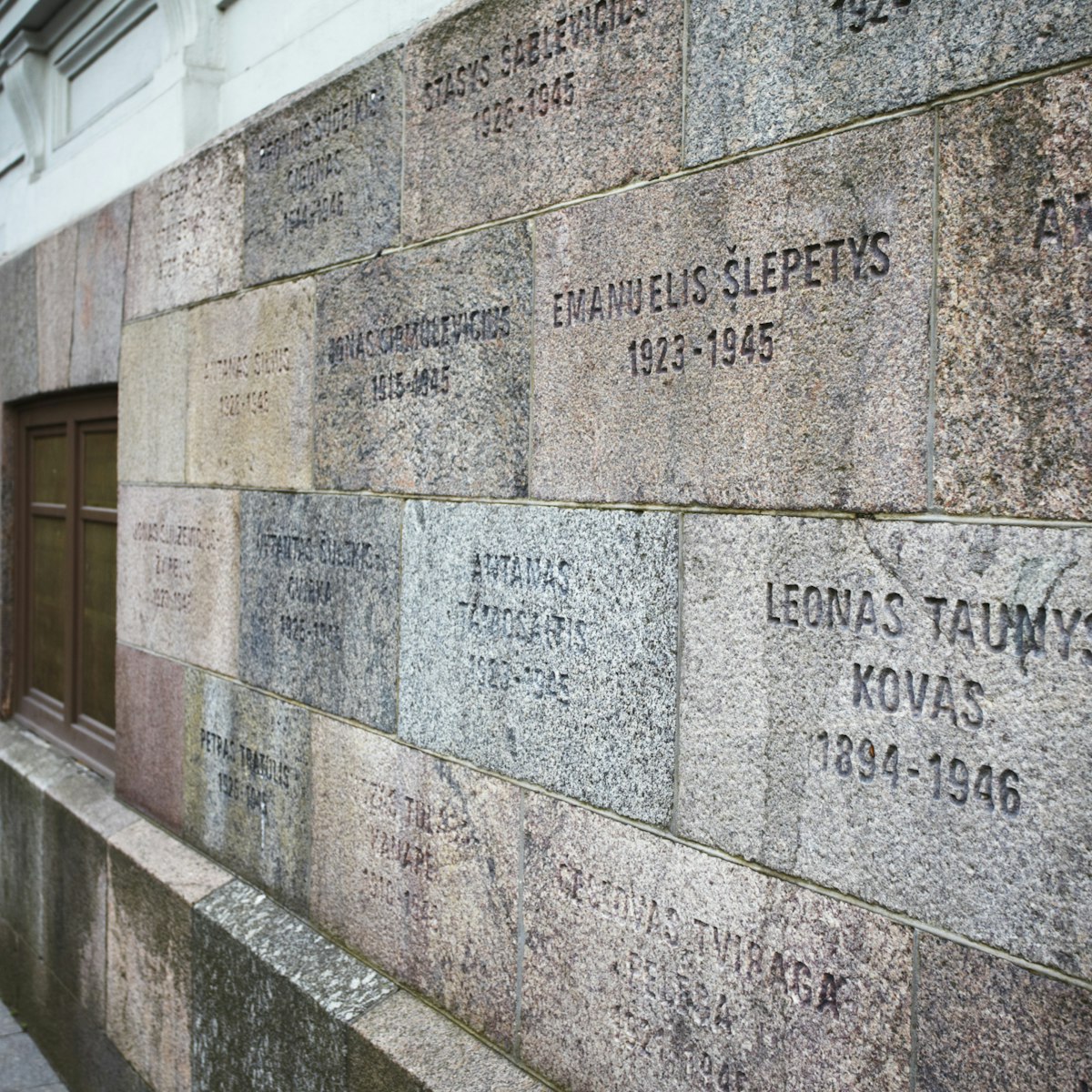
Museum of Genocide Victims
This former headquarters of the KGB (and before them the Gestapo, Polish occupiers and Tsarist judiciary) houses a museum dedicated to thousands of…

Lithuania's dark 20th-century history is poignantly told here, 7km north of Kaunas. Begin in the sombre, church-like gallery with striking stained glass…
Plan with a local
Experience the real Lithuania
Let a local expert craft your dream trip.
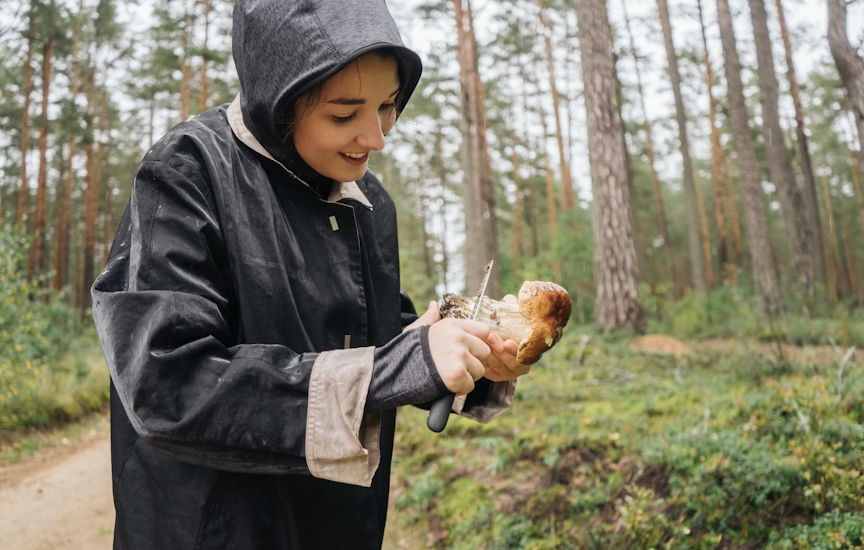
Latest stories from Lithuania
Filter by interest:
- All Interests
- Adventure Travel
- Art & Culture
- Beaches, Coasts & Islands
- Food & Drink
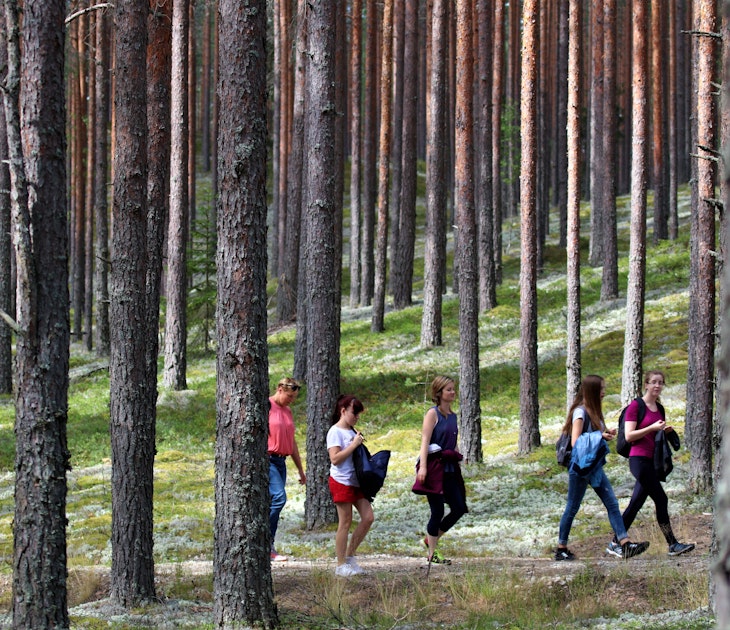
Mar 16, 2021 • 1 min read
The 2141km Forest Trail hiking route links the forests and national parks of Lithuania, Estonia and Latvia.
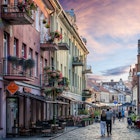
Jun 3, 2020 • 2 min read

May 25, 2020 • 7 min read
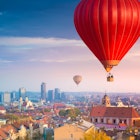
May 8, 2020 • 1 min read
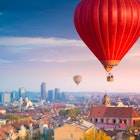
Feb 5, 2020 • 2 min read
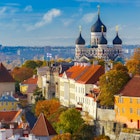
Oct 9, 2019 • 4 min read
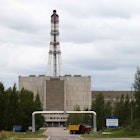
Aug 22, 2019 • 1 min read
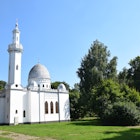
May 13, 2019 • 6 min read
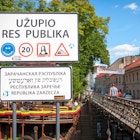
Jun 7, 2017 • 6 min read
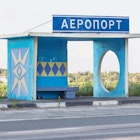
Apr 4, 2017 • 2 min read
in partnership with getyourguide
Book popular activities in Lithuania
Purchase our award-winning guidebooks.
Get to the heart of Lithuania with one of our in-depth, award-winning guidebooks, covering maps, itineraries, and expert guidance.
Lithuania and beyond
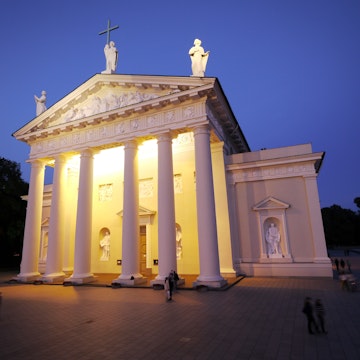
Press ESC to close
Lithuania: top 10 must-visit destinations.
- 1 1. Vilnius:
- 2 2. Trakai:
- 3 3. Kaunas:
- 4 4. Hill of Crosses (Kryžių Kalnas):
- 5 5. Curonian Spit:
- 6 6. Šiauliai:
- 7 7. Palanga:
- 8 8. Aukštaitija National Park:
- 9 9. Dzūkija National Park:
- 10 10 Rumsiskes Open-Air Museum:
Lithuania, nestled in the Baltic region of Northern Europe, is a country rich in cultural heritage, historical landmarks, and stunning natural landscapes. From its vibrant capital to its serene countryside and picturesque coastal areas, Lithuania offers an array of destinations that captivate travelers. Let’s embark on a journey to discover the top 10 must-visit destinations of Lithuania that showcase the beauty and diversity of this Baltic gem.
1. Vilnius :
The capital city of Lithuania, Vilnius, is a blend of historic charm and modern vibrancy. Visitors can explore the UNESCO-listed Old Town, home to architectural marvels like Vilnius Cathedral, Gediminas Tower, and St. Anne’s Church. The bohemian Užupis district, known for its artistic ambiance, offers galleries, cafes, and vibrant street art.
As the capital city, Vilnius is a vibrant hub of history, culture, and architectural splendor. The UNESCO-listed Old Town, a maze of cobbled streets and historic buildings, is a treasure trove of Gothic, Renaissance, and Baroque architecture. The iconic Vilnius Cathedral, Gediminas Tower atop the hill, and the picturesque Užupis district are among the city’s highlights. Visitors can immerse themselves in local culture, visit art galleries, and indulge in Lithuanian cuisine at traditional restaurants. Vilnius are your first stop for a travel to Lithuania .
2. Trakai :
Famous for its picturesque Trakai Island Castle, Trakai is a town surrounded by stunning lakes and forests. Visitors can tour the red-brick castle, engage in water activities on Lake Galvė, and explore the Karaite culture in the historic Karaim community.
Situated amidst serene lakes, Trakai is known for its striking Trakai Island Castle. The red-brick castle, set against the backdrop of Lake Galvė, invites visitors to explore its historical interiors and learn about the Grand Duchy of Lithuania. The town offers a glimpse into the Karaim culture, reflected in the traditional Karaim Kenesa and wooden architecture. The scenic surroundings of lakes and forests provide opportunities for outdoor activities like boating, hiking, and cycling.
3. Kaunas :
Lithuania’s second-largest city, Kaunas, boasts a rich history and vibrant cultural scene. Visitors can discover the Old Town’s Gothic architecture, visit the medieval Kaunas Castle, and explore the quirky museums and galleries in the bohemian district of Žaliakalnis.
With a rich historical legacy, Kaunas presents a blend of architectural styles and cultural diversity. The Old Town, with its charming streets and historical buildings, showcases Gothic, Renaissance, and Baroque architecture. Kaunas Castle, overlooking the confluence of the Neris and Nemunas rivers, serves as a symbol of the city’s heritage. The city’s vibrant art scene, showcased in the Devil’s Museum and M. K. Čiurlionis National Art Museum, attracts art enthusiasts.
4. Hill of Crosses (Kryžių Kalnas) :
A unique pilgrimage site, the Hill of Crosses is adorned with thousands of crosses representing prayers and devotion. Visitors can witness this poignant symbol of faith and resilience, which holds historical significance for the Lithuanian people.
5. Curonian Spit :
A UNESCO World Heritage Site, the Curonian Spit is a unique coastal area with pristine sand dunes, pine forests, and fishing villages. Visitors can relax on sandy beaches, explore the Parnidis Dune, and admire traditional wooden architecture in Nida.
6. Šiauliai :
Known for the iconic Hill of Crosses, Šiauliai offers historical and cultural insights. Visitors can explore the Chaim Frenkel Villa, learn about Jewish heritage at the Šiauliai Aušros Museum, and visit the Bicycle Museum.
7. Palanga :
A popular seaside resort town, Palanga entices visitors with sandy beaches and a lively atmosphere. Visitors can stroll along the vibrant Basanavičiaus Street, visit the Amber Museum and Botanical Park, and enjoy the vibrant nightlife.
8. Aukštaitija National Park :
Lithuania’s first national park, Aukštaitija National Park, is a haven for nature enthusiasts. Visitors can hike through pristine forests, kayak in crystal-clear lakes, and visit traditional villages to experience local customs.
9. Dzūkija National Park :
Known for its dense forests and unique ecosystems, Dzūkija National Park offers opportunities for hiking, cycling, and wildlife spotting. Visitors can explore the ancient Čepkeliai Marsh, climb the observation tower in Marcinkonys, and experience the local rural lifestyle.
10 Rumsiskes Open-Air Museum :
This expansive museum showcases the traditional architecture and way of life in different regions of Lithuania. Visitors can explore authentic village houses, participate in craft workshops, and experience cultural events.
Liechtenstein: Top 5 Must-Visit Destinations
Luxembourg: top 5 must-visit destinations, leave a reply cancel reply.
Save my name, email, and website in this browser for the next time I comment.

Top 10 Must Visit Places in LITHUANIA: Insider’s Guide
Lithuania is an awesome small evergreen country in Eastern Europe with many beautiful and rather unexpected natural and cultural sights worth visiting. Here I will walk you through a list of my favorite must-visit places in Lithuania .
My home country Lithuania is probably the least-known place in Europe. Many people are aware of our sister country Latvia and its capital Riga, but only a few know about the capital Vilnius or Lithuania. Nonetheless, this small Baltic jewel scores points with fantastic nature, majestic churches, medieval castles, charming capital Vilnius, unique old villages, and even some spooky places like the Hill of Crosses in Siauliai. That being said, Lithuania is a true definition of an off-the-beaten-path destination in Europe.
If you landed on this post you are most likely looking for things to do in Lithuania. In this insider’s guide to places to visit in Lithuania, you will find a mix of wonderful cultural, historical, and natural attractions. I also share some useful tips for each location.

Disclaimer: This post contains affiliate links, which means that I may earn a commission if you make a purchase by clicking a link (at no extra cost to you). This helps to keep my blog running and growing by creating more awesome free content for you.
The best 10 places to visit in Lithuania
1. curonian spit (kuršių nerija).
Let’s start with my absolute favorite and the most beautiful natural must-visit place in Lithuania- a UNESCO-listed natural wonder called Curonian Spit (Kuršių Nerija in Lithuanian). It is like the desert of Lithuania half of which is covered in forests.

What is Curonian Spit exactly?
Curonian Spit is a 0.4-3.8 km width sand dune peninsula stretching for almost 100 KM from Klaipeda county in Lithuania to Russian Federation. It is surrounded by the Baltic Sea from one side and Curonian Lagoon from the other making it a magnificent natural formation. Half of the peninsula belongs to Lithuania and has a status of a Natural Park.
It has always been this magical paradise-like piece of land that has been threatened by unforgiving natural forces- never-ending strong winds and furious Baltic Sea waves. Only continuous stabilization and reforestation projects led by restless nature-loving people helped to combat the erosion.
Curonian spit has an incredibly unique but vulnerable nature like nowhere else in the country. It is also home to very old fishermen’s settlements dating back to the 10 th -11 th century. Therefore, the cultural value of the area is of high importance as well. Harmonious coexistence between humans and nature makes this place beyond special. Being at threat of extinction both due to natural forces and human intervention, Curonian Spit has been saved since massive protection works began in the 19th century. Now the lands and cultural heritage are very well maintained and protected by the Government of Lithuania.
Nowadays, many ancient fishermen’s villages have been turned into small guest houses and are welcoming visitors during the summertime. Nida is the most popular resort town attracting thousands of visitors during the summer months not only from Lithuania but also from Germany and other neighboring countries.

How to get to Curonian Spit?
You can reach Curonian Spit by ferry from Klaipeda town in West Lithuania. There are two ferry stations in Klaipeda- an old one and a new one.
Passenger ferries depart from the old ferry terminal in Klaipeda port just north of the city center. They go to Smiltyne and are quite frequent. You can check the schedule for the old ferry online .
If you arrive by car, you must make your way to the new terminal, which is a bit further south of the city of Klaipeda. The schedule as well as location information is available here on the terminal website.
Note: there is an ecological fee for entering Curonian Spit national park by car. You have to pay it if you are willing to drive beyond Juodkrante village which is around 14 km away from the ferry. It is 30 EUR per car during the high season (beginning of June- end of August) and 5 EUR per car during the low season.
2. Vilnius Old Town
If you are traveling to Lithuania, its capital Vilniuswith a petite historical old town is definitely a place to visit in Lithuania.
“Vilnius is the G-spot of Europe- nobody knows where it is but when you find it, it is amazing.” That is a line from the tourism campaign that made the capital of Lithuania famous around the globe. And it is well worth the limelight. Being an underdog European capital for many years, Vilnius finally steps its game up in the tourism sector.

Having one of the largest UNESCO-listed old towns in Northern Europe, Vilnius invites you to the maze of cozy cobblestone streets lined up with outdoor cafes. A cocktail of the best old architecture is mixed with Baroque, Gothic, Renaissance, and even Medieval ingredients that will leave you dizzy (in a good way). Green parks can be found all around the old center and are perfect spots to relax.
The best way to explore Vilnius’s old town is on foot. Many people choose cycling around the city as an alternative faster way to get from place to place. Beware of pedestrians if you decide to jump on a bike as many streets are narrow. You can also rent one of those street pay-as-you-go bicycles available to pick up in Old Town.
I would suggest starting your walking or cycling tour around Vilnius’s old town at the very heart of it- Cathedral Basilica in Cathedral Square. Although you can walk the old town part in as little as a couple of hours, spare yourself a good half a day at least to enjoy Vilnius at a slow pace.
3. Trakai and its island castle
Trakai is a small historical town built on lakes with its gorgeous island castle. Only 28 km from Vilnius city center, it is a perfect half-day nature escape with a fair amount of cultural sights and outdoor activities.
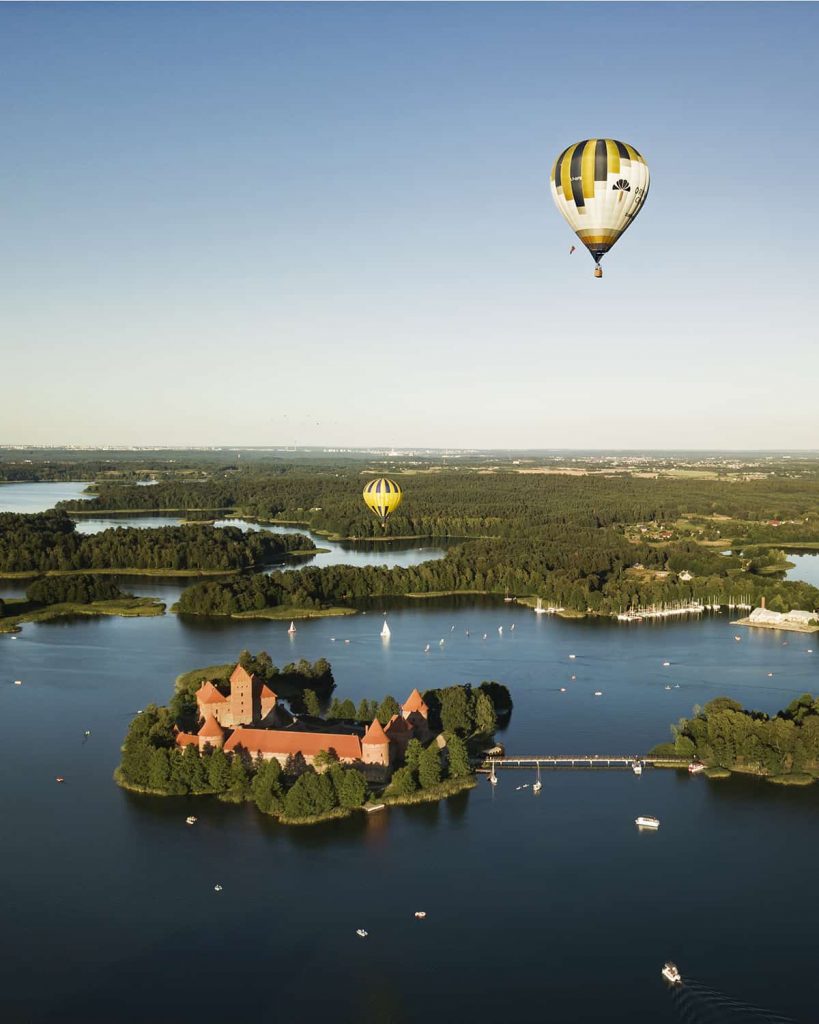
Trakai is an absolutely majestic place that is a must-visit when traveling in Lithuania. Here is a list of a few exciting things to do in Trakai:
- Visit the spectacular medieval castle built on the island at the heart of Trakai town.
- Go kayaking, stand up paddling, or take a boat tour around Galve lake to enjoy 360 degrees views of Trakai castle.
- Swim in the lake. With over 200 hundred super clean water lakes to choose from, Trakai is a perfect beach day out in summer.
- Get on an air balloon- one of the most beautiful views you would ever see from above. Tip- go at a sunset for the best experience or at sunrise to catch misty views.
- Taste traditional pastry “kibinai” with homemade kvass- this is a very specific food for Trakai town. I suggest Senoji Kibinine or one of the homemade spots that you will come across in the town for an authentic experience.
4. Kernave- The First Capital of Lithuania
Kernave is referred to as the Lithuanian Troy. It is one of the most beautiful spots in the region often overlooked by foreign travelers. This UNESCO inscribed little town is the medieval capital of The Grand Duchy of Lithuania. It has an archeological site that holds a history of thousands of years- a real treasure-trove for Lithuanian archeologists.
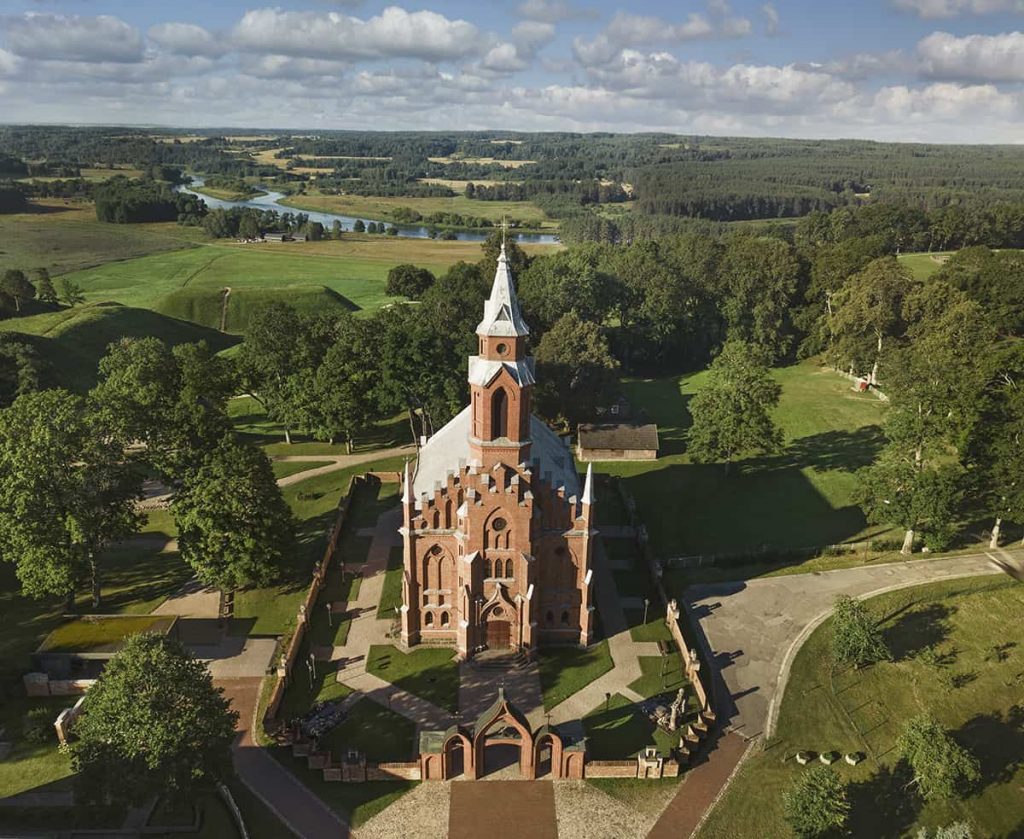
Kernave invites you to discover Lithuanian ancestry. It is a very mysterious place, especially during the misty mornings. The highlight of the scenery is five hill-fort mounds on the legendary Pajauta Valley near the banks of river Neris. Those picturesque mounds guard the remains of the last European pagan capital.
Although ancient settlements were destroyed back in 14 th century, a replica of the 13 th century housing complex was re-created for educational purposes.
One of the most important political and economic centers during the history of pagan Lithuania, Kernave is a symbol of statehood. With its many legends and stories, the town of Kernave has a very special aura around it.
How to get to Kernave?
Situated around 35km north of present capital Vilnius, Kernave is easily reachable either by public bus or a car.
By car from Vilnius, take the A1 or A2 motorways, and then the 108 or 116 roads. By bus, go to the station’s platforms 10 or 11. Busses to Kernave run about six times a day.
Things to do in Kernave
Apart from exploring the mounds at Pajauta Valley and enjoying the glorious nature, there are a few other things you could do in the area. For those of you into history, there is a museum dedicated to this special place. Also, the before mentioned open-air museum of the old settlements of Kernave.
If you are more into something adventurous, you can even go on a 1 or 2-day kayak tour from Vilnius to Kernav e. Or sign-up for annual ultra-marathon run for 84km from Vilnius to Kernave .
I would highly recommend visiting Kernave early in the morning while the town is still sleeping. If you are lucky, you might also catch the fog which adds up to the overall atmosphere.
If you are short on time and keen on informative local tours, I would recommend checking out those highly rated guided activities in Vilnius, Trakai, and Kernave. They can be easily booked online through GetYourGuide website links below.
5. Baltic Sea Coast & Dutchman’s Cap
You will love Lithuania’s Baltic sea coast for its unique scenery and wilderness. Imagine the sea meeting the forest at a 20 meters cliff. It makes a kind of unusual coastal view, doesn’t it?
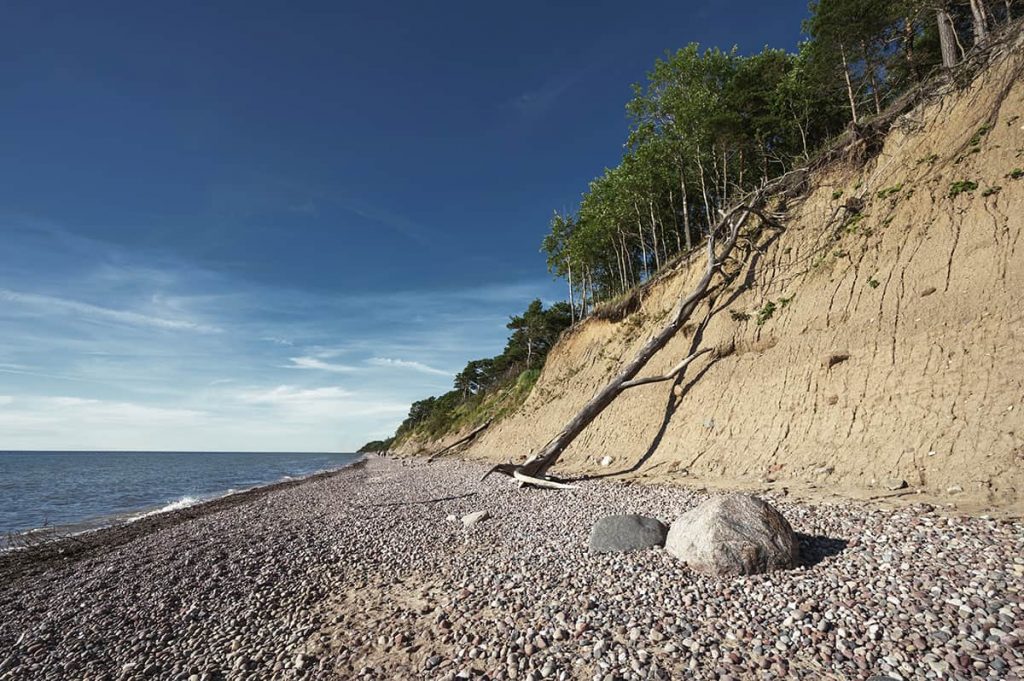
Baltic Sea coast is rated as one of the best in Europe. Some of the most amazing natural spots are located in the Seaside Regional Park of Lithuania, with Dutchman’s Cap and beaches between Karkle and Giruliai villages being the highlights of the area.
Karkle village is the administrative center of the Seaside Regional park and ethnocultural reservation. It is one of the oldest and biggest historical coastal settlements dating back to the 15 th century. Around 3km south of Karkle you will find the cliff of the Dutchman’s Cap – an impressive parabolic dune emerged 24.4 meters from the sea. Sadly, it gets eroded by the beat of the waves. The Dutchman’s Cap is overgrown by the oak and pine forest. It creates a contrast to the sandplain, which is stretched around. The hill used to serve as a guide for seamen and fishermen.
Today, there is a wooden path leading towards an observation deck built for visitors to enjoy the panorama from the cliff. You can also admire the view of the bluff from the sea level.
During the summer months you can relax at the unspoiled wild beach and swim in the Baltic Sea. It doesn’t get particularly warm but is very refreshing on a hot day.

How to get to the best beach spot on Lithuanian Baltic Coast?
Ideally, you would arrive in your own car. There are plenty of paid parking spots from which you can easily reach all the fantastic Seaside Park locations including the beach.
Public transport is also available from the nearby city of Klaipeda. There is a bus number 24 stopping at Dutchman’s Cap. You can find the bus schedule and a convenient stop on Klaipeda’s public transport website here .
As advised by locals, the best swimming and sunbathing locations are at a former Zuvedra (Seagull) recreational camp, Karkle, and Nemirseta villages. However, those places get pretty crowded to my own liking during the hot summer days. Therefore, I would suggest choosing the spot between Dutchman’s Hat and WWII bunker called Battery Memel Nord (this is currently a tourist attraction located on the beach).
I have marked the best part of the beach on the map bellow. You might find yourself completely alone on summer weekday.
Things to do at the Baltic Sea Coast of Lithuania
- Easy hiking: soak up the fresh air and enjoy the coastal views from the 15 meters height while taking footpaths through one of the most beautiful forests in Lithuania
Marked hiking trails were opened in 2020. After completing a section of the trail each time you will be motivated to move forward by the fun statements. “3km – you have burned one croissant, 6km- one burger, 12km – family size pizza” says illustrative information board on the trail.
Those are the 3 new hiking trails in the Seaside Regional Park starting in Karkle, passing Dutchman’s Cap, WWII fortifications in Giruliai, and finishing at lake Kalote. The total length of the trails is 12 km, with each section being 3.5-4.5 km lenght. You are welcome to choose any or all of the sections or mix them up as you go. There are red, blue, and yellow marked routes. Navigation is very easy.
I have done a part of the red section from Karkle to Dutchman’s Cap and then continued following the yellow trail (which is also a part of the Litorna route) up until the Memel-Nord battery (another spot of interest for visitors who are interested in post-war relicts). The total calories burned unknown but the beauty of the coastal nature is what keeps you wanting to explore further.
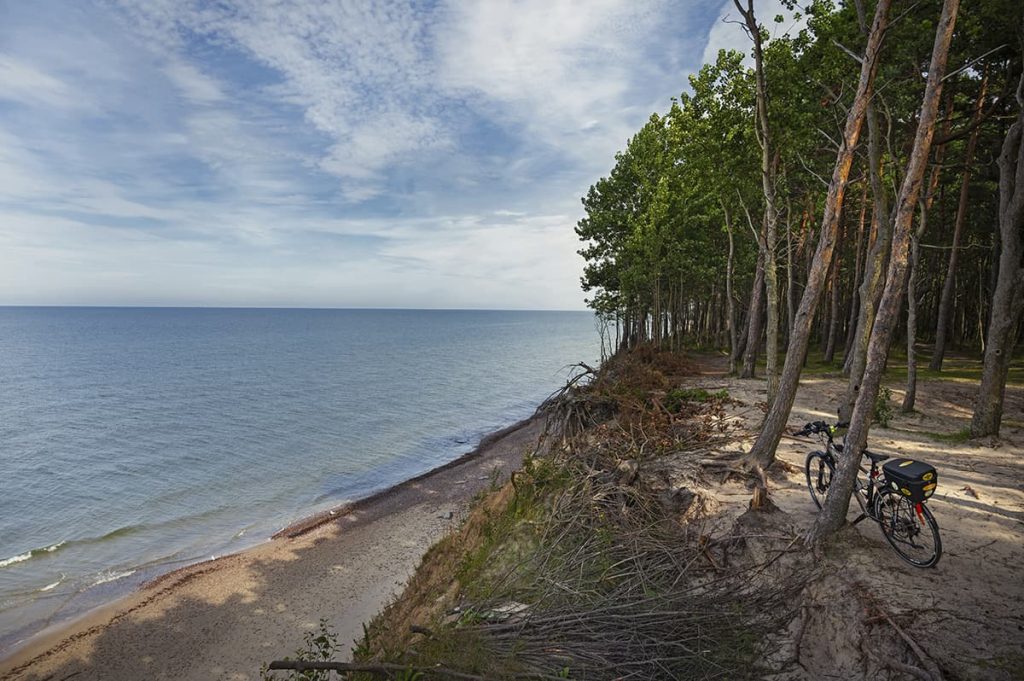
- Cycling from Palanga to Kaipeda
The bike path connecting two seaside towns Klaipeda and Palanga is a great way to actively spend a day in nature. With small detours from the main path, you can access many of the beautiful spots along the coast by cycling.
- Reward yourself with a filling late lunch
After a long day outside, there is nothing better than a wholesome Lithuanian meal. My place to go in the area is Žvejo Sodyba (Fishermen’s homestead) in Karkle village. It is a restaurant offering traditional Lithuanian cuisine in an old-style wooden fishermen’s house and a beautiful courtyard. Portions are huge and super delicious.
- Watch the sunset over the Baltic Sea
This is the most romantic and magical time at the West Coast in Lithuania offering one of the most beautiful sunset views you might ever see.
6. The Hill of Crosses near Siauliai town
The Hill of Crosses is a stoic mound holding the weight of over 300 000 crosses. I bet you have not seen anything like this before. Imagine an earthen hill in the middle of nowhere fully covered with various sizes of crosses and rosaries clinking against metal and wooden crucifixes, filling the air with eerie chimes. Sounds mysterious, doesn’t it?

Currently serving as a pilgrimage and historical sight in Northern Lithuania, the Hill of Crosses is in fact surrounded by legends, haunting stories and mystery.
The precise origin of the custom of leaving crosses is unknown, but it is believed to have started at the beginning of the 19 th century. The hill has been getting covered with crosses of different sizes and styles, rosaries and religious icons.
Historically, this place went through a lot: it survived medieval sieges by German crusaders, 19-th century uprisings by Lithuanians against Russian Tsar and finally the furious aggressor- Soviet Union. In the 1960-70s, atheist Soviets attempted to level the hill with the ground by bulldozing it and burning the crosses. Those multiple attempts failed just as did the Soviet Union, andThe Hill of Crosses is still standing embodying the peaceful resistance to Soviet occupation.
For some, it is a very sacred place that attracts pilgrims from all around the world, while others find it spooky. Whichever it may be, the Hill of Cross certainly does not leave anyone indifferent.
Is the Hill of Crosses worth visiting? Absolutely yes!
Due to its remote location, the Hill of Crosses is not on every traveler’s radar. It is 12km away from Siauliai town in Northern Lithuania and around 3 hours drive from the capital Vilnius.
To manage your expectations, the Hill of Crosses itself is just as big as a football field. Therefore, it won’t take long to explore it compared to the journey length. Not to put you off, it is a sight to never forget- the atmosphere there is very special. I believe that winter/autumn is the best time for visiting the Hill of Crosses because the absence of greenery adds up to the mysterious atmosphere. Foggy autumn mornings would do a great job of getting you a bit spooked out.
How to get to the Hill of Crosses?
The easiest way is to drive (I highly recommend renting a car in Lithuania, makes moving around much easier). Not a driver? No problem, public transport is also available, just takes longer. First, you would have to get to Siauliai town. Then, you will be able to find a local bus at Siauliai coach station that will bring you to the Hill of Crosses. Alternatively, you can take a taxi but obviously it will be a more costly option.
I would recommend including the Hill of Crosses as a stop when going to or from the Lithuanian seaside- it is a bit of a detour but you will see some pretty cool countryside on this road trip. It will be more engaging than flying at 130 km/h on a Vilnius- Klaipeda highway.
7. Lake Plateliai in Zemaitija National Park
A lake of seven islands – Plateliai is the most picturesque lake and an ultimate attraction in Zemaitija National Park. Located around 80 km away from the Baltic Coast, the lake makes it an awesome detour to North-West Lithuania. On the way, you will be surprised by the changing scenery of rolling hills as a contrast to mostly flat Lithuanian landscape.

Plateliai is the biggest lake in Zemaitija (Samogitia) region and 9 th biggest in Lithuania. Covering 12 square kilometers and reaching up to 49m in depth makes it is a perfect base for diving and underwater archeology. Therefore, the lake is not only a natural treasure but also an important cultural sight.
On the west bank of the lake, you will find a charming historical town Plateliai (the same name as the lake). This town of only 1000 inhabitants comes to life during the summer season when many locals arrive to enjoy water activities and relax in the nature.

Cycling around Plateliai
The major summer attraction around the lake is one of the most impressive cycling trails that starts and finishes at Plateliai town. It is an incredibly beautiful and well-maintained marked cycling trail that is both family-friendly and is also suitable for beginners.
Total length of the trail is around 25 km. There are plenty of possible stops on the way and points of interest to explore: Cold War Museum, Plateliai Manor Park, several viewpoints, small villages, Uzpelkiu mound, Litvaku memorial garden to name a few.
I highly recommend renting a bike for a few hours or even a day once in Plateliai town. Bike rental prices are very affordable in Lithuania (1 EUR per hour) and it’s one of the best ways to move around. Going at a slow pace, you will enjoy beautiful nature and fresh air. Don’t forget to stop for a swim in the clean and refreshing waters of Plateliai lake.
Also, you can find the tourist information center in Plateliai town where you can receive all the information about places of interest. All of them are reachableby cycling around the lake.
Alternatively, walking is also a great option to enjoy your stay at Plateliai. 4 km Seires educational trail is a perfect way to get familiar with the breathtaking landscape of Plateliai reserve. Part of the trail is suitable for people with mobility restrictions. The starting point coordinates of the trail are 21.827357, 56.048411.
As mentioned before, there are plenty of water sports activities: standup paddling, kayaking, yacht sailing, diving, water cycling. The best place to go for rentals would be Plateliai Yacht club.
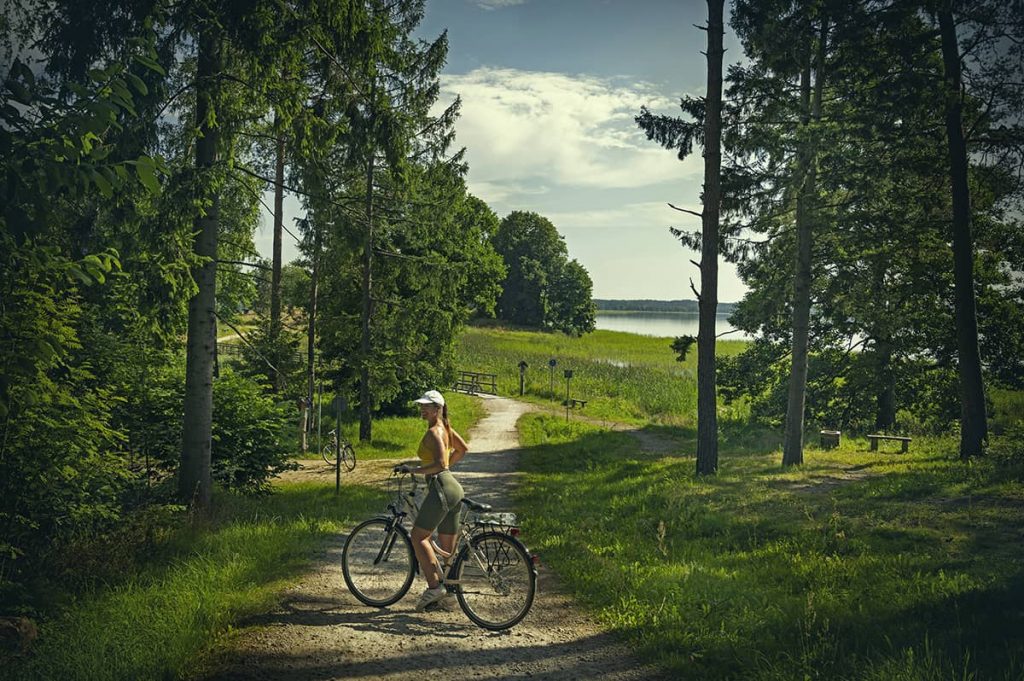
Where to stay in Plateliai?
Only 8 km from Plateliai town, there is an incredible rural tourism homestead called Iesnale featuring an amazing garden with apple trees, a water pond and even its own lake. The hosts are very welcoming and are happy to help to make your stay as comfortable as possible. They also have bicycles for rent. I have stayed there for a couple of nights, highly recommend it!

8. Moletai Astronomical Observatory
Moletai is a small town surrounded by lakes only an hour away North-East from Vilnius which makes it a great day trip with quite a few fun things to do.
Recently, Moletai Tourism Center prepared lots of activities to attract more visitors to this off-beaten path destination. From recreational trails, lake escapes to unique virtual tours through time introducing the history of Moletai and Astronomical Observatory surrounded by lakes- this place has something to everyone.
The Museum of Ethnocosmology
The museum of Ethnocosmology in Moletai is an astronomical observatory that looks like a sci-fi movie building placed in the natural lush green surroundings. It is quite an unusual sight on its own. Working 24 hours, the museum offers educational tours conducted in English as well. Also, on a clear night, the observatory is open for observations of distant celestial objects through a telescope- quite cool!

9. Auk š taitija National Park
It is said that Lithuanians’ love for nature arose in the territories of the present-day Auk š taitija (owk-shtai-ti-ya) National Park. It is no surprise that once-pagan country was bewitched by those deep green forests and dark blue lakes.
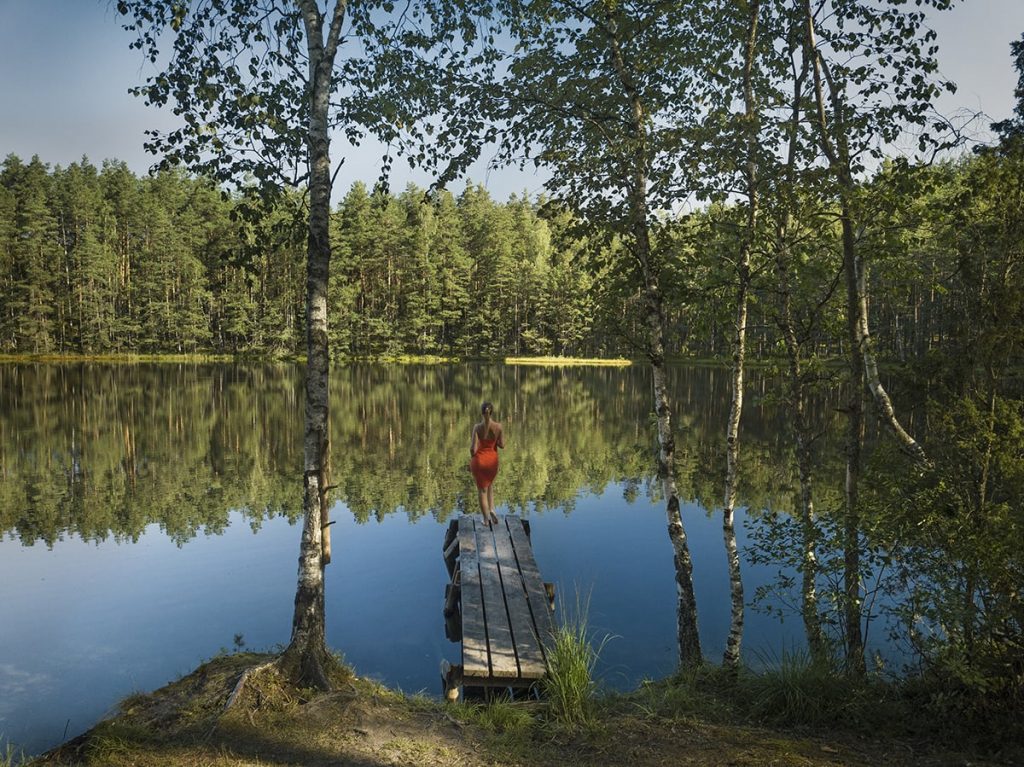
30 rivers and 126 lakes of different sizes and shapes are sprinkled around the pine woods covering 410.56 km² of the national park territory. Wildlife is also present in this area – you can find boar, deer and elk.
Aukštaitija National Park is the oldest of five national parks in Lithuania. It is around 100 km North-East of capital Vilnius.
Things to do in Auk š tatija National Park
Explore breathtaking Ladakalnis (Ice Hill)- a former fortification mound from where a panorama of seven lakes unfolds. You can wonder around and follow some nature trails to explore the area and take a dip into the lakes.

Go kayaking in Zeimena river or other surrounding rivers. This is by far of my favorites activities in the area. You will experience beautiful and easy but at times tricky routes since there are natural obstacles along the way. You have to maneuver around them. Sometimes you might even come across a tree that fell into the river and completely blocked the way. Therefore, you will have to carry your kayak over the tree which makes it a little bit of an adventure.
There are plenty of kayak rental spots in the area. You can check “Superbaidares” . They have information in English with all short and long routes, even overnight routes available to choose from.

How to get to Auk š taitija National Park
The main jumping-off point and a base to stay for the park is a sleepy town Ignalina. There are buses several times a day leaving from Vilnius intercity bus station, you can check timetables here .
However, the most convenient way to reach the park is by car. This way you will have more flexibility to move around the park and stop wherever you like.
10. Kirkilai Lakes and Observation Tower in Biržai Regional Park
Lithuanians are obsessed with observation towers. They are one of the sites which attract the highest number of visitors in Lithuania. There are over 30 registered view towers varying in height and shape scattered across the country. Those towers offer visitors panoramic vistas of some of the most beautiful natural surroundings.

Since it would take a good week or two visit them all, I would like to highlight the absolute must visit- Kirkilai Observation Tower. It is located in Biržai regional park, North Lithuania.
You might wonder what is so special about this particular tower. The answer is – a unique shape and unusual landscape.
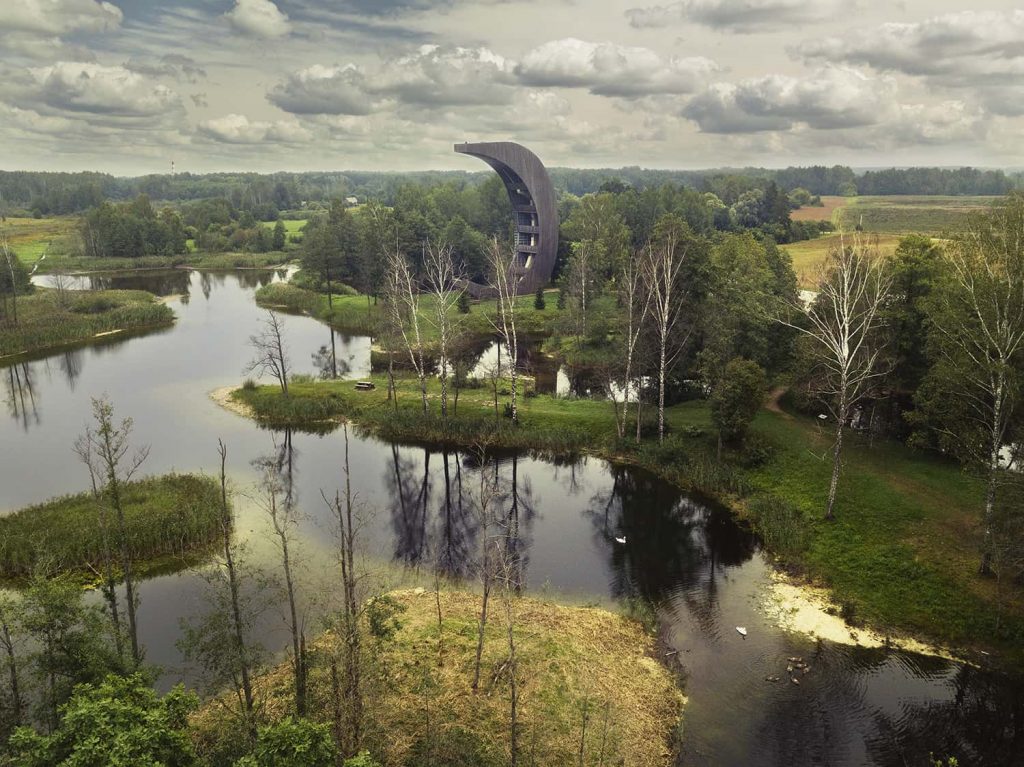
30 meters height Kirkilai observation tower resembles a canoe which also looks like a Moon from the side. The surrounding landscape features a unique terrain of 30 water-filled sinkholes that were formed due to karstic processes. From the top of the tower, you will see wonderful views of those karstic lakes which, on a sunny Summer day, vary in color.
How to get to Kirkilai Lakes and Observation tower
The tower is a bit off-the-beaten-path 10 km away from Biržai town and 2,5 hours drive from the capital Vilnius. Yet it is a stop worth to be included in your road trip route, especially if you heading up North. You can combine a trip to the Hill of Crosses by visiting the Kirkilai view tower.
Location: 56.247821, 24.690785 (or simply type Kirkilai lakes and observations tower into Google Maps )
This is my list of the top 10 must-visit places in Lithuania. If you have any questions related to traveling in Lithuania, please let me know by commenting below or sending me a private message- I will be happy to help you out. Also, do not forget to pin this post to your Pinterest, so you can come back to it later.
Make sure to check useful quick tips and main information about traveling in Lithuania at my Guide to Lithuania page . There you will also find all the related posts that will help you plan your trip to my beautiful country.
Love it? Pin it!
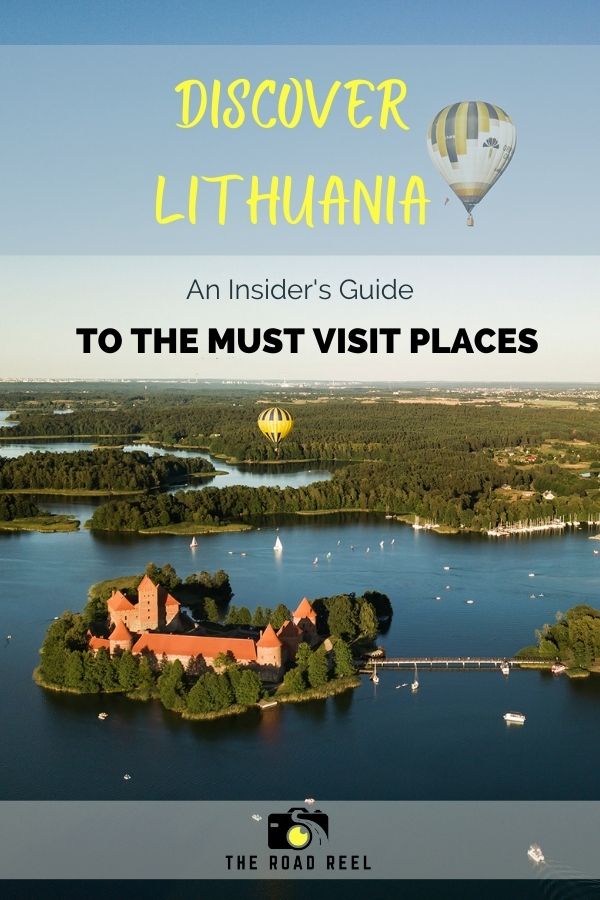
Enjoy your journey and hit me up to let me know how it went!
Hi! I am a freelance photographer & videographer as well the creator of www.theroadreel.com. Born in Lithuania, and currently residing in the UAE, I have been traveling around the globe independently for over a decade. I created The Road Reel to share my passion for travel and photography through detailed road trips and city itineraries, and hiking guides, along with regular and drone photogragraphy tips.
- Pingback: Montenegro Itinerary: Epic Two Week Road Trip! | The Road Reel
- Pingback: Top 10 Must Visit Pavilions At Dubai Expo 2020 (and The Ones To Skip)
Leave a Reply Cancel reply
Your email address will not be published. Required fields are marked *
Save my name, email, and website in this browser for the next time I comment.
15 BEST Places to Visit in Lithuania
The southernmost among the Baltic States and a pocket-sized republic, the places to visit in Lithuania are a delight for the nature lovers while vying for the spotlight regarding public excitement.
A land revered for its food and water, Lithuania is a proud and independent nation that is fast turning into a European gem among tourism hotspots .
The stunning Baltic coastline is the foremost of Lithuania tourist attractions with the uncommon sliver of Curonian Spit white sand being of particular interest. The lonely coastal wetlands rank as Lithuania attractions not just for the tourists but also for the migrating birds who flock here by the thousands.
This Baltic wonder is also home to burnished lakes that are solemnly lorded upon and watched over by lush, inland forests.
The capital city Vilnius is a veritable artists’ enclave with baroque churches, cobbled streets, and timeworn courtyards in the middle of a modern, confident, and vibrant culture.
Certain remnants from the Soviet era, such as a Soviet sculpture park and a disused nuclear missile site that has been converted into a Cold War museum stand as reminders of a dark, recent past. On the other hand, the Orvydas stone garden and the Hill of Crosses testify to the enduring faith that characterizes the spirit of Lithuania.
The small size of the country makes Lithuania travel a somewhat inexpensive outlook with even the well-trodden areas having a low volume of visitors such that tourists are left with the feeling that there is yet a lot to be explored.
Apart from the capital, the second city Kaunas is home to some fascinating museums and excellent bars and restaurants . Klaipeda is a port city with a convenient overnight stop for tourists en route to the Neringa resorts along the Curonian Spit. Palanga is the party town of the country that is teeming with visitors, particularly during the summer months.
Tourists planning to travel to Lithuania will positively be enchanted and intrigued by the plethora of things to do in Lithuania. Nevertheless, they should not miss out on visiting the following Lithuania points of interest, failing which their tour would remain vastly incomplete.
❗️ Be insured before your trip and get a SafetyWing FREE insurance quote 📚 Read our post about why you should always have insurance ✈️ Find out how to find cheap flights using Skyscanner or find deals now 🛌🏻 Book your accommodation through Booking.com , Expedia , or Agoda 🎭 Find awesome and hassle-free tours through GetYourGuide or Tourradar 🚘 Explore the surrounding areas on an epic road trip with Rental Cars 📱 Read destination reviews and other traveler tips on TripAdvisor
Table of Contents
What are the best places to visit in Lithuania?
Vilnius Lithuania is often considered the baroque beauty in the Baltic . It is a city that has tremendous alluring power and draws tourists like a moth to the flame, driven by a natural, confident charm and a distinct warmth and golden glow that make the mind long for midsummer evenings throughout the year.
When viewed from a hot air balloon, the skyline resembles a giant bed of nails interspersed by the myriad steeples of Catholic and Orthodox churches.
The capital city of Lithuania has not always been a happy place to live. Every corner reminds of the pain and loss that ruled the city once upon a time, from the ghettos used as concentration camps for the Jewish families before Nazis murdered them, to the KGB torture cells.
Nevertheless, the spirit of resistance and freedom has held sway as the city comes out to forge its new identity with a combination of the past, present, and the future in its shiny modern skyscrapers, a burgeoning nightlife, and delightful Lithuania food.
Where to stay: Best hotels in Vilnius

Located in the heartland of the country and overlooking the confluence of the Neris and Nemunas rivers, Kaunas is the second city among Lithuania attractions that is gradually carving out its niche as the alternative hub and party capital of the nation.
The nightlife is driven by a multitude of students, bubbling along the tree-shaded Laisves Aleja Boulevard between many historical underground drinking centers and craft bars.
The Lithuania attractions in this city during the daytime usually involve a visit to the crumbling bulwarks of the red-brick Kaunas Castle. Tourists can also wander the enchanting Old Town alleys – a pretty district of cobblestone pathways and the site of a gorgeous city hall and various charming merchant guilds of the medieval period.
Where to stay: Best hotels in Kaunas

One of the cities in Lithuania to have received UNESCO attestation , Kernave, has a rich heritage and historical background dating back further than most of the other towns and cities of Lithuania.
It is heralded as one of the first Grand Duchy medieval capitals and the possible seat of the golden age boom that occurred during the 13th and 14th centuries before the keeps and fortifications were razed down by the Teutonic Order onslaught.
The Lithuania countryside in Kernave running along the meanders of the Neris River lines with archaeological reserves where tourists can spot relic mounds. Clad in the earth, they conceal many layers of burial sites, bulwarks, and throne rooms that have been traced back to the late Palaeolithic Period.
Where to stay: Best hotels in Kernave

Formerly known as Memel, Klaipeda used to be the stronghold for the Teutonic rule in the Baltic before emerging as a thriving port town for trade during the times of the Duchy of Prussia.
During the late 19th century, this was the northernmost city as part of the German Empire. Today, tourists on Lithuania travel can savor the relics of its 800-year-long history that has done well to mix with the more modern lifestyle and nightlife that is characteristic of this gateway to the famous Curonian Spit coastal stretch.
The Old Town offers a great mix of cobbled squares and unusual sculptures for travelers to wander through while the taverns are major Lithuania attractions for sipping the locally-brewed beer.
Other Lithuania points of interest include the German-style beer halls along the main square, the canning-dotted Prussian bastions, the Medieval docksides, and a walk along the Klaipeda Castle bulwarks.
Where to stay: Best hotels in Klaipeda

Undulating dunes, a patchwork of flat grasslands and verdant pine forests, and sandy beaches snaking their way along the Baltic Coast where the Lithuania country arches towards Poland and the curious Russian exclave standing forth in the form of Kaliningrad – this is the setting that makes Neringa one of the best places to visit in Lithuania.
Traversing the entire length of the Curonian Spit, this Lithuania countryside attraction offers a prime destination for fishing, windsurfing, hiking, and biking. The earthy cottages in the age-old towns of Pervalka and the sun-kissed Nida resort strips are among Lithuania points of interest in the area.
Thomas Mann’s charming cottage and various galleries and artists workshops that emerged following the German emigration from Konigsberg in the 1800s are other sightseeing Lithuania attractions in this destination.
Where to stay: Best hotels in Neringa

High-season chart and electro parties, countless bars and alfresco cocktail joints – tourists looking for the ideal place for some summertime hedonism on a Lithuania travel need not look too far beyond the Jonas Basanavicius Boulevard in Pasanga for the perfect fun setting.
The beach acts like a magnet on sunny days as one of the most open stretches of golden Baltic sand that sunbathers are sure to love. Palanga offers more than just lazy afternoons and late nights with sightseeing Lithuania options, including the picturesque Tiskeviciai Palace with its neo-Renaissance charm and the interest-churning Amber Museum.
The Curonian Spit nature reserves offer another piece of Lithuania scenery that is hard to miss!
Where to stay: Best hotels in Palanga

Dzukija National Park
The most extensive national park in Lithuania spread across a land area of 550 square kilometers; it stands along with the southeast extreme of the country at the edge of the Belarusian border.
The meandering channels of the Nemunas River cut through its swathes of riparian wetlands and pine forests while inland dunes make for interesting Lithuania tourist attractions as they rise and drop to create sandy peaks and troughs amidst a kaleidoscope of different rock and grass strata.
Tourists interested in boardwalk treks can enjoy traveling deep into the woods as long as they have their hiking boots on. The undergrowth witnesses a rich bloom of mushrooms while the rural villages have an abundance of traditional waxwork craft shops.

A fantastic fragment of grassy hills, islets, rolling meadows, and shimmering waters, Lithuania travel guide shows Trakai to be situated west of the capital city of Lithuania. The main crowd of tourists to this place comprises local travelers who frequent here all through the year.
The Lord-of-the-Rings-style castles are excellent tourist attractions in Lithuania Trakai that form the heart of its historic national park – a sprout of red-brick turrets and keep that perfectly mirror against the waters of the surrounding lake.
The trio of large lakes named Skaistis, Galve, and Akmena offer their banks for summertime recreation. The Karaim community is a unique multicultural tribe that is the sole user of the beautiful timber-made Trakai Kenesa synagogue that stands here.
Where to stay: Best hotels in Trakai

This indelible green town stands midway between the Latvian border to the east and Kaunas and creates an astonishing natural gateway to Lithuania countryside of genuinely attractive religious architecture .
On the banks of the meandering Sventoji stands the Basilica of Apostle Evangelist St Mathew, its red-brick Gothic spires soaring high up into the sky. The history of this construction dates back over half a millennium and is often regarded as the tallest church tower in Lithuania country.
Anyksciai also offers skiing and trekking opportunities, respectively, during the winter and summer months. Kalitos Kalnas is a small ski resort close by, while the town periphery is dotted with an endless array of hiking trails .
Where to stay: Best hotels in Anyksciai

Druskininkai
The top spa town of Druskininkai is a manicure haven in the country that gained prominence as far back as the 1600s under the tutelage of Grand Duke Stanislaw August Poniatowski. The patronage of Tsar Nicholas I of Russia drove its rise to glory during the 19th century.
It continues to rise in popularity as one of the best places in Lithuania, oozing the charm of its spa facilities and gilded mansions. Leaving aside its healing powers and mineral-packed waters, Druskininkai also stands out as the home of artist Mikalojus Konstantinas Ciurlionis.
It is also home to the all-new Forest Museum, which is a one-of-a-kind exhibition where visitors take a haunting tour of Lithuanian witchery and folklore.
Where to stay: Best hotels in Druskininkai

The fifth-largest among cities of Lithuania, this is a sprawling settlement on the rolling floodplains of the River Nevezis at the heart of the northern territory of the country.
What used to be a royal charter town in the Grand Duchy boom days went through a very tumultuous and destructive period during the Industrial Revolution and European conflicts, two events of great historical significance during the 19th and the 20th century.
Remains of the elegant pre-war era can still be found in the Russian Imperialist style ochre-hued facades of the city cathedral and cluster of aged cottages standing amidst the realistic blocks designed during the Stalin regime.
Where to stay: Best hotels in Panevėžys

The highlight of Lithuania attractions for tourists on Lithuania travel when they visit this post-industrial powerhouse city of the erstwhile Soviet Union is the legendary Hill of Crosses, a haunting array of Christ effigies and crucifixes that rise from the ground. It is located to the north of the main town square.
Lingering in this off-the-beaten track will lead the tourists to a gorgeous local cathedral complete with a spiked tower and eye-catching whitewashed faces, a vibrant café culture, and an array of pretty tree-lined streets.
The cobbled streets of Povilas Visinskis Square are an excellent place for a stroll while the Bicycle Museum and Radio and TV tech institutes always seem to have some quirky and curious exhibitions running on site.
Where to stay: Best hotels in Siauliai

Aukstaitija National Park
This lot may have been the first-ever national park to come up in the country, but the sustained beauty hidden in its backcountry patchwork of 30 distinct riverways and lakes and old pine forests continues to keep it among the list of Lithuania country points of interest.
In an outdoor gym in the northeast of the country, adventure-seeking tourists can enjoy a glimpse of the outstanding riparian wilds as they roll all across this Baltic region. The woodland paths are often trodden along by deer while the colossal Lake Tauragnus has rushes swaying on its banks.
Anthropologists are the most common visitors to this town, drawn by the many rustic villages and ancient artifacts that are believed to be 11,000 years old. Timber churches and haunting burial sites in and around the park can give even the Scandinavian staves and Viking mounds a run for their money!

Situated at the core of another magnificent natural jewel in the country, Plateliai forms the gateway to the Zemaitija National Park. It is much-loved among Lithuania attractions, crowning as it does the grassy Zemaiciu Highlands that stand close to the salt-washed Baltic Sea coast.
The lush, verdant surroundings offer the perfect trail for walking and are home to places of interest such as the Plokstine missile base, long vacated by the Soviets, and presently the home to one of the most impressive museums in Lithuania, the Cold War Museum.
Tourists can savor the view from one of the timber churches that date back to the 1700s or jaunt along the grassy meadows of the eponymous lake while planning for their next batch of activities in Lithuania.

Moss clad, faded wooden cottages, and creaking windmills are traits that set Rumsiskes apart from the neighboring Kaunsas district. Considerable portions of the old town were unfortunately submerged when a reservoir came up here around the middle of the 20th century.
Various efforts were taken to help preserve the many centuries of historical connection associated with the region, and this led to the creation of the Open Air Museum, one of the largest open-air ethnography museums in Lithuania and also the entire Baltic region.
Visitors can take in the re-enactment tours and traditional architecture while exploring the vast collection of religious iconography, clothing, and traditional furnishing.
There are plenty more places to visit in Lithuania and lots more to do for tourists when they travel to Lithuania. Visitors planning a trip can explore the various Lithuania travel guides or check online resources to determine a tour plan that best suits their needs, expectations, and budget in a country that has something for everyone.

FAQ’s about Lithuania Travel
What is lithuania best known for.
Apart from its beautiful nature and stunning landscapes, Lithuania is well-known for its beautiful city architecture, buildings, castles, and lovely national parks.
Is Lithuania expensive for tourists?
Lithuania in general is not that expensive compare to the Nordic countries and other famous countries in Europe such as France , Italy , and Spain .
You can check out our post about the cheap countries in Europe !
Is Lithuania cheap or expensive?
Lithuania has fair prices that are more on the cheap side for tourists. Of course, this depends on how you do your research and how much your daily budget is but otherwise, Lithuania is backpacker-friendly .
Here’s our post on how to save money for travel, read it here .
Check out these activities in Lithuania
Are you on pinterest pin these for later read.

- Pinterest 1.0K
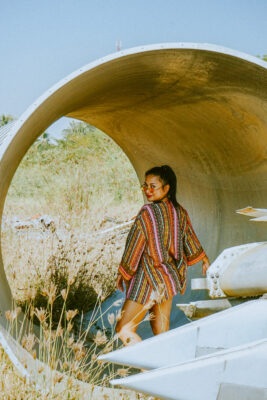
Evan Kristine a.k.a Pretty Wild World is a professional travel blogger with over 10 years of experience in content creation. Originally from the Philippines, she's been living in Finland for 15+ years working as a chef and entrepreneur in Tampere, Finland.
She's an expert in Finland travel and explores the country often sharing her insights and tips in this blog and social medias. She also splits her free time either going for weekend getaways in Europe or galavanting to different European destinations on her holidays. All her useful Europe travel guides are also in this blog!
Evan Kristine is also the food blogger behind at The Kitchen Abroad and on her free time, she enjoys decorating her 75m2 apartment and shares her experience over at Solía Avenue .
A true master of her own life and despite her busy schedule juggling life as a chef, blogger, and entrepreneur, she still finds time to read 50+ books a year and indulge in several hobbies like hiking, working out, yoga, and painting.
Sharing is Caring
Help spread the word. You're awesome for doing it!
Nomadic Matt's Travel Site
Travel Better, Cheaper, Longer
Lithuania Travel Guide
Last Updated: August 31, 2023
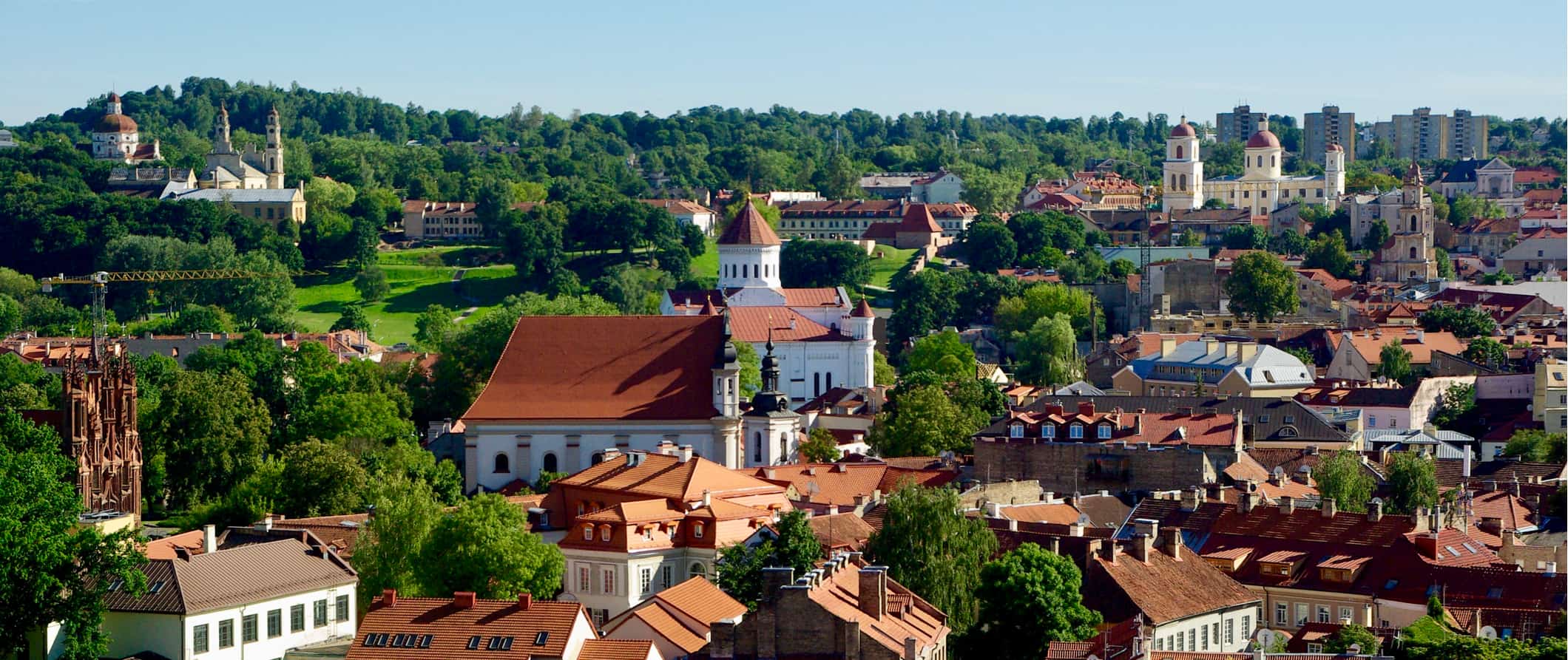
Lithuania is the southernmost Baltic state. It’s also the biggest. Like the rest of the Baltics, I think Lithuania is an underrated destination, especially by American tourists who don’t know much about it or its charming (and affordable) neighbors.
Home to just under 3 million people, Lithuania has blossomed from its drab past into a fun, lively, and affordable budget destination.
It offers a mix of history (you can trace it back to 2,000 BCE), beautiful nature (it has flatlands, abundant forests, lakes, beaches, and dunes), and impressive historic architecture.
The crowning jewel of the country is Vilnius, the country’s capital. In addition to its old town is a UNESCO World Heritage Site, the city is home to a wild and affordable nightlife popular with the backpacker crowd.
In short, Lithuania punches well above its weight and shouldn’t be glossed over by travelers.
This travel guide to Lithuania can give you the tips and tricks you need to plan the ultimate adventure here.

Table of Contents
- Things to See and Do
- Typical Costs
- Suggested Budget
- Money-Saving Tips
- Where to Stay
- How to Get Around
- How to Stay Safe
- Best Places to Book Your Trip
- Related Blogs on Lithuania
Top 5 Things to See and Do in Lithuania
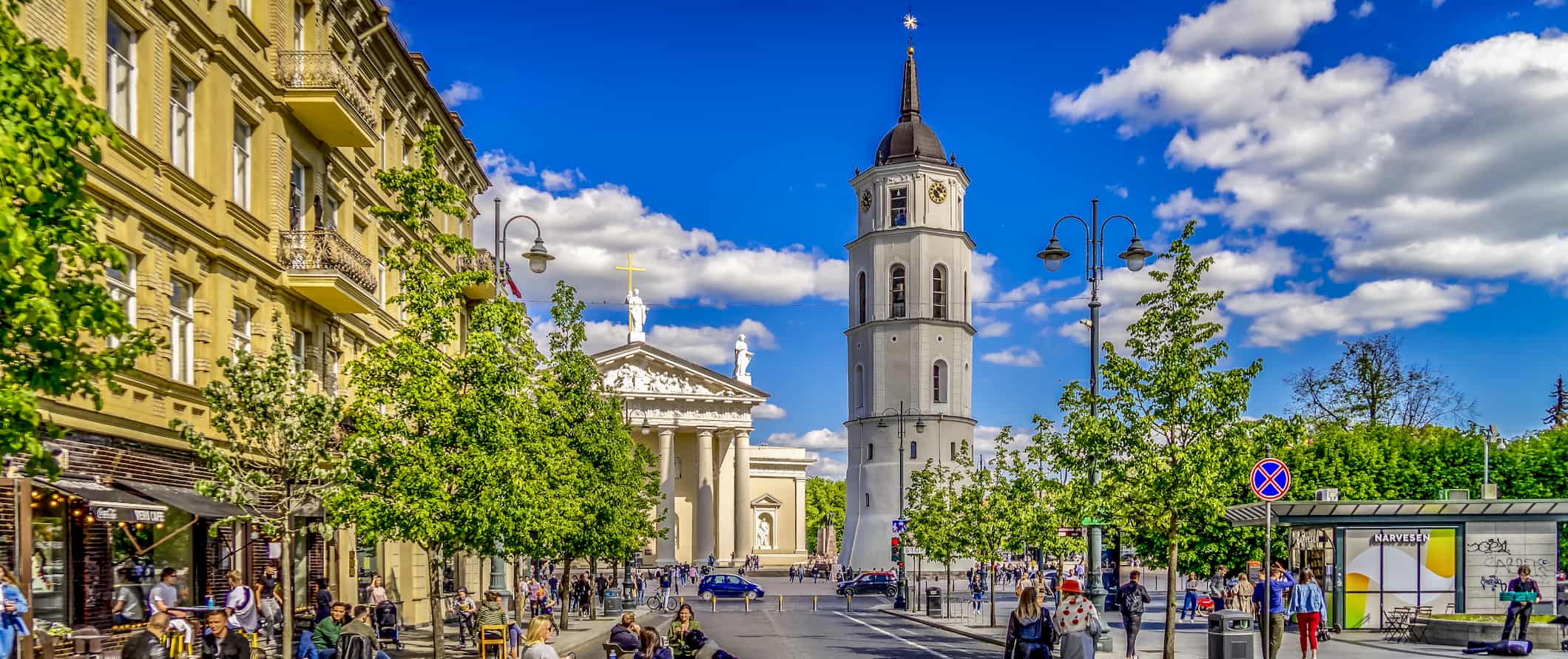
1. Explore Vilnius
Lithuania’s capital city has a historic old town, tons of street art, chill cafes, lots of Gothic and medieval architecture, and a wild nightlife. Explore incredible examples of Baroque buildings along the cobblestone streets of the city’s Old Town and don’t miss the Neoclassical Vilnius Cathedral, or St. Saint Anne’s Church if you prefer Gothic architecture. A walk down Poetry Street pays homage to Lithuanian poets and writers, and the entire city is covered in some of Europe’s best street art. Visit the Museum of Occupations and Freedom Fights (6 EUR) to learn about the city’s dark past and hike up the Hill of Three Crosses for a panoramic view of the city.
2. Visit Kaunas
Kaunas’ student population gives this city a young and energetic vibe. Wander Freedom Avenue (the main shopping street) to take in the city and people-watch. You also should see the Ninth Fort memorial, a genocide memorial and museum (Nazis used the nearby Ninth Fort as an execution site during their occupation). The city is well known for its Interwar era architecture which has been designated as a European Heritage site and you’ll find some of the best examples of Art Deco buildings in Europe here. There’s also a World War II museum (Lithuania was annexed by Germany from 1941-1945) in an old nuclear bunker and a scenic monastery overlooking the sea.
3. Hit the beach in Palanga
Located on the western coast, Palanga boasts long and wide sandy beaches where locals and tourists alike come to relax. White sand and scenic dunes make for a perfect beach day. They are the only beaches of their kind along the Baltic Sea, with 10 kilometers (6.2 miles) to explore. The beach is dotted with resorts, and it’s a popular summer vacation spot for Lithuanians. The town itself is surrounded by forests, and Palanga Park is full of beautiful old-growth trees. The city’s main avenue is filled with bars for those looking to enjoy the nightlife and there’s also tons of green space nearby that’s perfect for hiking and cycling.
4. Hike in Trakai Historical National Park
Opened in 1992, there are over 32 lakes in this park, which is located near Vilnius. It makes a perfect day trip for nature lovers. Be sure to visit Trakai Castle, Lithuania’s iconic 14th-century castle, built on an island in the middle of a lake. An iconic landmark, the well-preserved castle is made from red bricks and offers a peek into the past of Lithuania’s aristocracy. A historic town dating back to the 13th century, a few other castles, and plenty of gorgeous lake views add to the magic. Get Your Guide offers a tour from Vilnius (including an audio guide).
5. See the tallest sand dunes in Europe
Lithuania is home to the tallest shifting sand dunes in Europe. Known as the Curonian Spit, some dunes have been recorded to reach heights of 60 meters (196 feet). Thanks to the specific winds that occur here, the dunes can move at a rate of 15 kilometers (9 miles) per year and in the past have covered entire villages. It’s incredible to see up close!
Other Things to See and Do in Lithuania
1. visit kernave.
Located 35 kilometers (22 miles) from Vilnius, Kernave was the old medieval capital of Lithuania. The area has all kinds of forts, burial sites, and historical and cultural monuments dating back to the late Paleolithic Period. Though the town was destroyed by the Teutonic Knights (a Catholic military order) in the Middle Ages, you can still wander the ruins and learn more about the region’s history. Don’t miss the nearby Kernave Archaeology and History Museum. Admission is 4 EUR.
2. See the Hill of Witches
The Hill of Witches is an outdoor sculpture trail of wooden folk art in Juodkrante, a small town on the Curonian Spit. This art installation brings the forest to life with its creations, taking visitors on a trip through Lithuania’s most popular folk tales and legends. Each of the 80 wooden sculptures was hand-carved by local artists and each sculpture depicts a different character from folk and pagan traditions. Plan to spend around an hour seeing all the sculptures. Admission is free.
2. Visit the Palace of the Grand Dukes
Located in Vilnius, this 17th-century Baroque palace was built for the country’s Grand Dukes. Today, it’s a history and art museum. You can tour stately and ornate ceremonial rooms, see traditional weaponry and armor, and learn about the palace’s history. Most of the palace is a reconstruction as it was first damaged by fire and then later destroyed by the Russians. However, it still does a good job of showing how the ruling class lived during the 17th century and the descriptions are really informative. Admission is 5 EUR.
3. Drink traditional mead
Lithuanians are proud of their traditional beer brewing and there are numerous microbreweries throughout the country. In addition to craft beer, there’s also locally-produced mead, a traditional alcoholic beverage made from fermenting honey. Mead is the oldest alcohol in the world and it’s been said that the mead was so popular in Lithuania in the middle ages that noble families consumed upwards of 30 barrels of it each week. Like beer, expect to pay a few euros for a glass.
4. See the Hill of Crosses
Located 12 kilometers (7 miles) from Siauliai are over 100,000 crosses and religious statues covering an entire hill (93% of the country is Christian and most identify as Catholic). The crosses are believed to have originally been placed there by local Catholics as early as 1831. As the years went by, more and more crosses appeared. The site slowly became a popular place of pilgrimage for Lithuanian Catholics. During the Soviet occupation, the Hill of Crosses became a symbol of national defiance as the Soviets bulldozed the hill three times. The Lithuanian people continued to re-erect the crosses each and every time. These days, visitors often leave a cross, adding to the collection. Admission is free.
5. Visit the Museum of Illusions
This museum opened in 2016 in Vilnius and has some 70 exhibits, including optical illusions and virtual reality. It’s a fun and quirky place to visit, especially if you’re visiting with kids. You can ask the staff to explain the science behind each illusion and exhibit too. Admission is 12 EUR.
6. Explore Anyksciai Regional Park
Easily accessed as a day trip from Kaunas or Vilnius, Anyksciai Regional Park was created in 1992 and spans an incredible 38,000 acres. There are hiking and biking trails, archeological sites, and a super cool 300-meter treetop walking path. The path stands 35 meters (115 feet) above the forest and offers scenic views of the surrounding landscape. There are taller viewing platforms as well that provide 360° panoramic views of the park. Entry is just 1 EUR.
7. Visit the Museum of the Ninth Fort
Like much of Eastern Europe, Lithuania has had a challenging past. In the Museum of the Ninth Fort, you’ll learn about that violent history, from Lithuania’s part in World War I to their 20th-century hard-labor prison camps to the mass killings during World War II. The museum focuses on the atrocities of the wars and their aftermath — and how those atrocities shaped the country and its people. Outside in the museum grounds, there’s a massive 32-meter-tall (104-feet) memorial to the 50,000 Lithuanian Jews who were murdered by the Nazis during the Holocaust. Admission is 6 EUR and guided tours are an additional 15 EUR
8. Go birdwatching in Curonian Spit National Park
Located along Lithuania’s coast near Klaipeda, this UNESCO World Heritage Site is one of the best locations in Lithuania for birdwatching. Expect to see mergansers, egrets, cormorants, and more here. The best time to visit is in September during the migration season. Admission to the park is 5 EUR per vehicle in the off-season and 20-30 EUR per vehicle during the summer (depending on the size of the vehicle). Be sure to visit the nearby spa town of Neringa while you’re here.
9. Visit the Devil’s Museum
For something unconventional and off the beaten path, visit the Devil’s Museum in Kaunas. It boasts a spooky collection of over 3,000 paintings, sculptures, and other works of art of the devil. From traditional religious figurines to political works of social commentary, there’s a lot to see here. The collection began in 1966 and has grown as more and more people donate items. Admission is 5 EUR.
10. Explore Uzupis
If you are looking for Lithuania’s art scene, head to the bohemian neighborhood of Uzupis. When the Soviet Union left the country, a group of artists came together to form the ‘Republic of Angels.’ They consider themselves an independent country, set on 148 acres of land. With 120 residents, they even have their own president, bishop, churches, and a grand total of four official flags. It’s sort of Lithuania’s version of Denmark’s Freetown Christiania. Most walking tours stop here, show you around, and highlight the “country’s” history and evolution.
11. Visit the Museum of Occupations and Freedom Fights
Also known as the Museum of Genocide Victims, this museum was opened in 1992 in Vilnius. It‘s situated in the building where the KGB (the Russian secret police) operated between 1940-1991. The building is a former prison and the place where death sentences were implemented by the Communist regime. Today, it has exhibitions where you can learn about Lithuania’s loss of independence, the Soviet occupation, and the country’s fight for independence.
12. Explore Aukštaitija National Park
North of Vilnius, Aukštaitija National Park is 400 square kilometers (250 square miles) of pine and spruce trees and tons of wildlife (including wild boars). The oldest park in the country, it was established in 1974 and has lots of rivers and lakes (30 and 100 respectively) and numerous hiking trails. There are also a couple of archaeological sites from the 9th-12th centuries here. There’s no fee to enter but there are a few strictly controlled areas that you need a permit to visit or you need to be accompanied by a park employee.
Lithuania Travel Costs
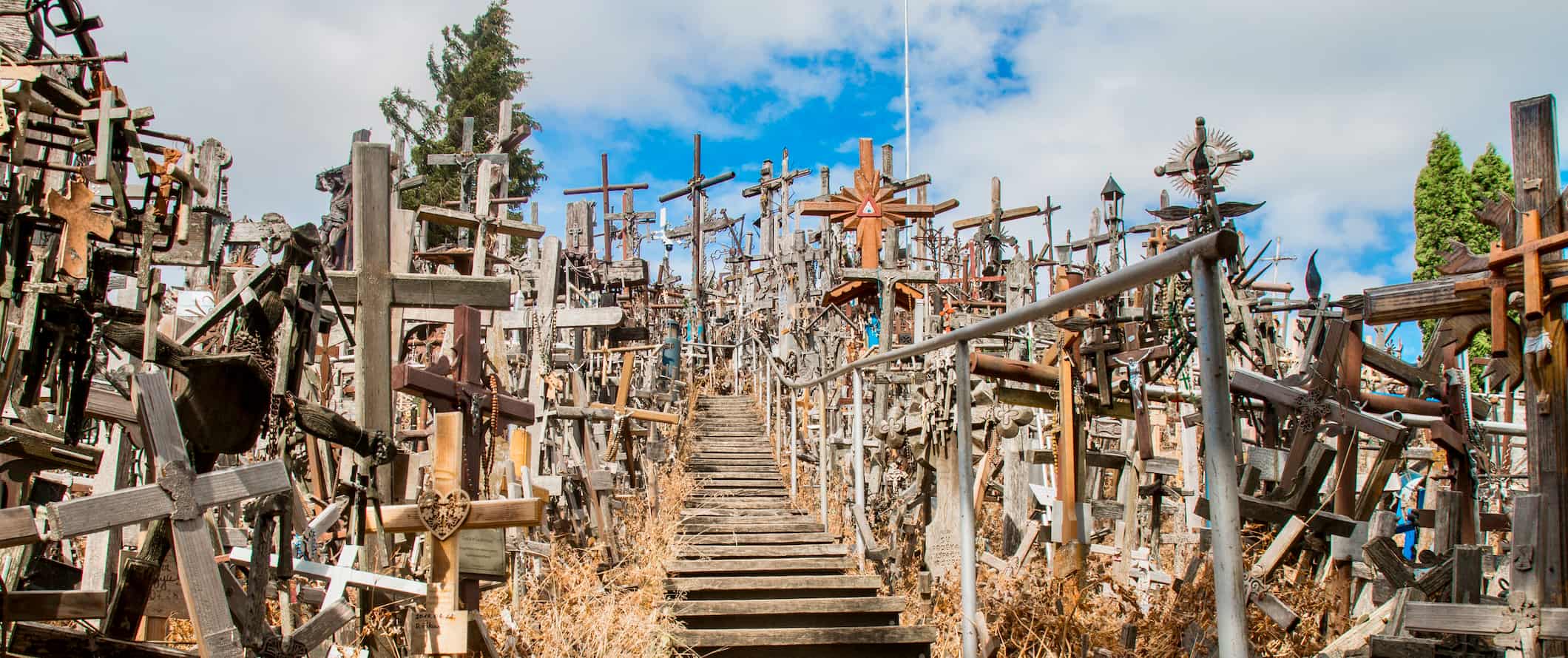
Accommodation – Hostel dorms start around 13 EUR per night for a 8-12-bed dorm. For a 4-8-bed dorm, expect to pay 16 EUR. Free Wi-Fi and self-catering facilities are standard and most of the party hostels run pub crawls, which often include a free drink. For a private room, expect to pay at least 30 EUR per night.
For anyone traveling with a tent, wild camping is perfectly legal and safe (and even encouraged). If you prefer to camp in a formal campground, they are available around the country and cost from 8 EUR per night for a basic two-person plot without electricity.
Budget hotels start around 30 EUR per night for a double or twin. Expect basic amenities like TV, free Wi-Fi, and a coffee/tea maker. Some include free breakfast.
Airbnb is widely available in the country, with private rooms starting at 25 EUR per night (but average double that price when not booked in advance). For an entire home or apartment, prices start at 50 EUR but generally average double that.
Food – Lithuanian cuisine is heavily influenced by traditional rural fare. Mushrooms (and other foraged foods), beetroot soup, smoked sausages, and herring are all common staples. Pickled foods and potatoes are also super popular. Be sure to try cepelinai , the national dish, which are dumplings made from potatoes with a bacon sauce and sour cream. Potato pancakes and fried cheese curd are two other popular dishes to keep an eye out for as well.
When eating out, expect to pay around 8 EUR for an inexpensive meal of local cuisine. Fast food (think McDonald’s) costs around 6 EUR for a combo meal. A pizza costs between 7-10 EUR. For Thai or Chinese food, expect to pay between 8-13 EUR for a main course.
If you want to splash out, a three-course meal of local cuisine including a drink costs around 40 EUR at a more mid-range restaurant.
Expect to pay around 3.50 EUR for a beer. A latte or cappuccino costs around 2.50 EUR while a bottle of water costs 1.25 EUR.
If you are planning to cook your own food, a week’s worth of groceries costs between 25-40 EUR for basic staples like potatoes, meat, pasta, and seasonal produce.
Backpacking Lithuania Suggested Budgets
On a backpacker budget of 45 EUR a day, you can stay in a hostel dorm, cook all your meals, limit your drinking, take public transportation to get around, and do mostly free activities like hiking and free walking tours. Add 5-10 EUR to your daily budget if you plan on drinking.
On a mid-range budget of 110 EUR per day, you can stay in an Airbnb or private hostel room, eat out for most meals, enjoy a couple of drinks, take the occasional taxi to get around, and do more paid activities like visiting museums.
On a “luxury” budget of 210 EUR or more per day, you can stay in a hotel, eat out for all your meals, drink as much as you’d like, rent a car to get around, and do whatever tours and activities you want. This is just the ground floor for luxury though. The sky is the limit!
You can use the chart below to get some idea of how much you need to budget daily, depending on your travel style. Keep in mind these are daily averages — some days you’ll spend more, some days you’ll spend less (you might spend less every day). We just want to give you a general idea of how to make your budget. Prices are in EUR.
Lithuania Travel Guide: Money-Saving Tips
Lithuania isn’t that expensive of a place to visit. As long as you don’t splash out on upscale accommodation and fine dining (or party too much), it’s hard to overspend here. That said, if you want to save some extra money, here are my suggestions:
- Take a free walking tour – Vilnius offers a handful of free walking tours to get you familiar with the city. I always take one when I get to a new city to learn about the history and culture. Just be sure to tip your guide at the end!
- Take the bus – FlixBus is a budget-friendly way to get around the country. They have Wi-Fi, electrical outlets, and decent seats for overnight and long-haul journeys.
- Cook your own meals – Many hostels include kitchen facilities, so if you want to save money make sure you book accommodation with a kitchen. Buying your own groceries may not be as glamorous as going out to eat, but it definitely saves you money.
- Wild camp – If you really want to save money in Lithuania, wild camping is perfectly legal and safe on public land.
- Stay with a local – Staying with a local via Couchsurfing is a fun way to not only save money but you’ll get to meet a knowledgeable local who can share their insider tips and advice.
- Walk everywhere – All of the major cities in Lithuania are quite walkable, so skip the public transportation if you want to save a few euros. Definitely skip the taxis too!
- Enjoy the free spaces – There are plenty of free parks as well as many free hiking trails around the country. Save your budget and enjoy the outdoors!
- Bring a water bottle – The tap water here is safe to drink so bring a reusable water bottle to save money and reduce your plastic use. LifeStraw is my go-to brand as their bottles have built-in filters to ensure your water is always clean and safe.
Where to Stay in Lithuania
Lithuania has lots of clean, fun, and affordable hostels to stay in. Here are some of my favorite places to stay in Lithuania:
- Mikalo House (Vilnius)
- Jimmy Jumps House Hostel (Vilnius)
- The Monk’s Bunk Kaunas (Kaunas)
How to Get Around Lithuania
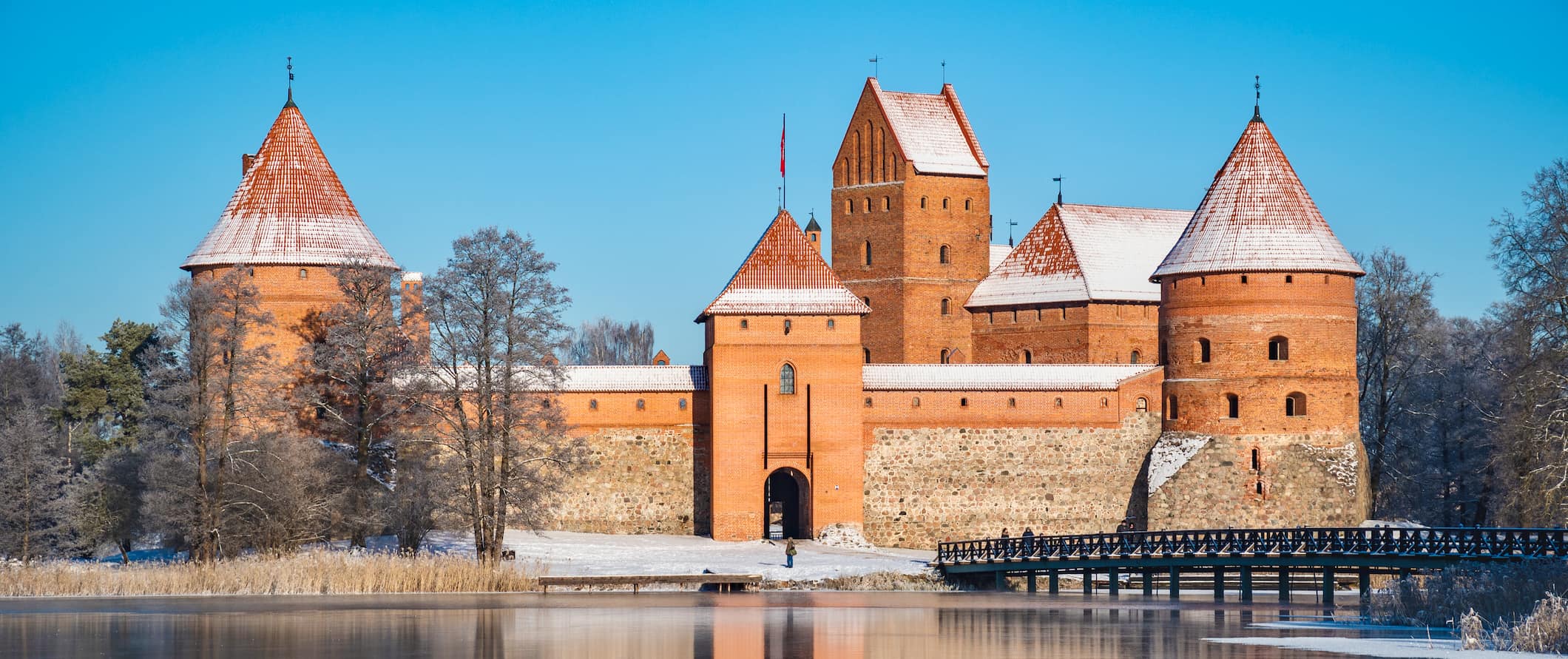
Public transportation – Public transportation in Lithuania is safe, clean, and reliable. Prices vary by city, but tickets in Vilnius cost 0.65 EUR for 30 minutes and 0.90 EUR for 60 minutes. You can get 1-,3-, and 10-day passes for 5 EUR, 8 EUR and 15 EUR respectively. If you pay the driver directly, a one-way fare costs 1 EUR.
Taxi – The starting fare for taxis is 1.30 EUR and then it is 0.60 EUR per kilometer.
Train – Trains in Lithuania are fast and convenient. You can easily reach all the main cities in the country via train. The 70-minute ride from Vilnius to Kaunas costs around 8 EUR while the four-hour ride from Vilnius to Klaipeda costs 22 EUR.
Bus – Buses in Lithuania are a budget-friendly choice for traveling around the country and into neighboring countries. A bus from Vilnius to Kaunas takes just under 90 minutes and costs around 12 EUR. From Vilnius to Klaipeda takes just under four hours and costs 28 EUR. The journey from Vilnius to Riga, Latvia takes 4.5 hours costs 20 EUR.
Flying – There are no domestic flights within Lithuania.
Car rental – Roads in Lithuania are well maintained and car rentals are affordable. Rentals begin at 20 EUR per day for a multi-day rental. While not necessarily cheaper than taking the bus, having a car offers much more freedom. Just make sure you have an International Driving Permit (IDP) as you need one for any car rental in the country.
For the best car rental prices, use Discover Cars .
When to Go to Lithuania
Like its Nordic and Baltic neighbors, Lithuania has short summers and long winters. If you are wanting to get in some beach time then you need to visit between June and August. Even during this time, the temperatures can cool in the evenings so make sure you pack a sweater. Expect daily highs of 20-22°C (68-71°F) during the summer.
To save a bit of money and beat the summer crowds, visit during the shoulder months of April-May or September-October. During these months, it’s still warm enough to spend time outdoors. The national parks are particularly pretty during the autumn.
Winters are cold, with daily temperatures dropping below freezing. While prices are lower, unless you’re here for winter sports, I’d skip a winter visit.
Regardless of the time of year, rain is common in Lithuania so be sure to always keep a raincoat handy. If you plan on hiking be sure to bring a waterproof jacket.
How to Stay Safe in Lithuania
In Lithuania, violent crime is rare. Scams and pick-pocketing are common enough, though, so you’ll want to be vigilant in high-traffic areas in Vilnius, such as bus stations and on crowded public transportation.
If someone strikes up a conversation with you trying to sell something on the street or if young children suddenly approach you, be on alert — someone may be reaching for your wallet while you’re distracted.
Solo female travelers should generally feel safe here, however, the standard precautions apply (never leave your drink unattended at the bar, never walk home alone intoxicated, etc.).
If you rent a car, don’t leave any valuables in it overnight. Break-ins are rare but it’s best to be safe than sorry.
Overall, scams are rare but, to avoid getting ripped off, you can read about common travel scams to avoid right here.
If you experience an emergency, dial 112 for assistance.
The most important piece of advice I can offer is to purchase good travel insurance. Travel insurance protects you against illness, injury, theft, and cancellations. It’s comprehensive protection in case anything goes wrong. I never go on a trip without it as I’ve had to use it many times in the past. You can use the widget below to find the policy right for you:
Lithuania Travel Guide: The Best Booking Resources
These are my favorite companies to use when I travel. They consistently have the best deals, offer world-class customer service and great value, and overall, are better than their competitors. They are the companies I use the most and are always the starting point in my search for travel deals.
- Skyscanner – Skyscanner is my favorite flight search engine. They search small websites and budget airlines that larger search sites tend to miss. They are hands down the number one place to start.
- Hostelworld – This is the best hostel accommodation site out there with the largest inventory, best search interface, and widest availability.
- Booking.com – The best all around booking site that constantly provides the cheapest and lowest rates. They have the widest selection of budget accommodation. In all my tests, they’ve always had the cheapest rates out of all the booking websites.
- HostelPass – This new card gives you up to 20% off hostels throughout Europe. It’s a great way to save money. They’re constantly adding new hostels too. I’ve always wanted something like this and glad it finallt exists.
- Get Your Guide – Get Your Guide is a huge online marketplace for tours and excursions. They have tons of tour options available in cities all around the world, including everything from cooking classes, walking tours, street art lessons, and more!
- The Man in Seat 61 – This website is the ultimate guide to train travel anywhere in the world. They have the most comprehensive information on routes, times, prices, and train conditions. If you are planning a long train journey or some epic train trip, consult this site.
- Rome2Rio – This website allows you to see how to get from point A to point B the best and cheapest way possible. It will give you all the bus, train, plane, or boat routes that can get you there as well as how much they cost.
- FlixBus – Flixbus has routes between 20 European countries with prices starting as low 5 EUR! Their buses include WiFi, electrical outlets, a free checked bag.
- SafetyWing – Safety Wing offers convenient and affordable plans tailored to digital nomads and long-term travelers. They have cheap monthly plans, great customer service, and an easy-to-use claims process that makes it perfect for those on the road.
- LifeStraw – My go-to company for reusable water bottles with built-in filters so you can ensure your drinking water is always clean and safe.
- Unbound Merino – They make lightweight, durable, easy-to-clean travel clothing.
- Top Travel Credit Cards – Points are the best way to cut down travel expenses. Here’s my favorite point earning credit cards so you can get free travel!
Lithuania Travel Guide: Related Articles
Want more info? Check out all the articles I’ve written on backpacking/traveling Europe and continue planning your trip:

The 6 Best Hotels in Copenhagen

The 6 Best Hotels in Florence

The 7 Best Hotels in Madrid

The 6 Best Hotels in Vienna

The Best Walking Tours in Barcelona

How to Be a Digital Nomad in Europe
Get my best stuff sent straight to you, pin it on pinterest.
- Where To Stay
- Transportation
- Booking Resources
- Related Blogs
Best attractions in Lithuania: Top 25

Where to go in Lithuania? When choosing a tour of this country, tourists often ask themselves the question, what to see in Lithuania in the first place? Below are the most interesting sights in Lithuania, which must be visited as part of an introductory tour of the country.
What to see in Lithuania first
Being the closest to the countries of the former Soviet Union, this country is associated with something native and close. In addition, guides in Lithuania perfectly knows not only English, but also Russian, which is even more attractive to travelers from Belarus, Ukraine and Russia. Knowing the main local attractions, you can easily organize the best vacation of your life abroad.
1. Vilnius old town (Vilnius)

The sights of Lithuania begin with the Old Town of Vilnius. It is a true historical center with a special atmosphere of the past centuries and many cultural monuments. The Old Town of Vilnius has preserved the old architecture almost completely. The narrow streets paved with cobblestones and cobblestones allow only for walking. Wandering along these intricate paths among the ancient stone buildings, you can find yourself walking by no less interesting churches - Orthodox, Lutheran, and Catholic. Also worth seeing are museums, hotel yards, educational institutions, and apartment buildings. Here you can get acquainted with the Gothic architecture, see buildings created in the style of the Renaissance, Art Nouveau, Classicism, Baroque. In addition to a visual acquaintance with the historical part of the city, a walk through the Old Vilnius suggests an opportunity to have a snack in a cozy cafe or restaurant. There are also many souvenir shops, where you can buy something as a gift for relatives and friends.
Lithuania | Save on hotel reservations
2. trakai castle (trakai).

Lithuanian sights are full of amazing natural colors and real architectural masterpieces. The Trakai Castle, located 30 km from Vilnius and near the small ancient town of Trakai, is just that. The island castle is a Gothic architectural ensemble. In the center rises a huge princely palace. The main building is surrounded by powerful defensive walls and a lot of towers. The Trakai castle is a must-see in Lithuania. You will be impressed not only by the external picture of the architecture. The excursion through the halls of the palace deserves special attention. The state rooms of the Palace are decorated with frescos, stucco and stained glass windows. Every detail of the interior and exterior speaks of the wealth of the people who once lived within these walls. Even the saddles for the horses were used here in gold. The special romance of a guided walk to the walls of Trakai Castle is in the possibility to admire the water smoothness of lakes Helvia and Luka, washing the approaches to the ancient building.
Official site : http://www.trakai-visit.lt/
3. Neringa resort town (Curonian Spit)

It’s hard to imagine the sights of Lithuania without Neringa Resort City. This rather young tourist corner of the country is especially recommended by guides when answering the question of what to visit in Lithuania in the first place. Neringa was founded in 1961. However, the history of the origins of this wonderful place goes back many centuries. Neringa is situated on the Curonian Spit. The resort town is rightly called the pearl of Lithuania. It is a haven for artists and a place of attraction for tourists from all over the world. There you can truly relax and unwind. The beaches of Neringa are of the highest level of organization and environmental cleanliness. There are many hotels and private inns that welcome visitors all year round. You can go fishing, take a rest, or just enjoy walking to the landmarks and relaxing by the water. Neringa is famous for its tall pine trees, unique vegetation, clean air and mild climate. It is the right place to revitalize the body and relax the soul.
4. Curonian Spit National Park (between Klaipeda and Kaliningrad)

Lithuania’s sights cover a huge territory. Literally every corner of the country is interesting in terms of tourism. Not far from the city of Klaipeda is a unique place - the Curonian Spit. Part of this area is located in Lithuania - Neringa, and part of the Curonian Spit is part of the Kaliningrad region of the Russian Federation - a national park. The park’s territory is washed by the salty waters of the Baltic Sea and the freshwater Kurshsky Bay. The colors of the dune landscapes are truly impressive. In this place, a combination of fir and birch forests is gathered. Vegetation will surprise not only biologists. The brilliance of local plants and the uniqueness of the geographical picture will prompt the spirit of true natural beauty and ordinary tourists. Ecotourism is widespread here. Come to this park, to rest your soul, breathe fresh air and enjoy the untouched beauty of wildlife. Not far from the Curonian Spit is located three residential villages and several tourist centers.
5. Kaunas Castle (Kaunas)

Lithuanian sights such as the Kaunas Castle are a must-see as part of a sightseeing tour of the country. After all, this is something to see in Lithuania that is especially curious, in terms of historical interest, as well as in terms of getting to know the unusual architecture of the past times. Until now, almost a third of the buildings have survived. The castle is of Gothic architectural style. The round building is made of stone. Around the preserved main part of the castle there are two towers, fragments of the fortification wall and other small buildings of intricate forms. You can learn about the history of this Lithuanian landmark in the museum, which is organized in one of the towers. It is noteworthy that colorful theatrical performances are regularly held on the territory of the castle. In this place there are a lot of entertainment events that may be of interest to tourists. Guides in Kaunas recommend visiting the annual operetta festival, medieval music concerts, costume shows.
Official website : http://www.visit.kaunas.lt
6. Amber museum in Palanga (Palanga)

What to visit in Lithuania? Of course, the Amber Museum, located in the city of Palanga! It is a unique museum, which colorfully tells the history of the “sun stone”. Visiting the walls of this attraction, you can plunge into the bright colors of the stone fairy tale. Museum of Amber was opened in 1963 in the building, which once belonged to the famous historical figure - Earl Tyshkevich. The Count’s Palace was built in 1897. Today the walls of the building have been restored, and the surrounding areas are adapted for comfortable walks and recreation. But the most interesting thing is in the 15 halls of the palace. Once you cross the threshold of the museum, you encounter a unique collection of amber. See the “live” beauty of the stone, feel the attraction of amber, listen to the fascinating stories about mining Lithuanian “gold” - all this is offered during a visit to the museum. Here tourists are also told about the life of the founder of Palanga - Earl Tyshkevich. After visiting the museum you can take a walk in the park near the palace.
Official site : http://www.pgm.lt
7. Hill of Crosses (near Šiauliai)

Lithuanian sights related to local shrines are especially interesting and impressive! For example, the famous Mount of Crosses is a must-see in Lithuania. The unusual hill is about 12 kilometers from the city of Šiauliai. On the hill there are more than 50 thousand crosses of different size and shape. It remotely resembles a cemetery, but there are no graves in this place. There is a legend that explains why there are so many symbols of faith. It turns out that by placing the cross on the hill, people hope to attract good luck. This is exactly the reward everyone who sets his cross on the mountain will receive, if the prophecy is to be believed. In this place you can see crosses of all kinds. There are both huge wooden crucifixes and small crosses. There are entire statues created in the form of the holy face of Christ, and there are simple wooden crosses without additional patterns and inscriptions. The atmosphere of this place is strange, but light. This is something really worth visiting in Lithuania. Memories after visiting the holy hill, will remain vivid. And who knows, maybe luck will really smile.
Official site : http://www.hillofcrosses.com/

Lithuanian sights are fascinating with a huge number of protected places of nature. Kernavė Museum Reserve is a tourist destination that is especially popular with visitors. Kernavė is the first capital of Lithuania. It is a complex of five settlements, 35 km from Vilnius, on the banks of the Neris River. This wonderful place keeps the memory of the history of the development of the country and the Baltic peoples. Traces of the civilizations that lived here in the 10th century B.C. have been found in this reserve. This place is especially attractive in early July. The Days of Living Archaeology festival is organized to celebrate the State Day in Kernav. During this period it is possible to see grandiose performances demonstrating the peculiarities of ancient crafts. There is old-time music everywhere, and every detail of the festival has a distinctive local flavor. You can also try different medieval entertainment. For example, you can compete in the martial arts or touch the skills of medieval warfare.
Sights in Lithuania: What else to see while in Lithuania
The list of historical monuments, parks and those places that may be of interest to travelers in this state is extremely extensive. Below you will find photos and descriptions of tourist sites that are included in many tours in Lithuania , and you can decide whether or not to include them in your sightseeing itinerary.
9. Kaunas Old Town (Kaunas)

Lithuania’s sights are crowned by perhaps the most impressive part of the country, the old town of Kaunas. The old part of Kaunas concentrates a huge number of unusual monuments of architecture. The atmosphere here is saturated. The area is simply mesmerizing in its beauty. Start your trip to the old part of town with the Town Hall Square. Here you can see the former Palace of Marriages, and now the White Swan of Kaunas - the City Hall. Further along the way you can see the Kaunas Cathedral of Peter and Paul. The pedestrian street Vilniaus deserves special attention. Here you can walk and enjoy the beauty of the old part of town. Street is very lively and colorful. Walking along it you can see a lot of strange buildings. Part of the buildings are given under the residential premises, but a greater number of buildings occupied by a cozy cafes, souvenir shops, stores. After walking along the pedestrian street Viliņiaus and visiting the stores and cafes, it is worth going to Laisves Alley - the widest pedestrian boulevard of the old city.
10. Cathedral (Vilnius)

A list of must-see places to visit when exploring Lithuania would be incomplete without such a sight as the Vilnius Cathedral. It is the most important Roman Catholic cathedral in Lithuania. The cathedral was given the status of a “small basilica”. The history of the cathedral goes back centuries. The building literally “remembers” the days when Vilnius was founded. It is the oldest cathedral in Lithuania, in which the great Lithuanian princes were crowned. The cathedral is located in the center of Vilnius, at the foot of the Zamkova Mountain. The building has gone through many changes, including some destructive ones. Nevertheless, today the cathedral retains its status as one of the most beautiful architectural monuments in Lithuania. It is built in the style of classicism. Its exterior resembles that of an ancient Greek temple. Inside it is no less attractive in terms of decoration. Unique paintings, frescoes and other works of art create a unique coloring of the interior decoration of the temple. On the lower tier of the cathedral there is a museum, which carefully preserves the history from pagan times.
Official site : http://www.piligrimukelias.lt
11. The Witches Mountain (Curonian Spit)

Lithuania’s sights not only impress with beauty, but also shock with mystery. The Witches’ Mountain is a must-see in Lithuania! This mystical place is located in the Curonian Spit area. Witches Mountain is represented by a beautiful dune, which has a parabolic shape. There are mysterious rumors and curious legends around this amazing sight. It is believed that this mountain appeared, thanks to the Giantess Neringa. When you come to these places, you can enjoy the fabulous scenery of local nature. There are intricate sculptures of characters from Lithuanian folklore on the mountain. Walking around the mountain, you can literally feel the mystical atmosphere of the place. If you manage to look at the mountain from afar, you can understand why there is an opinion that the mountain is divided between light and dark forces. Visually, the elevation is divided into two colors. One half of the mountain is lighter than the other. To visit the Mountain of Witches will be interesting even to those who do not believe in fairy tales. Clean air, beautiful nature, special local relief - this is something that in itself fascinates the eye and without the accompaniment of fairy tales and mysterious tales.
12. St. Anne’s Church and Bernardine Church (Vilnius)

The sights of Lithuania are represented by a variety of local shrines. One of the most interesting monuments of architecture located in Vilnius is the Church of St. Anne and Bernardine Church. The church is located in the Old Town on Mairone Street. The building was created in the classic Gothic style. The architecture of the shrine is striking in its forms and depth of style. Going to this Lithuanian landmark, you can enjoy not only the unique architectural pattern of the structure, but also touch the history. In the temple, there is an exhibition showing the history of the cathedral’s oldest building, from the times when it was a pagan sanctuary to the present day. In the lower tier of the temple, there are tombs of famous personalities: princes, bishops and nobles. In the main room of the temple there are fourteen altars with wooden sculptures of saints. The beauty and attractiveness of this temple is difficult to convey in words. It is better to see it once and see for yourself how beautiful the architectural image of the Lithuanian capital is.
Official site : http://www.onosbaznycia.lt
13. Tyshkevich Palace (Palanga)

One of the most popular Lithuanian resorts is Palanga , where people go to enjoy the cleanest pine air, relax in the sands of the Curonian Spit and dip in the waters of the Baltic Sea. Palanga owes its well-being to the Tyshkevich family, who greatly contributed to improvement of the resort town, development of roads and local beaches. The symbol of the resort is the Earl’s Tyshkevichi manor, an elegant and noble palace. Once it was wooden and served as a summer residence of counts, but years later one of the heirs of the famous family decided to settle here for a long time, so he commissioned a German architect to design a new stone building. The new two-storey palace took on Baroque, Renaissance and Classicist features, and after restoration in the 1950s it was opened to the public. Today the palace houses the world-famous Amber Museum, the precious stone that the Baltic Sea coast is rich in.
14. Lithuanian Sea Museum and Aquarium (Klaipeda)

Sea Museum in the city of Klaipeda can be called one of the best options for what to see in Lithuania in winter. This cozy and exciting place is located on the northern tip of the Curonian Spit in the premises of Kolgalis, a fortress of the 19th century. All in all, the museum complex includes several departments - in addition to the Maritime Museum itself, there is the Natural Museum of the Curonian Spit, the Aquarium and the Dolphinarium. On the way to the fort the first is the Maritime Museum, where you can get acquainted with the peculiarities of everyday life of local fishermen and see a boat, built by an amateur fisherman on the basis of ancient drawings. In the building of the fort there is a complex of aquariums - 34 small and one large one, which contains more than a hundred species of fish and other inhabitants of the Baltic Sea and the Curonian Lagoon. Finally, the main pride of the museum is the dolphinarium, where regular performances and interesting facts about the life of dolphins are presented.
Official site: https://muziejus.
15. Acute Brahma (Vilnius)

Once in the early 16th century, Vilnius was surrounded by a strong fortress wall with five gates, one of which has survived to this day - the Ostrea Brama Gate. Such an unusual name some attribute to the family name of Princes Ostrogsky, others - to the long metal spikes, which were set in the fortress wall. Anyway, today Ostrya Brama is an architectural monument, in which Gothic style and Renaissance are mixed. The gate’s attic is decorated with the Lithuanian coat of arms and the image of Hermes with a winged helmet; the outer side of the tower is decorated with the coat of arms of the Lithuanian principality; below it there is a mural depicting the Savior; and on the right side of the tower there is a small section of the restored fortress wall. Directly above the gate is the Chapel of Our Lady of Ostrobram, one of the most famous and revered icons in Lithuania. The icon of the Virgin Mary inside is believed to have miraculous powers.
Official website: https://www.ausrosvarta
16. Gedimin’s Tower (Vilnius)

The historic centers of the Baltic capitals are veritable treasure troves of objects of antiquity, with narrow cobbled streets, odious cathedral spires, mysterious alleyways and mystical basements of old houses. Sights of Estonia, Latvia and Lithuania, among which the medieval castles and historic towers have a special place, will tell about the centuries-old heritage of the Baltic states. For example, the Gediminas Tower, named after the founder of Vilnius, Prince Gediminas, adorns the Old Town of Vilnius. The tower is 48 meters tall and stands on the Castle Hill, offering a beautiful view of the Old Town of Vilnius. The tower was once part of the Upper Castle, built in the 14th and 15th centuries, and today among the fortifications only Gedimin’s Tower has survived in its original form. The tower has been repeatedly destroyed and rebuilt, and in its present form it is an 8-cornered structure, within the walls of which is a branch of the Lithuanian National Museum.
Official site: http://www.lnm
17. Laisves Alley (Kaunas)

Laisves is the Lithuanian Freedom Alley in Kaunas, which is a pedestrian street more than 1.5 km long and up to 27 meters wide. It is a great place for walking and recreation, located near the Old Town, so when you explore the historic center, you can sooner or later get to the Laisves. The beautiful green boulevard is framed by slender rows of linden, maple and chestnut trees, and along it are many stores and souvenir shops, bars and cafes, museums and theaters, monuments and fountains. So when you get to this avenue, you can always find something to do - whether it is shopping, a cultural program or even a bike ride. Laisves is a mirror of city life - it regularly hosts festivals and various processions, festive and tragic events. Among the latter is the act of self-immolation as a protest against the Soviet occupation, which was committed in 1972 by Romas Calante - in memory of this hero there is a plaque on the alley.
18. Park of Europe

A tourist map of Lithuania shows that just 20 km from Vilnius there is an open-air art museum, where the beauty of nature and the charm of modern art are wonderfully intertwined. The Park of Europe is located right in the middle of a wooded area, and its origins date back to the early 1990s. That’s when it became known that in this place is the geographical center of Europe, which it was decided to mark through art. The initiator of the arrangement of the park was sculptor Gintaras Karosas who addressed an invitation to his colleagues from all over the world to take part in the decoration and to place their works here. The sculpture park began its existence with the installation of a stone pyramid on which a pointer indicating the distances to all the capitals of Europe was installed. Later the collection was enriched by hundreds of art objects, which were donated to the park by artists and sculptors from many countries around the world.
Official website: http://www.europo
19. IX Fort of the Kovno Fortress (Kaunas)

For those interested in Lithuanian military landmarks, the presentation recommends a visit to the city of Kaunas. It is here that the Kovno Fortress is located, a masterpiece of fortification that could have become one of the centers of tourism, if not for a grim milestone in its history: during World War II, this fort became a place of mass extermination of Jews and Poles. Tens of thousands were killed in Forts 7 and 9, among them it was the 9th that was used as a prison for prisoners. When the prison was overcrowded, its prisoners were driven into a ditch and shot, and their bodies were covered with quicklime and burned in order to destroy any evidence of large-scale murder. Sixty prisoners, however, managed to escape and the atrocities of the Nazis were known before the war was over. Today Fort 9 is the best preserved of all the fortifications, it has been restored and houses a museum dedicated to the tragedy of the Holocaust.
Official website: http://www.9fort
20. Druskininkai town (southern Lithuania)

Magnificent pine forests, wide sandy beaches, emerald sea, ancient homesteads, health-improving rest and effective treatment - all this is resort Lithuania. Spa cities, though not always can boast clear and warm weather, but local sea air, mixed with the scent of pine is extremely pleasant and healthy. One of the most well-known and popular balneological resorts of the country is Druskininkai. There is a number of mineral springs which serve as a basis for the work of local balneotherapeutic resorts. Along with waters of various degrees of mineralization, local soils are also famous for therapeutic peat muds used for treatment of various diseases. Apart from sanatoriums, the resort has a number of spa centers, hotels, health resorts, entertainment centers for adults and children. Also Druskininkai regularly becomes a place of interesting events - festivals and master classes.
Official website: https://www.druskininkai
21. Palace of the Grand Dukes of Lithuania (Vilnius)

The Palace of the Grand Dukes of Lithuania is not quite an ordinary historic castle: on the one hand it is the most important national symbol of the country, on the other - a new building, reconstructed in our days on the model of the construction of the 15th century. In the 4-8th centuries the first settlement was located on this site and the constructions were of wood, while in the 13th century the first stone fortifications appeared. The ancient lower castle was built in the 15th century, but over the next 3 centuries, it was rebuilt, changing the architectural style, and by the 17th century was half destroyed after the invasion of Russian troops. The idea to rebuild the original structure appeared in the 1980s, and only in the early 2000s it began to materialize. Seven years later the castle was erected and officially opened, and 6 years later it received its first visitors. Today there are expositions revealing the role of the ancient residence and displaying various historical findings.
Official website: https://www.valdovur
22. Old Town of Klaipeda (western Lithuania)

If your itinerary in Lithuania covers the western part of the country, you can visit the ancient city of Klaipeda, divided by the Dange River into two parts: on the right side is the modern city center, on the left - the Old Town of Klaipeda, preserving the old shape and atmosphere of the past centuries. In the narrow streets of the Old Town there are Lithuanian houses neighboring with German ones. Since the 13th century the town was owned by Germans, and Lithuanians, who were not allowed to settle there, used to live in the outskirts of the town. During World War II when the Soviets occupied the city, the Germans were expelled to their historical homeland; after some time the city was inhabited by the natives as well as the Russians and the Belarusians. Among the historical monuments of Klaipeda there are part of the fort on the Curonian Spit, the remains of Memelburg Castle, and among the German heritage - numerous houses of burghers and merchants.
23. Aukstaitija National Park (north-east of Lithuania)

In the 1970s, the first national park, later renamed Aukstaitija National Park, appeared on Lithuanian territory. It is located about a hundred kilometers north of Vilnius, covers an area of about 400 square kilometers, and most of its area is covered by forest. The rest of the territory is occupied by mirror-like lakes, picturesque rivers and brooks. Among the lakes, the largest is Kretuonas, the deepest is Tauragnas, the most unusual is Baluošas, it has 7 islands, one of which has its own lake. The abundance of forests and reservoirs creates perfect living conditions for hundreds of species of birds and animals. Local reservoirs attract visitors not only with their beauty, but also with excellent conditions for fishing - there are dozens of species of fish, there are rental stations for boats and equipment. There are about 120 villages on the territory of the reserve - these are interesting places, popular with tourists, where you can admire the mills and wooden churches.
Official website: https://www.aparkai
24. Dzukija National Park (southern Lithuania)

A serene vacation at the Druskininkai resort can be diversified with a trip to nearby attractions. When looking for something to see around Druskininkai, you can stop at the picturesque landscapes of the Dzūkija National Park. It was once created to preserve the local forests and villages, as well as to protect the natural landscape of the region. The park’s vast territory of almost 600 square kilometers stretches along the Neman River and is a land of pine forests, crystal-clear rivers, lakes and continental dunes. Among the most attractive places are the unique villages of the pine dunes, where at any time of the year you can go on a trip - on foot, by bike or by canoe. Visitors are very interesting to meet on the way hollow pines - ancient relics for beekeeping, in which artificially made passages for bees.
Official site: http://gamta.cepkeliai
25. Rumsiskes ethnographic museum (Lithuania)

About 30 kilometers from Kaunas is Rumsiskes - a vast open-air ethnographic museum, where all the natural beauty of the Lithuanian land is revealed. It is here that you can get a full sense of the spirit of Lithuania, experience the atmosphere of the past and listen to stories about Lithuania of the 18th and 20th centuries. The 174-hectare museum features almost two hundred buildings from different parts of the country, some of which are more than 200 years old. The natural scenery features huts, outbuildings, mills, chapels, farmsteads and front gardens. Along all this splendor laid a circular hiking route length of about 6 kilometers. The central place in the park occupies a paved square, where the atmosphere of the old county is recreated. Here, in the old tavern you can try dishes of national cuisine, and in the museum of everyday life - you can see how to make clay pots, weave lace, create jewelry from amber, leather and wood.
Next door to Lithuania is a country famous for its wide beaches and huge dense forests - Latvia. When traveling in Lithuania, consider visiting Latvia. Read about sights of Latvia and get inspired for your future journey around Europe!
- Sightseeing
Popular articles

World's Most Beautiful Places: Top 45

Best attractions in Lviv: Top 30

Best attractions in Moldova: Top 13

Best attractions in South Korea: Top 25

Best attractions in Dresden: Top 20

Best attractions in Tokyo: Top 35

Best attractions in Jerusalem: Top 30

Best attractions in Argentina

Best attractions in Helsinki: Top 30

Best attractions in Rio de Janeiro: Top 20

Best attractions in Tunisia: Top 25

Best attractions in Lisbon: Top 35

No videos yet!
Click on "Watch later" to put videos here
Lithuania Travel Guide – Everything You Need to Know

Nestled in the heart of the Baltic region, Lithuania welcomes visitors with a rich tapestry of culture, history, and natural beauty. Steeped in a fascinating past that includes medieval grandeur, Soviet influence, and a resilient spirit of independence, Lithuania boasts enchanting old towns, architectural marvels, and serene landscapes. Vilnius, the capital, captivates with its UNESCO-listed Old Town, while Trakai Castle, set on a tranquil lake, showcases the country’s medieval heritage. The Curonian Spit, a UNESCO World Heritage site, beckons with pristine sand dunes and pine forests along the Baltic Sea. Lithuania’s warm hospitality, vibrant festivals, and a burgeoning contemporary scene make it a compelling destination for those seeking a harmonious blend of history and modern allure.
What’s the Best Time to Visit? 📅
The best time to visit Lithuania as a tourist depends on your preferences and the experiences you seek, as each season offers its unique charm.
- Summer is the peak tourist season, characterized by mild temperatures, longer daylight hours, and vibrant green landscapes. It’s an excellent time for outdoor activities, festivals, and exploring the country’s natural beauty, including the Curonian Spit and Lithuania’s lakes.
- Spring and autumn offer milder temperatures and fewer crowds compared to the summer months. It’s an ideal time for those who enjoy sightseeing without the peak-season hustle. Spring brings blooming flowers, while autumn showcases colorful foliage.
- Winter in Lithuania can be cold with temperatures often below freezing. However, if you enjoy winter sports like cross-country skiing or are drawn to festive holiday markets, this season can be magical. Vilnius and other cities are adorned with holiday decorations, creating a festive atmosphere.
Ultimately, the best time to visit Lithuania depends on your interests and the type of experience you desire. Whether you prefer the lively atmosphere of summer festivals, the tranquility of spring or autumn, or the charm of a winter wonderland, Lithuania has something to offer year-round.
What’s the Best Way to Get Around? 🚌
Lithuania offers various transportation options for tourists to explore its cities, towns, and scenic landscapes. Here are some recommended ways to get around Lithuania:
- Buses: Lithuania has an extensive and well-connected bus network that reaches cities, towns, and even remote areas. Buses are a cost-effective and efficient way to travel between locations.
- Trains: The railway network connects major cities like Vilnius, Kaunas, and Klaipėda. Trains provide a comfortable and scenic way to travel across the country.
- Renting a car is a popular option for exploring Lithuania, especially if you want to venture into more remote areas or picturesque landscapes. The road infrastructure is well-maintained, and driving allows for flexibility in your itinerary.
- Taxis are readily available in urban areas and can be a convenient option for short trips within cities. It’s advisable to use reputable taxi services, and you can ask your accommodation for recommendations.
- Lithuania is a bike-friendly country, and many cities have dedicated bike lanes. Renting a bicycle is a great way to explore urban areas, parks, and scenic routes. Vilnius, in particular, offers a bike-sharing system.
- While Lithuania is a small country, there are domestic flights available. However, for most tourists, flying is not necessary for domestic travel, as ground transportation is efficient.
- Many Lithuanian cities, especially the historic Old Towns, are pedestrian-friendly. Walking allows you to immerse yourself in the local atmosphere, explore narrow streets, and discover hidden gems.
- Guided tours and packages are available for specific attractions or regions. These can be convenient for those who prefer a structured itinerary with a knowledgeable guide.
- Besides local buses, long-distance coaches connect major cities and towns. This can be a comfortable and affordable option for traveling between regions.
Choose the transportation mode based on your preferences, the distance you plan to cover, and the experiences you seek. Public transportation is generally reliable, and the compact size of Lithuania makes it easy to navigate by various means.
What’s the Official Language?
The official language of Lithuania is Lithuanian. Here are some useful Lithuanian phrases for tourists:
- Hello – Labas
- Goodbye – Viso gero
- Please – Prašau
- Thank you – Ačiū
- Yes – Taip
- No – Ne
- Excuse me / I’m sorry – Atsiprašau
- Do you speak English? – Ar kalbate angliškai?
- Help – Pagalba
- How much is this? – Kiek tai kainuoja?
- Where is…? – Kur yra…?
- I don’t understand – Aš nesuprantu
- I need a doctor – Man reikia gydytojo
- Cheers! – Į sveikatą!
- Good morning – Labas rytas
- Good evening – Labas vakaras
- My name is… – Mano vardas…
- What’s your name? – Koks jūsų vardas?
- Where are you from? – Iš kur jūs esate?
- I love Lithuania – Aš myliu Lietuvą
Learning a few basic phrases in the local language can enhance your travel experience and often be appreciated by locals. While many Lithuanians, especially in urban areas, speak English, making an effort to use their language can go a long way in fostering positive interactions.
Where to Stay? 🏨
Lithuania offers a variety of accommodation options for tourists, ranging from budget-friendly to luxurious. Here are some recommended places to stay in Lithuania:
- Old Town: Vilnius’ Old Town is a popular choice for accommodation. It boasts charming cobblestone streets, historic architecture, and a vibrant atmosphere. There are numerous hotels, guesthouses, and boutique accommodations in this area.
- Užupis District: Known for its artistic and bohemian vibe, Užupis is an alternative neighborhood with unique accommodations. It’s within walking distance of the Old Town.
- Business District: If you prefer a more modern setting, consider staying in the business district, where you’ll find international chain hotels and convenient access to amenities.
- Old Town: Kaunas’ Old Town is characterized by its medieval architecture and lively ambiance. Many hotels and guesthouses offer a comfortable stay while being close to historical attractions.
- City Center: The city center also provides various accommodation options, with easy access to shopping, dining, and cultural sites.
- Old Town and Port Area: Klaipėda’s Old Town and the nearby port area are popular for accommodation. The Old Town exudes maritime charm, while the port area offers scenic views of the Baltic Sea.
- Around Lake Galvė: Trakai is famous for its stunning castle on Lake Galvė. Staying in the vicinity of the lake allows you to enjoy picturesque views and easy access to the castle.
- Seafront: Palanga, a popular seaside resort, offers accommodations along the seafront. This area provides a beachy atmosphere and proximity to the Baltic Sea.
- City Center: Druskininkai, known for its spa resorts and wellness facilities, has accommodations in the city center. This area offers convenience for exploring local attractions.
- If you’re interested in experiencing Lithuania’s rural charm, consider staying in guesthouses or farmsteads in the countryside. This provides an opportunity to connect with nature and local traditions.
When choosing accommodation, consider your preferences, budget, and the activities you plan to engage in. Booking in advance is recommended, especially during peak tourist seasons. Major online travel platforms can help you find a variety of options tailored to your needs.
What to Eat? 🍽️
Lithuania boasts a rich culinary tradition, with dishes that reflect the country’s agricultural heritage and historic influences. Here are some must-try Lithuanian foods for tourists:
- These potato dumplings are typically filled with minced meat, curd, or mushrooms. They are often served with sour cream and bacon bits, creating a hearty and flavorful dish.
- This refreshing pink soup is made with beets, kefir (fermented milk), cucumbers, dill, and hard-boiled eggs. It’s a popular summer dish, known for its vibrant color and unique taste.
- Kugelis is a traditional Lithuanian potato dish, often described as a potato pudding or cake. It consists of grated potatoes, bacon, onions, eggs, and milk, creating a dense and savory dish.
- Potato pancakes are a common Lithuanian dish, especially during celebrations. They are made from grated potatoes mixed with flour, eggs, and seasoning, then fried until golden brown.
- This popular snack features rye bread cubes fried until crispy and then rubbed with garlic. It’s often served with cheese or various spreads.
- Koldūnai are small, filled dumplings that can be boiled or fried. They are typically filled with meat, mushrooms, or curd and served with sour cream or butter.
- Lithuania’s proximity to the Baltic Sea makes smoked fish a delicacy. Try smoked eel, herring, or lamprey for a taste of the local seafood.
- Skilandis is a Lithuanian sausage made from minced meat, garlic, and various spices. It’s air-dried and smoked, resulting in a flavorful and aromatic sausage.
- Herring is a staple in Lithuanian cuisine. Try it marinated and served with onions for a classic taste of the sea.
- Šakotis is a traditional Lithuanian cake resembling a tree. It’s made by layering thin batter on a rotating spit, creating a unique and visually appealing dessert.
Don’t forget to accompany your meals with Lithuanian beer, which is well-regarded for its quality and variety. Exploring local markets and traditional restaurants is a great way to experience the diverse flavors of Lithuanian cuisine.
What to See? 🔍
Lithuania is a country rich in history, culture, and natural beauty. Here are some must-see places for tourists:
- Explore the UNESCO-listed Vilnius Old Town, known for its well-preserved medieval architecture, cobblestone streets, and historic sites such as Vilnius Cathedral, Gediminas Castle, and the Gate of Dawn.
- Located on an island in Lake Galvė, Trakai Castle is a picturesque medieval fortress surrounded by water. It offers a glimpse into Lithuania’s history and is easily accessible from Vilnius.
- The Hill of Crosses is a unique and sacred site covered in thousands of crosses, each representing a prayer or a memory. It’s a powerful symbol of resistance and faith.
- This UNESCO World Heritage site is a narrow sand dune peninsula that separates the Curonian Lagoon from the Baltic Sea. It features stunning landscapes, sandy beaches, and traditional fishing villages.
- Kaunas, Lithuania’s second-largest city, has a charming Old Town with medieval architecture, vibrant markets, and the impressive Kaunas Castle overlooking the confluence of the Nemunas and Neris rivers.
- Located on the Curonian Spit, the Hill of Witches is an outdoor sculpture gallery featuring wooden sculptures depicting characters from Lithuanian folklore and pagan traditions.
- Although located just across the border in Latvia, Rundale Palace is a magnificent Baroque palace worth visiting. It was designed by the same architect who created the Winter Palace in St. Petersburg.
- Immerse yourself in nature at Aukštaitija National Park, known for its pristine lakes, dense forests, and traditional wooden villages. It’s an excellent destination for hiking, boating, and exploring Lithuanian folklore.
- Another national park offering beautiful landscapes, Žemaitija National Park features lakes, rivers, and the iconic wooden Žemaitija Hillfort, providing panoramic views of the surrounding area.
- Explore the stunning Amber Museum housed in a 19th-century palace surrounded by beautiful gardens. The museum showcases a unique collection of amber, often referred to as “Baltic gold.”
These are just a few highlights, and Lithuania has much more to offer. Whether you’re interested in history, nature, or cultural experiences, Lithuania has a diverse range of attractions to explore.
What to Do? 📸
Lithuania offers a range of activities that cater to various interests. Here are some must-do things for tourists in Lithuania:
- Discover the history and charm of Vilnius by exploring its Old Town on foot. Join a guided walking tour to visit key landmarks, hidden gems, and learn about the city’s rich history.
- Hike or take a funicular to the Three Crosses Hill for panoramic views of Vilnius. The crosses are a symbol of the city and offer a picturesque setting for photography.
- Experience Lithuanian culture by attending a traditional song and dance festival, known as a “Dainų šventė.” These events celebrate the country’s folk traditions and are held periodically.
- Enjoy a boat trip on Lake Galvė to get closer to Trakai Castle and explore the surrounding natural beauty. It’s a relaxing way to appreciate the landscapes.
- Immerse yourself in Lithuanian traditions by joining a folk workshop. Learn to make traditional crafts, try your hand at traditional dances, or participate in a cooking class.
- Spend a day or more relaxing on the sandy beaches of the Curonian Spit. The beaches offer a peaceful retreat, and the unique landscape adds to the overall experience.
- Basketball is the most popular sport in Lithuania, and attending a game is a cultural experience. Cheer for a local team and witness the passion that Lithuanians have for this sport.
- Located in Rumsiskes, the Open-Air Museum provides a glimpse into traditional Lithuanian rural life. Explore authentic wooden buildings, learn about traditional crafts, and experience rural customs.
- Gain insights into Lithuania’s complex history by visiting the Museum of Genocide Victims in Vilnius. The museum is located in the former KGB headquarters and documents the country’s Soviet occupation.
- Savor Lithuanian cuisine by trying cepelinai, the iconic potato dumplings. Visit a local restaurant to enjoy this hearty dish, often served with sour cream and bacon.
- Experience Lithuania from above by taking a hot air balloon ride. Enjoy breathtaking views of landscapes, lakes, and historic sites.
- Witness the Hill of Crosses at sunset for a magical and serene experience. The atmosphere becomes even more mystical as the sun sets behind this iconic pilgrimage site.
These activities offer a mix of cultural immersion, outdoor exploration, and culinary delights, providing a well-rounded experience of Lithuania.
Culture and Safety 🦺
Culture in Lithuania:
Lithuania has a rich cultural heritage that reflects its history, traditions, and influences from neighboring countries. Here are some cultural aspects to keep in mind when traveling to Lithuania:
- The predominant religion in Lithuania is Roman Catholicism. Many cultural traditions and festivals are tied to religious celebrations, so it’s respectful to be aware of and appreciate these customs.
- Lithuanian is the official language, and while many Lithuanians speak English, especially in urban areas and tourist destinations, it’s helpful to learn a few basic Lithuanian phrases as a gesture of goodwill.
- Lithuania has preserved some pagan and folk traditions that are celebrated through festivals, rituals, and crafts. Participating in or observing these events can provide a deeper understanding of the country’s cultural identity.
- Lithuanians are known for their hospitality. If invited to someone’s home, it’s customary to bring a small gift for the host. A polite demeanor and expressing appreciation for the local culture are valued.
- Lithuania has a vibrant arts scene with a strong tradition of choral singing and traditional music. Attend cultural events, concerts, and art exhibitions to experience the country’s creative expressions.
- Lithuanians have a deep connection to nature, and many cultural practices involve outdoor activities. Respect for the environment is important, so follow local guidelines for responsible tourism.
Safety in Lithuania:
Lithuania is generally considered a safe destination for tourists. However, it’s essential to be aware of common safety practices:
- Lithuania has a relatively low crime rate, but like any destination, be cautious in crowded areas and public transport. Keep an eye on your belongings and be aware of your surroundings.
- Lithuania has a well-developed healthcare system. Ensure you have travel insurance that covers medical expenses. The emergency number is 112 for any urgent medical assistance.
- Public transportation is generally safe and reliable. Exercise normal precautions when using public transport or taxis, and be cautious while crossing the streets.
- Lithuania uses the Euro (EUR). Be mindful of your valuables and use safes provided by accommodations to store important items.
- Familiarize yourself with local laws and customs. For example, smoking is prohibited in enclosed public spaces, and it’s illegal to drink alcohol in public places.
- The emergency number for police, fire, and medical assistance is 112.
As in any destination, staying informed, respecting local customs, and practicing common sense contribute to a safe and enjoyable travel experience in Lithuania. Always check for any travel advisories or updates before your trip.
In conclusion, Lithuania offers a captivating blend of rich history, cultural traditions, and natural beauty, making it a rewarding destination for travelers. From the enchanting cobblestone streets of Vilnius Old Town to the serene landscapes of the Curonian Spit, visitors can explore a diverse range of attractions. Immerse yourself in the warmth of Lithuanian hospitality, savor traditional cuisine, and witness the country’s unique blend of Catholic and pagan traditions. With a strong emphasis on preserving its heritage and a commitment to welcoming tourists, Lithuania invites you to discover its enchanting landscapes and vibrant cultural tapestry. Whether you seek historical insights, outdoor adventures, or simply a tranquil escape, Lithuania promises a memorable and enriching experience for every traveler.
You may also like

State of Palestine Travel Guide – Everything You Need to Know

South Sudan Travel Guide – Everything You Need to Know

Democratic Republic of the Congo Travel Guide – Everything You Need to Know
Travel destinations.
- Experiencing Australia 20
- Experiencing Cambodia 5
- Experiencing China 24
- Experiencing Cruise 6
- Experiencing France 5
- Experiencing Germany 3
- Experiencing Indonesia 10
- Experiencing Italy 11
- Experiencing Japan 10
- Experiencing Korea 7
- Experiencing Malaysia 6
- Experiencing Maldives 7
- Experiencing Myanmar 10
- Experiencing New Zealand 17
- Experiencing Singapore 15
- Experiencing Switzerland 4
- Experiencing Taiwan 14
- Experiencing Thailand 18
- Experiencing Vietnam 5

The 15 Best Things to do in Vilnius, Lithuania
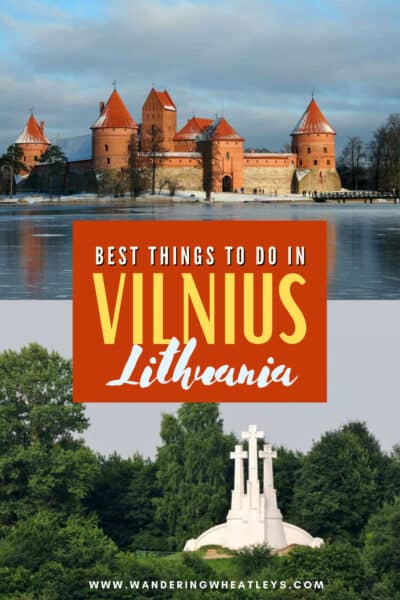
Hidden away on the Baltic edge of Europe, Vilnius is fast becoming a tourist hotspot in the continent’s northeast. The Lithuanian capital, with its petite population of 600,000, might pale in comparison to the size of other European cities, but don’t worry because there are almost too many things to do in Vilnius!
History is always top of the itinerary in Vilnius. The city dates back to at least the 13th century AD when it was founded by the earliest Lithuanian monarchs as a trading post and fortress on the confluence of the rivers Neris and Vilnia.
It soon became the capital of the Kingdom of Lithuania, then the Grand Duchy of Lithuania, and was one of the Polish-Lithuanian Commonwealth’s central cities for centuries (which in the 17th century was one of Europe’s largest empires).
Find out more with a tour of the Old Town, which is a tapestry of medieval architecture and baroque beauty. Visit the capital’s glorious Catholic churches, delve into the past at the Old and New Arsenals, and make the hike to Gediminas Tower, where you can look out across the city from one of its oldest structures.
Fill up on a food tour of Vilnius (have you ever tried a Zeppelin?), learn about the communist era at the Museum of Occupations and Freedom Fights, and then explore the quirkier side of the city with a walk around the self-declared Republic of Uzupis.
With so many things to see and do, you might not know where to begin. That’s why we’ve compiled our list of the absolute best things to do in Vilnius for you. Stick to these fun and unique Vilnius bucket list recommendations, and there’s no doubt you’ll have an amazing time exploring this beautiful Baltic capital!
Disclaimer: This post may contain affiliate links. If you make a purchase or booking through one of our links we may earn a small commission (don’t worry, it’s at no extra cost to you).
15 Fun and Unique Things to do in Vilnius
1. take a walking tour of the old town.
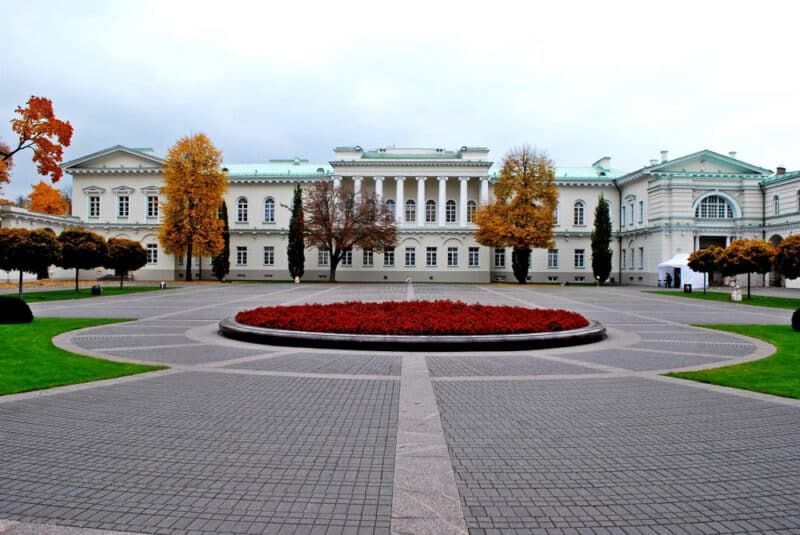
A walking tour is one of the best ways to introduce yourself to a new city, and there’s no better way to discover Vilnius’ Old Town than with a guided stroll.
The Old Town’s history dates back centuries, and with centuries-old buildings to match, it’s no real surprise that this historic part of Vilnius has been listed as a UNESCO World Heritage Site. A free walking tour starts from the Gediminas Monument in Cathedral Square every day at 10:30 am. It’s tips based, so you’ll only pay what you believe the tour was worth at the end of it.
You’ll start by learning about the city’s medieval origins, and you’ll see where the first inhabitants founded the earliest settlement in the area around Cathedral Square. You’ll visit the Presidential Palace, Town Hall Square, Vilnius University, and other important Vilnius attractions as you explore what is the largest old town in Northern Europe.
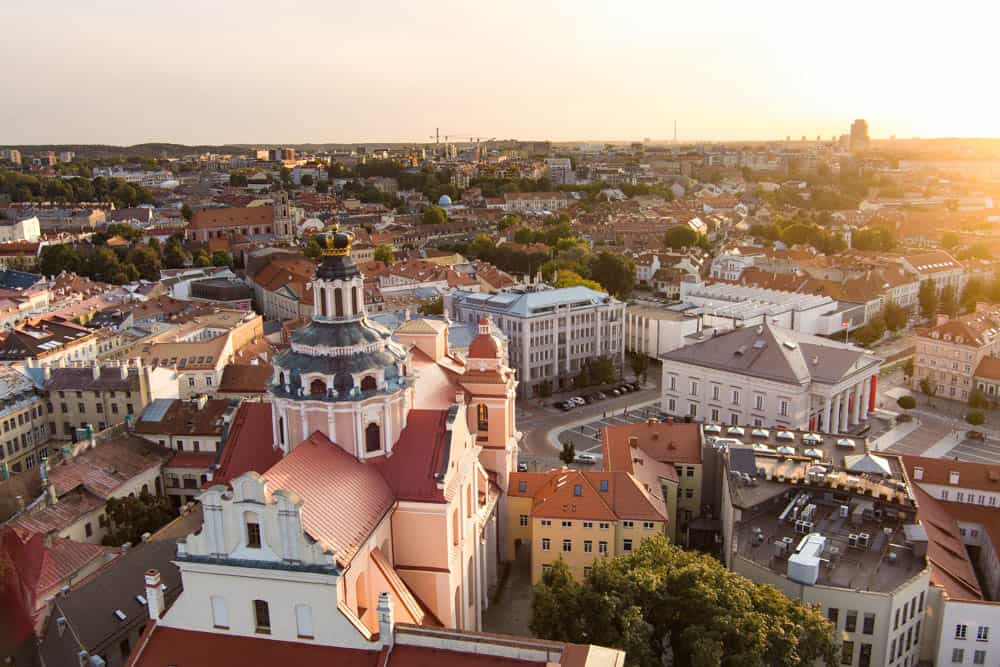
Along the way, you’ll hop into catholic and orthodox churches alike, you’ll be awed by the diversity of architectural styles – baroque, gothic, renaissance, and many more styles sweep through the Old Town – and you’ll even have a look inside Uzupis, the city’s most unusual district (more on that later!).
Wear comfortable shoes because you’ll be on your feet for at least 2.5 hours as you uncover the secrets of Vilnius’ gorgeous Old Town.
2. Take a Peek Inside Vilnius Cathedral
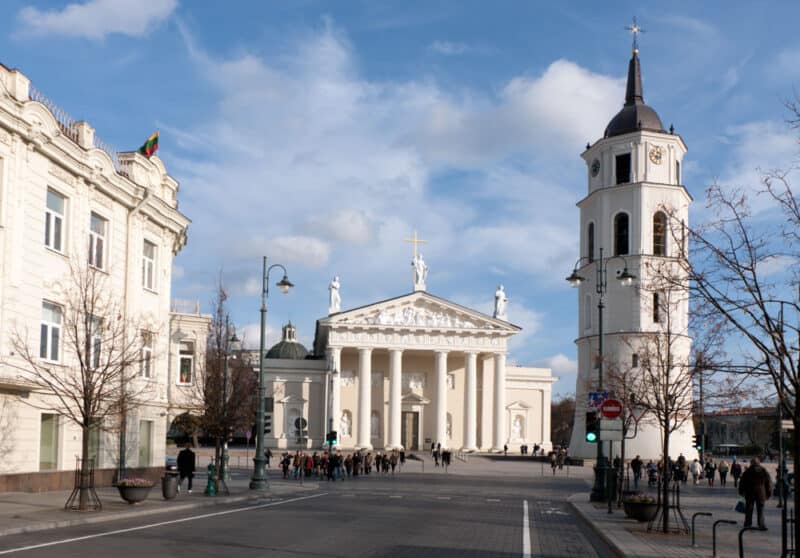
One of the best sights in Vilnius is the cathedral, so don’t forget to take a peek inside when you’re in the square. Vilnius Cathedral towers above Cathedral Square, and it’s one of the grandest, most beautiful, and most historic buildings in the city.
You’ll love the unorthodox neoclassical design. Tall Greco-Roman columns greet you as you walk up the steep steps leading to the grand entranceway. This is where the Grand Dukes of Lithuania were crowned in centuries past, and even decades of communist rule in the 20th century couldn’t stop locals from revering this religious icon.
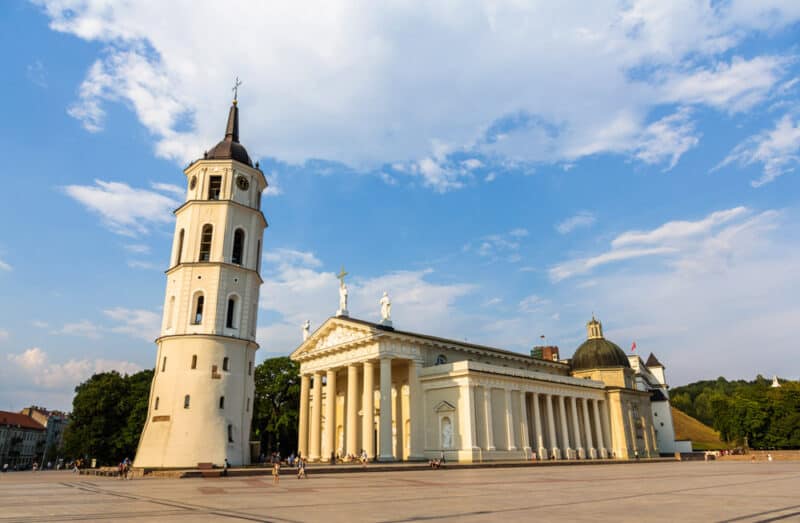
The history of Vilnius Cathedral is long. It’s thought that there was a pagan altar here centuries before Catholicism arrived in Lithuania, but from the 13th century onwards, it became the primary place of Christian worship in the region.
Many of Lithuania’s most famous dukes and royal characters have been buried here, and deep in the crypts lies the heart of Władysław IV (gruesome, we know). The extravagant architecture you see today was predominantly built from 1779 onwards, and it’s a lasting monument to the power and wealth of the Grand Duchy of Lithuania.
3. Stroll Through the Gate of Dawn
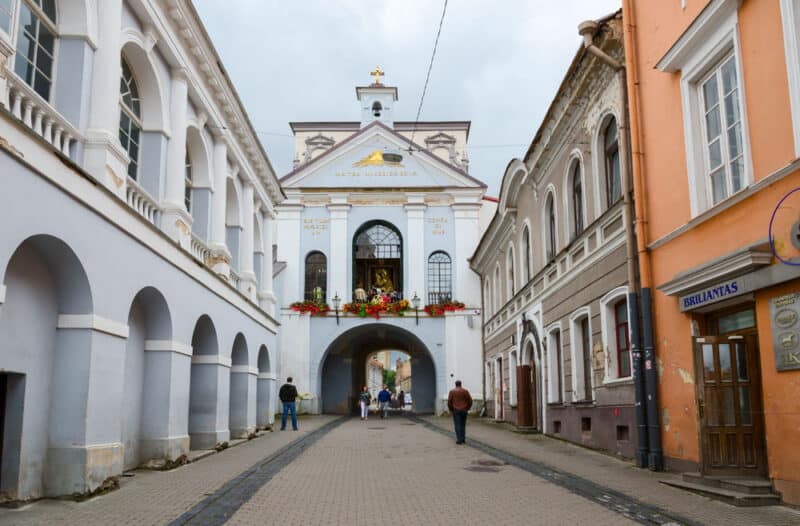
One of the most important things to see in Vilnius is the Gate of Dawn. You should see this historic site on a walking tour, but just in case you don’t, make sure to stroll under its beautiful archway later on.
The Gate of Dawn is one of the Old Town’s most iconic locations, and it has a long history dating back to the early 16th century. The gate itself was built as part of the city’s fortifications, and, of course, back then, it marked the entrance and exit to the Old Town.
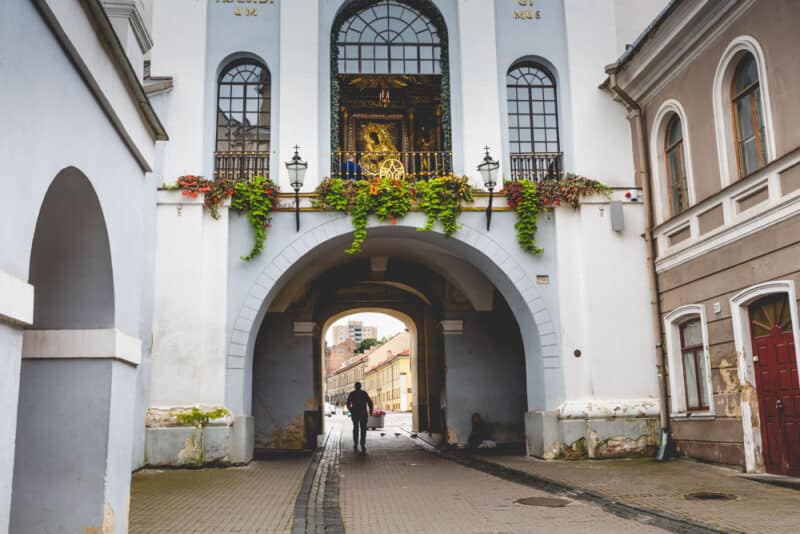
Religiously, it’s more important than this, though, and the Gate of Dawn is also home to a unique Catholic shrine. Look up as you walk under, and you’ll see the Icon of our Lady of the Gate of Dawn. Even today, the shrine draws pilgrims and worshippers on their way into Vilnius, and they’ll stop here before proceeding onwards to the chapels, churches, and the cathedral inside the capital.
4. Walk to the Top of Gediminas Tower
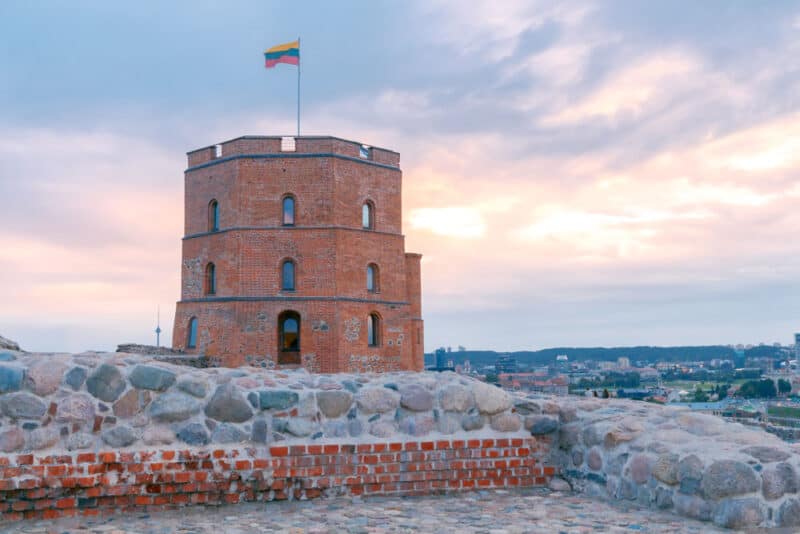
Look up toward the hill that rises above the banks of the Neris River, and you’ll spot a distinctive tower reaching to the heavens. This is Gediminas Tower, and the red brick bastion is all that really remains of Vilnius’ Upper Castle fortifications.
Gediminas Tower is one of the most important Vilnius attractions. It’s a symbol of the city’s history and identity, and you have to make the walk to the top to admire it up close. The original tower is said to have been built on the orders of Gediminas, a Grand Duke of Lithuania, in 1409.
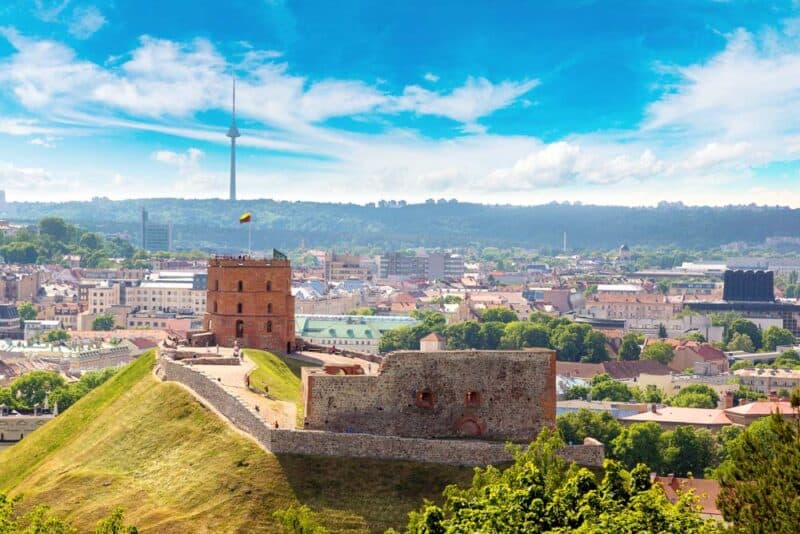
Local legends abound, and the popular story goes that the Duke spent a night on the hilltop after a hunting trip, where he dreamt of a wolf made of iron that howled madly into the darkness. After the dream, he built the tower, which then evolved into a larger castle that once overlooked Vilnius.
The castle was rebuilt in 1933, and then in 1988, the Lithuanian flag was raised from the rooftop when the nation declared its independence from the USSR. You can visit the museum inside the tower to learn more and see how it’s changed and evolved over the centuries.
5. Visit the Palace of the Grand Dukes of Lithuania
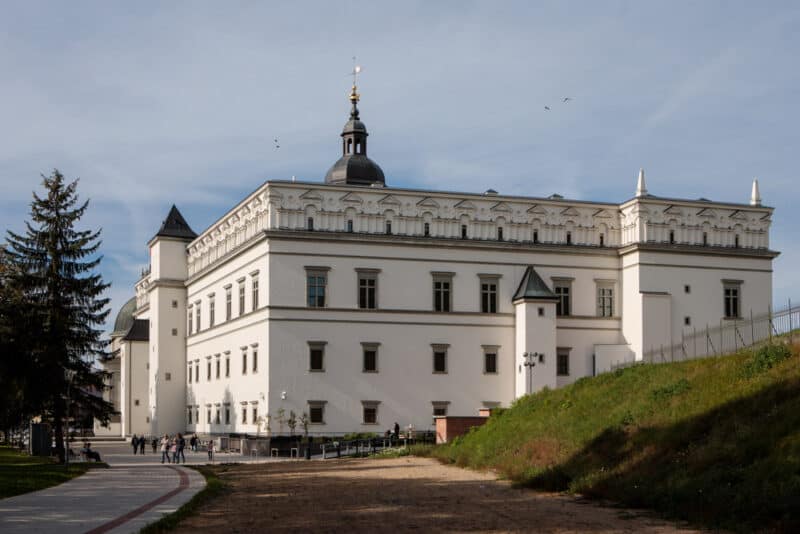
When you’re at the top of Gediminas Tower, look directly down, and you’ll see the elegant renaissance-style rooftops of the Palace of the Grand Dukes of Lithuania .
Okay, so this is one of the top things to do in Vilnius, but before you do pay the entrance fee (which is very reasonable), you should know that this is a replica. Unfortunately, the palace was destroyed in 1801, and its bricks were carted off by the Russian Empire to ensure no trace of the dukes remained in Vilnius.
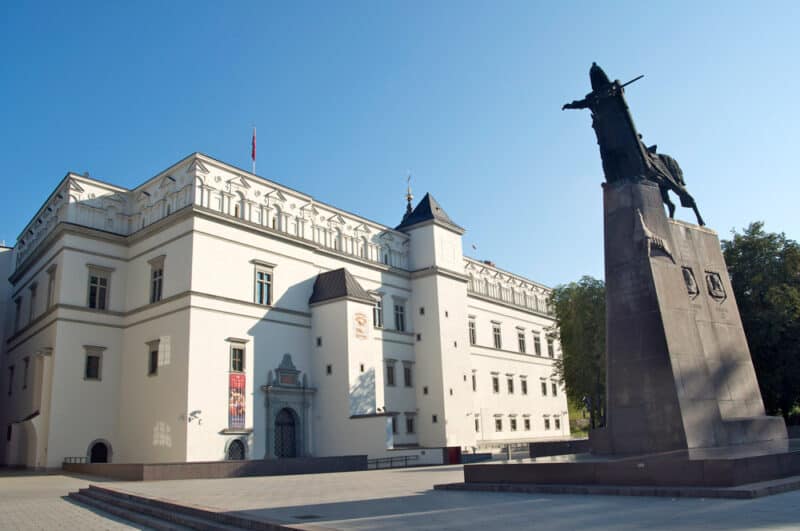
For the next two centuries, Lithuania fell under the yoke of Russia, and it wasn’t until independence that they began seriously thinking about bringing back what was once a symbol of national sovereignty. After years of planning and building disputes, the palace was painstakingly rebuilt in the 2000s and finally opened to the world in 2013.
Visit the Palace of the Grand Dukes of Lithuania during your trip to Vilnius, and you’ll learn all this and more. While the current building is a restoration, it’s just one more reincarnation of the palace going back to the 13th century.
The original was made from humble stone, designed to repel invaders, while later editions brought it into the renaissance and baroque styles that were popular in Vilnius in the 16th and 17th centuries.
6. Explore Lithuanian History at the Old Arsenal and New Arsenal
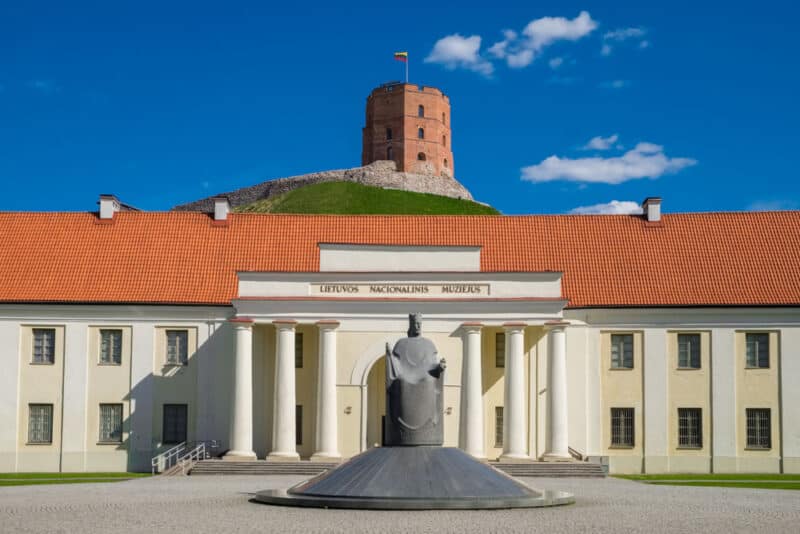
In the shadow of Gediminas Tower, you’ll find both the Old Arsenal and the New Arsenal. For history lovers, these two museums are two of the best sights in Vilnius, and you’ll have plenty to see if you’ve got time to explore both!
Both are operated by the National Museum of Lithuania, and they delve into different periods of history and culture. The Old Arsenal takes you back some 12,000 years to the dawn of humanity’s prehistory in Lithuania. There were people here long before the Grand Dukes of Lithuania made their mark on the land, and you’ll learn about millennia-old pagan rituals and stone age archeological finds.
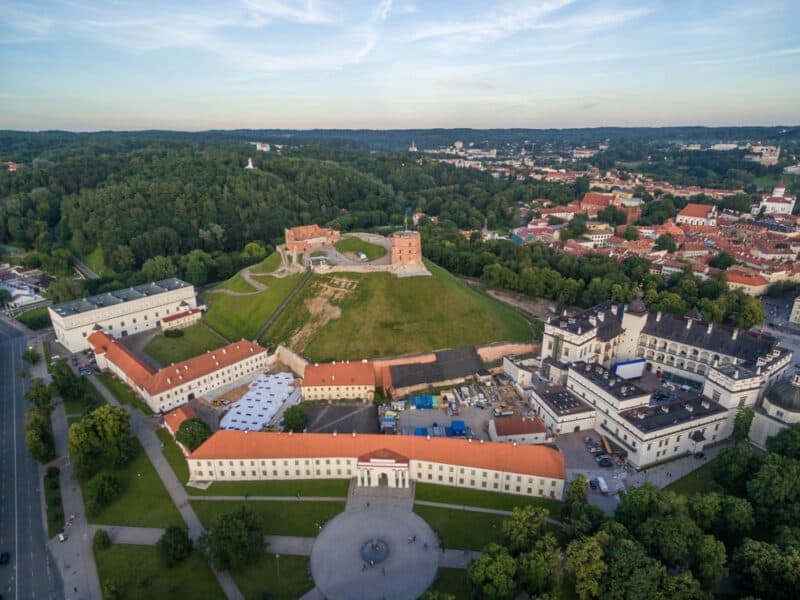
The New Arsenal is dedicated to (slightly) more recent history. Here you’ll find the Museum of Antiquities, which showcases a wonderful array of relics dating back as far as the 13th century when modern Lithuania began to take shape. The museum then moves through the centuries, offering a unique overview of Lithuanian history to modern times.
7. Hike to the Top of Three Crosses Hill
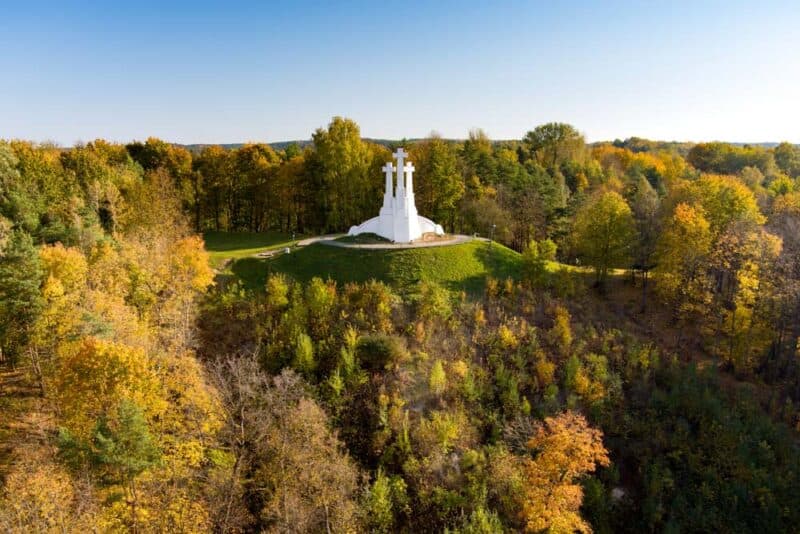
The skyline of Vilnius is defined by the hills that surround it, and there’s no more famous viewpoint than Three Crosses Hill. Located a 20-minute uphill walk from the Palace of the Grand Dukes of Lithuania, you’ll spot the enormous white crosses long before you reach the summit.
The crosses are said to have been here for centuries (in some shape or form), and legend has it that they mark the spot where early Lithuanian Christians preached the gospel before being beheaded by pagans. It’s a gruesome tale and one of many that abound in the surroundings of Vilnius. The current crosses were added more recently, though, and date back only to 1989.
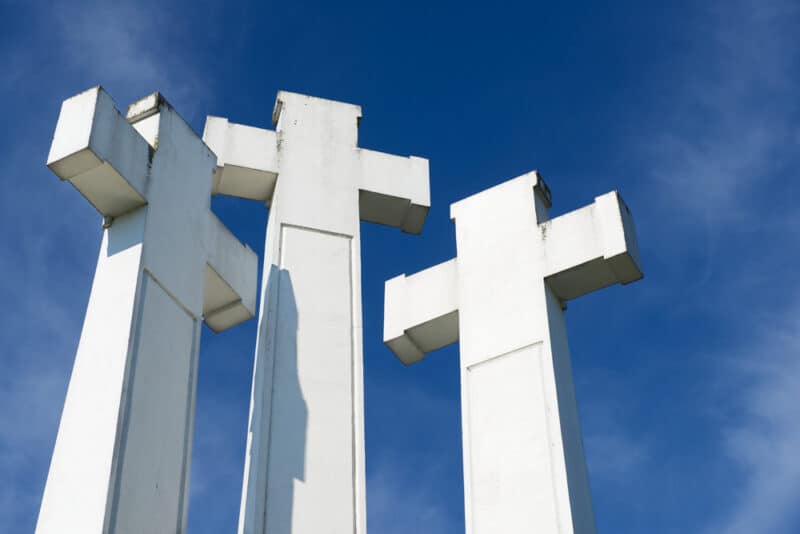
Take a hike to the summit, where on a misty morning, you’ll very much feel a part of Lithuania’s legendary history. Once the mist has cleared, you can admire the view stretching out ahead of you across the city, which we have to say is one of the best views you’ll have of Vilnius!
8. Learn about the KGB at the Museum of Occupations and Freedom Fights
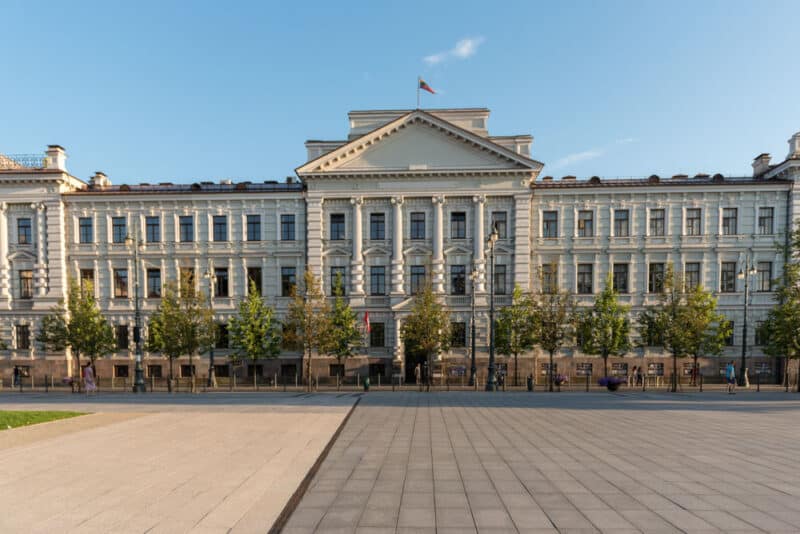
It’s hard to imagine now, but just over three decades ago, Lithuania was still part of the USSR. For much of the 20th century, Lithuanians were subject to surveillance, trials, imprisonment, and even execution at the hands of the infamous KGB, communist Russia’s secret police.
Following independence in 1991, many secrets began to surface as the KGB files were opened. At least 1,000 Lithuanians were executed in the basement of the KGB’s headquarters, which became a museum of remembrance and education in 1992.
The Museum of Occupations and Freedom Fights (generally shortened to the “KGB Museum”) is now located within the KGB prisons, and it’s one of the most moving things to do in Vilnius.
Learn how Lithuania spent a century under Imperial Russian control, followed by another century of communist control. Different exhibitions explore Lithuanian resistance to communist rule following World War II, while the most heartbreaking exhibit exposes the Holocaust that occurred here under Nazi occupation .
9. Have Some Optical Fun at the Museum of Illusions
If you’re looking for something a little more light-hearted during your stay in the city, then a visit to the Museum of Illusions is one of the top things to do in Vilnius.
This one is fun for everyone in the family, so don’t forget your camera if you want some quirky photos from one of the city’s coolest attractions. As the name suggests, this museum is all about the optical illusions, and you’ll be amazed by your change in perception as you make your way through the galleries.
Rooms are turned on their head at this museum, where you won’t quite know what’s real and what’s an illusion, and where’s up and where’s down. Optical tricks will amaze and confuse you in equal parts, as you struggle to work out how exactly your mind has been played!
10. Eat Your Way Around Vilnius on a Foodie Tour
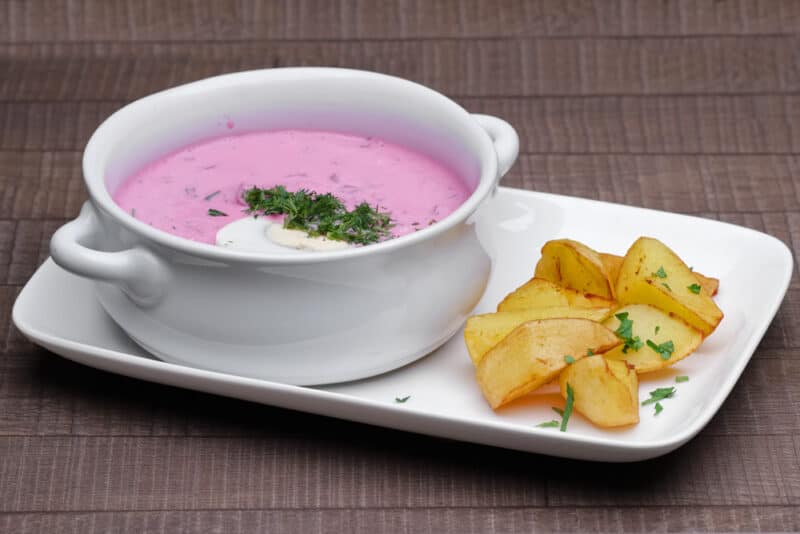
The Lithuanian capital is best known for its Old Town, and the food here is seriously overlooked. We recommend joining a foodie tour of the city to dig deep into the capital’s culinary prowess, and trust us when we say you won’t be disappointed.
You’ll be guided around the best local eateries, food shops, and bars in the city as you eat your way around Vilnius. You’re in the Baltics, of course, so you can expect this to be a carb-heavy day, but the cuisine here is so much more nuanced than potatoes.
On the menu today, you’ll be treated to local delights like Cold Beetroot Soup (it’s often bright pink, but always delicious), Potato Pancakes, and Kibinai (a type of meat and veg pasty). It’s typically said that the national dish of Lithuania is the Cepelinai (or the “Zeppelin”), a Zeppelin-shaped potato dumpling that’s packed with meat or veg fillings before being boiled or fried (or both!).
11. Escape the City with a Day Out in Vingis Park
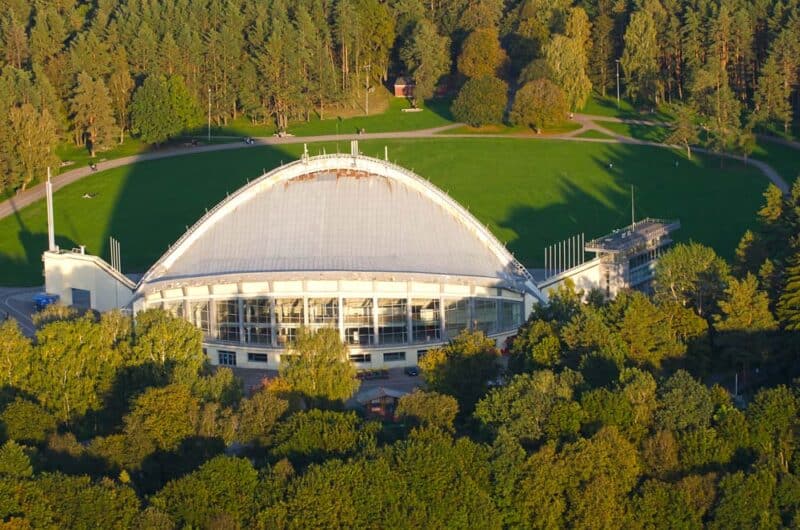
If you need a break from Vilnius, then you’re in luck because there’s a beautiful park on the outskirts of the city. Spend the day at Vingis Park, where 400 acres of gardens, forests, and event spaces await you, and you’ll leave revitalized and refreshed!
Vingis Park is one of the best outdoor attractions in Vilnius, and you’ll cross a wonderful pedestrian bridge spanning the River Neris to reach it from the city. When you cross over the river, you’ll find miles of hiking and biking trails just begging to be explored.
The park is also home to Vilnius’ amphitheater, which hosts everything from traditional midsummer celebrations to hard rock concerts. You can also pop into a section of the Botanical Garden of Vilnius University, where you’ll find a unique array of flora in a colorful, peaceful environment.
12. Cross the Border and Visit the Republic of Uzupis
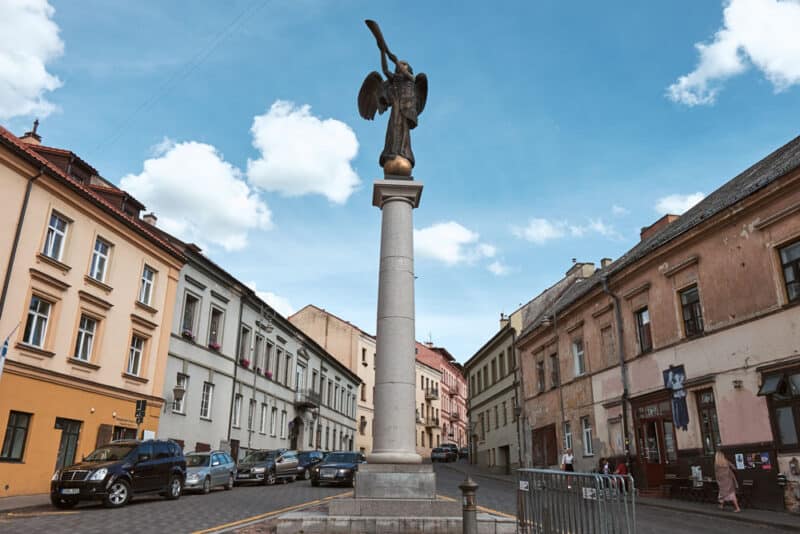
Crossing “the border” to visit the Republic of Uzupis is one of the most unique things to do in Vilnius. This self-declared “nation” became an “independent” republic following Lithuania’s independence from the Soviet Union, and the small suburb is now home to artists, bars, and dreamers.
The Republic of Uzupis is located across the River Neris in a section of the Old Town that was run down and largely abandoned in the 1990s. Then squatters and artists began to move in and slowly started building their own unorthodox communities.
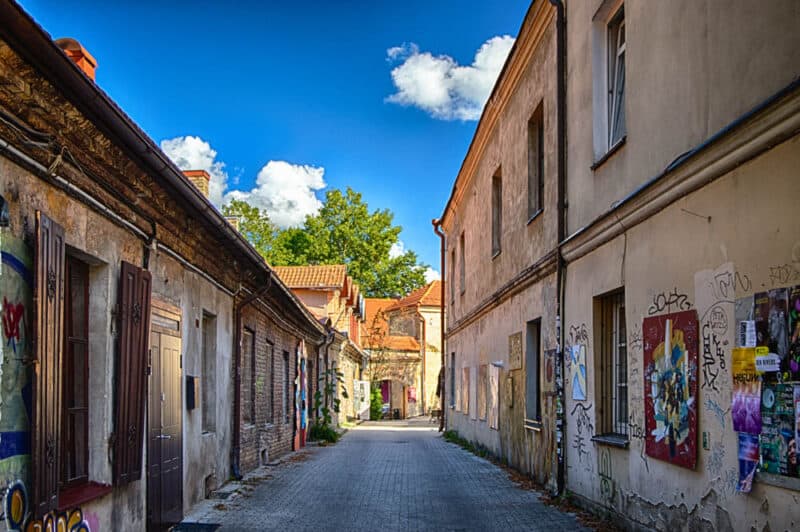
The community lives by the laws of the Constitution of Uzupis, which you’ll find in large writing by the main square (near the Uzupis Angel). The somewhat quirky constitution states that everyone has the right to be happy or unhappy, a dog has the right to be a dog, everyone may be independent, and everyone has the right to love, and much more.
Visit the art galleries (of which there are many), enjoy a craft beer or two, and then get your passport stamped at the visa office!
13. Take a Day Trip to the Stunning Lakeside of Trakai Castle
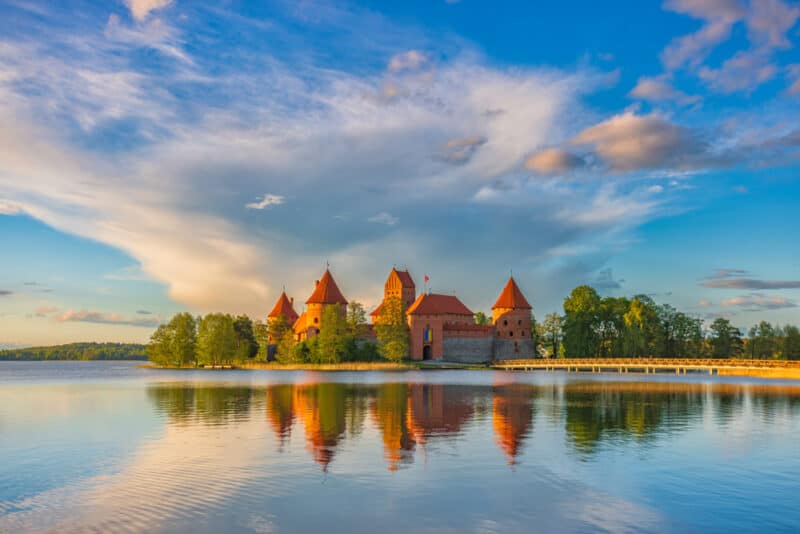
If you’ve still got time after ticking off the must-do things in Vilnius, then you can’t beat a good old-fashioned day trip. One of the best sights nearby is Trakai Castle, where a stunning castle is found in the middle of a serene lake.
You can hop on a train or take a bus to Trakai, which is an easy 40-minute drive away from the capital (less if the traffic is on your side!), then take a short stroll to the castle. A long causeway leads across Lake Galva to the gatehouse of Trakai Castle, which is entirely located on the island.
Tall trees rise above the walls, while the fairytale spirals of the towers reach upwards to the heavens. It’s quite the sight, and you can join a boat tour, hire a rowing boat, or just walk over the causeway to explore more. Construction began in the 14th century, and Trakai Castle became an integral defensive stronghold of the Grand Dukes of Lithuania.
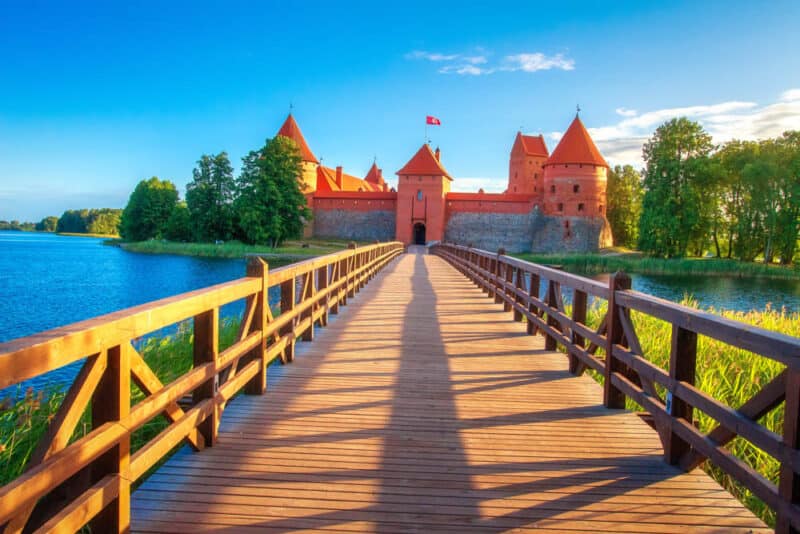
Despite its seemingly impregnable location, you’ll be surprised to learn that the castle was destroyed and fell into ruin. It was restored again following World War II and is now one of Lithuania’s most picturesque attractions.
After visiting the castle, you can hike around the lake, try a local Kibinai (a type of pastry packed with meat and veggies), or pop into the small museum that tells the unique story of the Karaim Jews who once called Trakai home.
Take a Tour to Trakain Castle
14. Have a Night Out in Vilnius
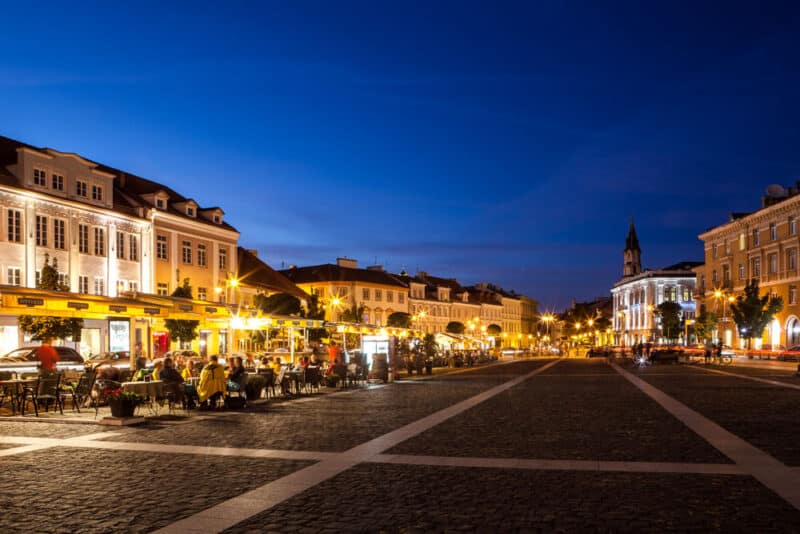
If you love exploring a city’s nightlife scene, then Vilnius has plenty to offer. This is one of the best nights out in Europe, and you can find parties, bars, and clubs almost any day of the week in the “Nightlife Triangle.”
The triangle is made up of three bar-heavy streets, which are Vilniaus Street, Islandijos Street, and Vokiečių Street. You could even join a bar or pub crawl to make a few friends and make sure you visit the best nightlife spots in the city.
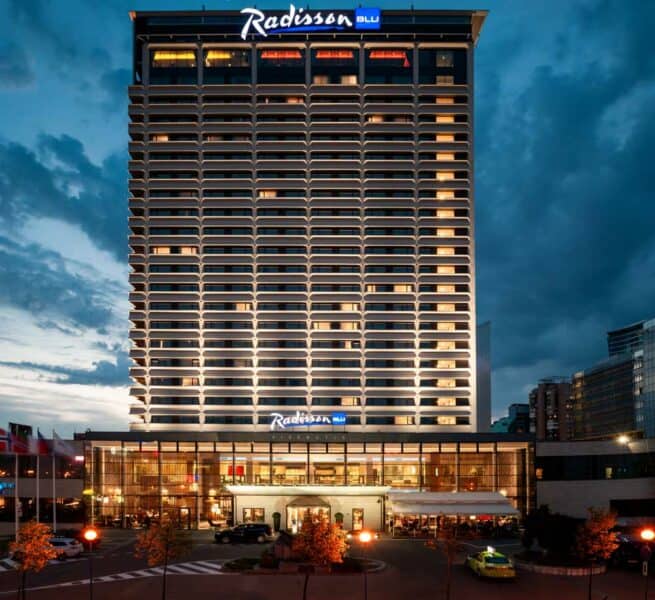
If you prefer a quiet night out, then we recommend taking the elevator to the 22nd floor of the Radisson Blu Hotel in Vilnius. This is one of the tallest buildings in the capital, and you can enjoy dinner and cocktails with one of the best panoramic views in Vilnius.
Book a Stay at Radisson Blue Hotel
15. Embrace the Festive Season at Vilnius Christmas Market
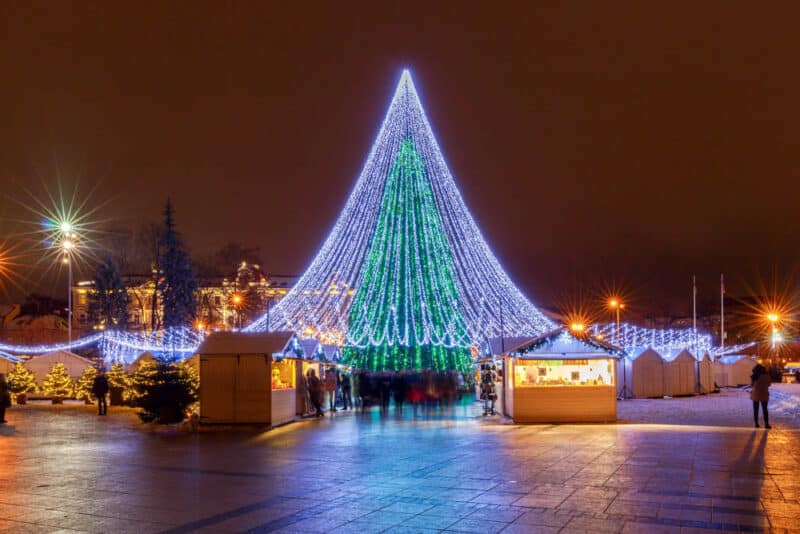
Lithuania is a cold, cold destination to visit in the winter, but brave the icy weather, and you can embrace the festive season at Vilnius Christmas Market.
The Old Town is lit brightly through the winter by festive lights, and the city’s Christmas trees tower high into the dark night sky. You’ll be tempted by roasted almonds, traditional gingerbread treats, and of course, mulled wine.
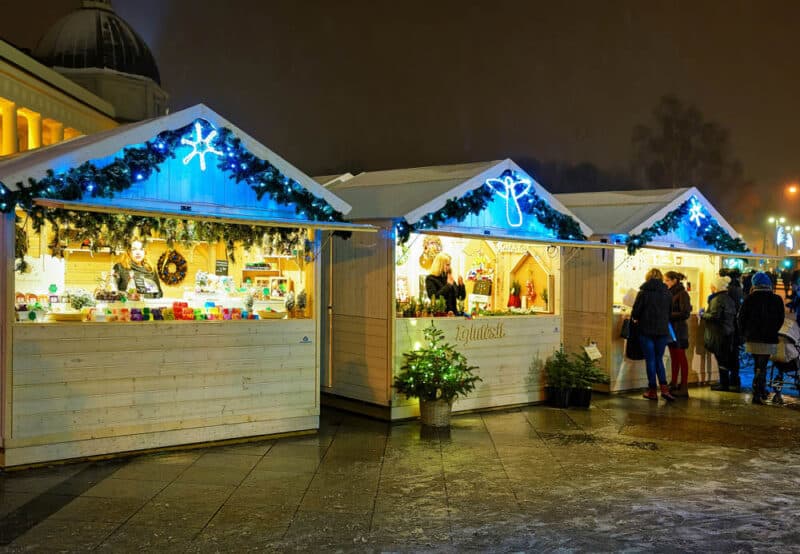
The largest markets take over Cathedral Square and Town Hall Square from the end of November to the start of January. Unlike the more commercial markets in many other European capitals, the markets in Vilnius still manage to stay small, local, and vibrant!
There you have it! The 15 best things to do in Vilnius. What’s your favorite thing to do in Vilnius?
Planning a trip to Lithuania? Check out our favorite books and travel guides!
SHARE THIS ON PINTEREST
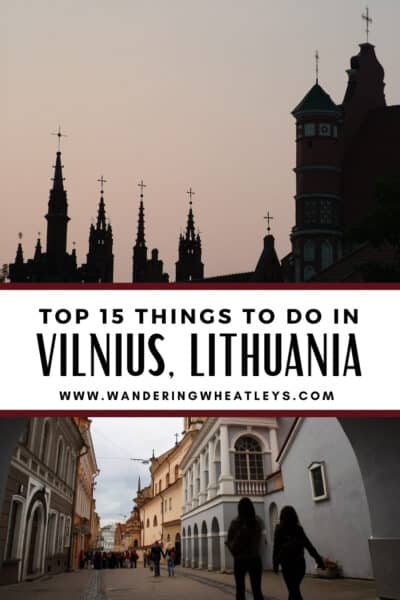
About the Author:

Richard is an award-winning travel writer based in Southwest England who’s addicted to traveling off the beaten track. He’s traveled to 75 countries and counting in search of intriguing stories, unusual destinations, and cultural curiosities. Richard loves traveling the long way round over land and sea, and you’ll find him visiting quirky micronations and breakaway territories as often as he’s found lounging on a beach (which is a lot). When he’s not writing for BBC Travel, National Geographic, or Lonely Planet, you can find Richard writing for the Wandering Wheatleys or updating his off-beat travel blog, Travel Tramp.
View all posts
Related Posts
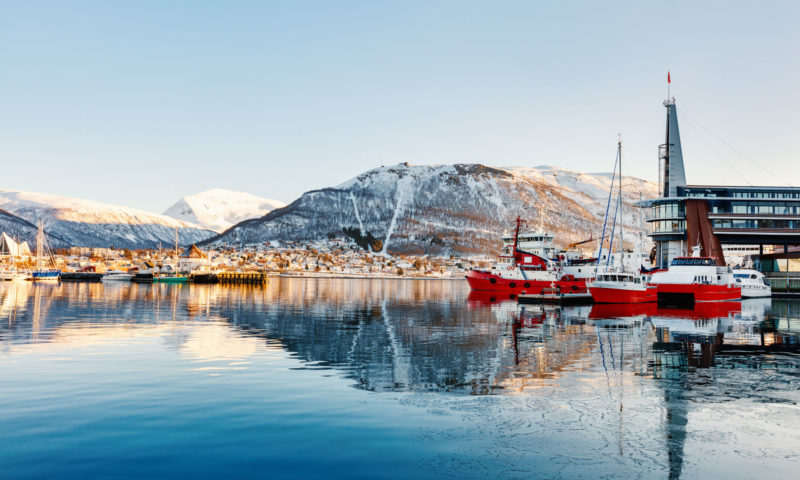
The 12 Best Hotels in Tromsø, Norway
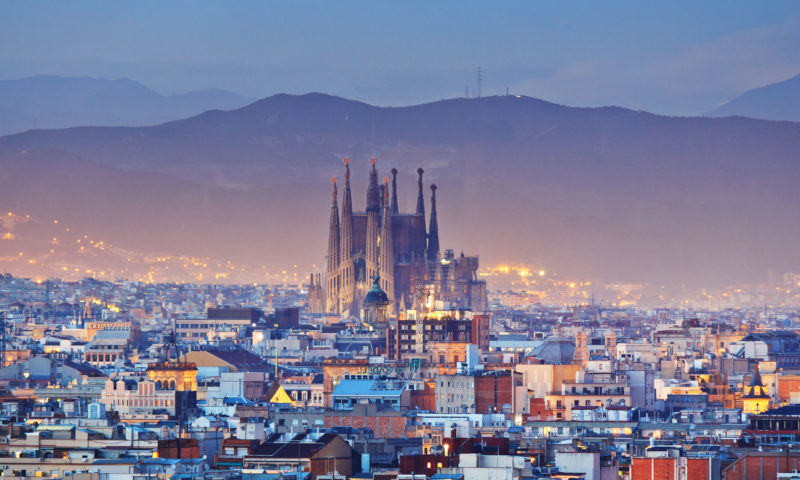
The 12 Best Boutique Hotels in Barcelona, Spain
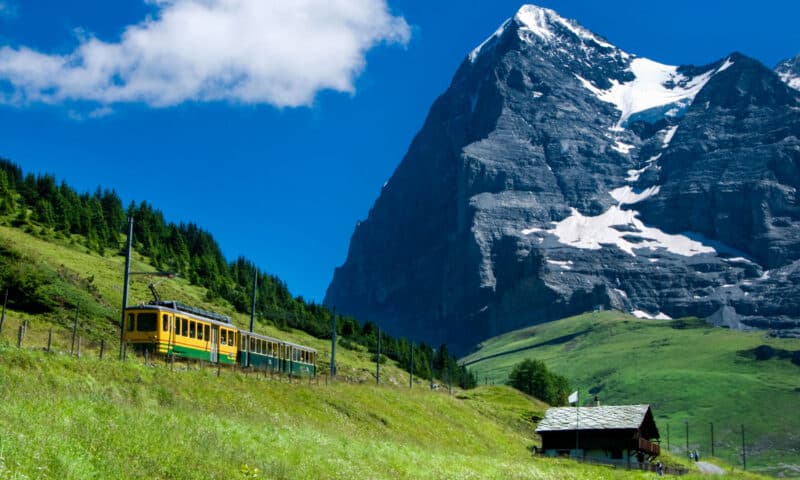
The 9 Best Places to Visit in Europe in Summer
Leave a comment cancel reply.
Your email address will not be published. Required fields are marked *
- Best time to visit Lithuania
Book your individual trip , stress-free with local travel experts
- roughguides.com
- Travel guide
- Local Experts
- Travel Advice
- Accommodation
Plan your tailor-made trip with a local expert
Book securely with money-back guarantee
Travel stress-free with local assistance and 24/7 support
The best time to visit Lithuania is late spring or summer, when there’s usually enough fine weather to allow you to stroll around the cities and make significant forays into the great outdoors. On the whole though, the only thing that’s predictable about the Baltic climate is the deep, dark winters – in all other seasons the weather can be changeable in the extreme.
Tailor-made travel itineraries for Lithuania, created by local experts

10 days / from 1043 USD
Sustainable Baltic Capitals
Enjoy introductory tours and ample free time to suit your interests. In ten days, relish local accommodations, UNESCO town walks, quirky neighborhoods, and private guide tours, delving into the region's history and customs. Start your Baltic States adventure now for independent exploration.

16 days / from 3959 USD
Ultimate Baltics
Uncover both renowned attractions and hidden gems across the Baltic States and Southern Finland. Explore UNESCO sites, serene villages, and sandy dunes. From the capital cities of Vilnius, Riga, Tallinn and Helsinki to the beaches in Klaipeda in Pärnu.

10 days / from 1659 USD
Baltic Highlights
Witness unspoiled landscapes and vibrant capitals. From Vilnius to Riga and Tallinn, move all the way up to Helsinki. Along the way, visit national parks like Laheema and castles like the Trakai castle. Private transfers and unique accommodation choices are included.
Summers are relatively short (roughly mid-June to late August), and although you may well experience a string of hot, dry days during this period, showers and chilly nights are equally likely. Remember to pack a waterproof jacket and warm sweater alongside your T-shirts.
Temperatures cool down rapidly from mid-September onwards, although autumn can be an extraordinarily beautiful season in which to visit, with the golden brown leaves of deciduous trees contrasting with the dark-green pines.
The first snowfalls can come as early as mid-November, and by early to mid-December winter sets in with a vengeance. Average daytime temperatures can remain below zero right through until March, plummeting to minus 15–20°C in particularly cold spells. Winter can of course be a magical time, with lakes, rivers and large expanses of the Baltic Sea freezing over, and crunchy snow cover adding an air of enchantment to medieval city centres. However, rural areas can be difficult to get to without a four-wheel-drive vehicle (only the main highways are showploughed), and you’ll have to be well togged up in order to endure anything but the shortest of walks. Wherever you are in winter, some form of hat or head covering is absolutely essential.
Even when the spring thaw sets in, the countryside can remain grey and barren until well into April (or even May in northern Estonia), when a sudden explosion of colour transforms the landscape. The countryside takes on a green lushness, drawing cattle and horses out from their winter barns, while city-dwellers indulge in a frenzied stampede for the pavement cafés.
The Rough Guides to Lithuania and related travel guides
In-depth, easy-to-use travel guides filled with expert advice.

Travel advice for Lithuania
From travel safety to visa requirements, discover the best tips for traveling to Lithuania
- Culture and Etiquette in Lithuania
- Eating and drinking in Lithuania
- Getting around Lithuania: Transportation Tips
- How to get to Lithuania
- Sports and Outdoor activities in Lithuania
Find even more inspiration here

- Travel Tips
written by Rough Guides Editors
updated 26.04.2021
Ready to travel and discover Lithuania?
Get support from our local experts for stress-free planning & worry-free travels.
- Where to stay
- Travel advice

IMAGES
VIDEO
COMMENTS
Let's explore the best places to visit in Lithuania: 1. Vilnius. Source: flickr. Vilnus, Lithuania. The historic capital of the Grand Duchy is a veritable treasure trove of medieval wonders and gorgeous Gothic come Russo-flavoured Baroque architecture.
4. Lukiškės Prison 2.0. Lukiškės prison 2.0 is probably one of the most interesting cultural phenomena in Lithuania. The former prison is transforming into a hub for music, modern art, design and culture. Live music concerts, performances, exhibitions, guided tours, bars, food trucks are waiting for you everyday.
These are the best things to do in Lithuania: 1. Sand Dunes of the Curonian Spit. I want to start this list with my personal favorite place in Lithuania - sand dunes of the Curonian Spit.This is a place where I spent countless summers as a child, a place that I took my husband to when he first visited Lithuania, and a place that I recommend to every tourist traveling to Lithuania.
KGB Museum (Genocido Auku Muziejus) 3,372. Speciality Museums. By lahdenpera. Housing the Nazi occupants during WW2, and the Soviet KGB directly after, and up until 1989, this building has sealed…. See ways to experience (8) 2023. 3. Trakai Island Castle Museum.
Top 10 Glamping Spots In Lithuania - Updated 2024. 1. Kernave (from USD 138.0) Show all photos. Kernavė is a town in Southeast Lithuania with a beautiful landscape and renowned historic sites among many other attractions. There is no better place to experience the beauty of this region than at the Hillforts of Kernave.
Latvia. Discover the best attractions in Lithuania including Hill of Crosses, Palace of the Grand Dukes of Lithuania, and Vilnius Cathedral.
8. Kaunas Castle & Old Town. Among the top things to do in Lithuania, a visit to Kaunas is a must. Located 98km west of Vilnius and easily accessible by bus or rail, Kaunas is considered by many Lithuanians as the true heart of their country, serving as Lithuania's second city.
9. Visit the Palace of the Grand Duke of Lithuania. Another piece of ancient architecture that should be on your list of what to see in Lithuania is the Palace of the Grand Duke of Lithuania. The palace is part of the Vilnius Castle Grounds, along with the remains of Vilnius Castle and Gediminas' Tower.
Europe. Blame it on the Baltic sea breeze or the almost-endless midsummer days: Lithuania has an otherworldly quality. In the southernmost of the Baltic states, beaches are spangled with amber and woodlands are alive with demonic statues. Medieval-style mead and traditional wood-carving never went out of style.
The combination of culture and nature makes Neringa one of the most beautiful places in Lithuania. 6. Trakai. The historic city and lake resort of Trakai is a popular tourist destination in Lithuania. It has an interesting multicultural history, as communities of Lithuanians, Russian, Poles, and Jews made a home here.
Palanga: 8 8. Aukštaitija National Park: 9 9. Dzūkija National Park: 10 10 Rumsiskes Open-Air Museum: 5/5 - 1 vote for this destination. Lithuania, nestled in the Baltic region of Northern Europe, is a country rich in cultural heritage, historical landmarks, and stunning natural landscapes. From its vibrant capital to its serene countryside ...
The best 10 places to visit in Lithuania. 1. Curonian Spit (Kuršių Nerija) Let's start with my absolute favorite and the most beautiful natural must-visit place in Lithuania- a UNESCO-listed natural wonder called Curonian Spit (Kuršių Nerija in Lithuanian). It is like the desert of Lithuania half of which is covered in forests.
Trakai Castle. Visit the stunning Trakai Island Castle in Lithuania, a fairy-tale like fortress that is a must-see destination in both winter and summer. Located on a beautiful lake, the castle is surrounded by a charming small town called Trakai. There are three lakes surrounding the castle and town, Lake Galvė, Lake Luka, and Lake Bernardas.
What are the best places to visit in Lithuania? Vilnius. Vilnius Lithuania is often considered the baroque beauty in the Baltic.It is a city that has tremendous alluring power and draws tourists like a moth to the flame, driven by a natural, confident charm and a distinct warmth and golden glow that make the mind long for midsummer evenings throughout the year.
2. See the Hill of Witches. The Hill of Witches is an outdoor sculpture trail of wooden folk art in Juodkrante, a small town on the Curonian Spit. This art installation brings the forest to life with its creations, taking visitors on a trip through Lithuania's most popular folk tales and legends.
10. The Gate of Dawn. One of the best things to do in Vilnius is to visit The Gate of Dawn. It's a symbol of the city's faith and resilience. Built in the 16th century as a part of the city's defensive walls, it's the only gate that remains out of the original nine.
3. Neringa resort town (Curonian Spit) Neringa Resort City. It's hard to imagine the sights of Lithuania without Neringa Resort City. This rather young tourist corner of the country is especially recommended by guides when answering the question of what to visit in Lithuania in the first place.
The best time to visit Lithuania as a tourist depends on your preferences and the experiences you seek, as each season offers its unique charm. Summer (June to August): Summer is the peak tourist season, characterized by mild temperatures, longer daylight hours, and vibrant green landscapes.
TonyResort (under $100 USD a night) Radisson Hotel Kaunas (rated highly) Argo Trakai (stunning waterside views) ☂️ Top tours and experiences in Lithuania. From Vilnius - Trakai Tour With Audio Guide (likely to sell out) Vilnius - Half-Day Sightseeing Tour to Trakai (likely to sell out)
2. Take a Peek Inside Vilnius Cathedral. One of the best sights in Vilnius is the cathedral, so don't forget to take a peek inside when you're in the square. Vilnius Cathedral towers above Cathedral Square, and it's one of the grandest, most beautiful, and most historic buildings in the city.
Best time to visit Lithuania; The Rough Guides to Lithuania and related travel guides. In-depth, easy-to-use travel guides filled with expert advice. Buy US$34.99. Buy US$29.99. Buy US$34.99. Find even more inspiration here. 10 best winter destinations in Eastern Europe.
How to visit the Curonian Spit and Hill of Witches. The best way to get to the Curonian Spit, which is about 250 miles from Lithuania's capital city, Vilnius, is to rent a car at around 30 euros ...
The best time to visit Lithuania is late spring or summer, when there's usually enough fine weather to allow you to stroll around the cities and make significant forays into the great outdoors. On the whole though, the only thing that's predictable about the Baltic climate is the deep, dark winters - in all other seasons the weather can ...